Explore Prayagraj Maha Kumbh Mela 2025: A Complete Guide, Dates, Key Events & Rituals, Accommodation Options, Contact Information, Essential Tips | Triveni Sangam in Prayagraj: The Sacred Confluence of Ganga, Yamuna, and Saraswati | History, Timings, Boat Tours, Places to Visit Around Triveni Sangam, Maha Kumbh Mela 2025 Dates, and Travel Guide (Updated)
– most important pilgrimage sites for performing rituals & cleansing sins for spiritual rejuvenation
Prayagraj Maha Kumbh Mela 2025: A Complete Guide
The Prayagraj Maha Kumbh Mela 2025 is a once-in-12-years grand spiritual congregation that draws millions of pilgrims, devotees, and visitors from all corners of the globe. Renowned as the largest human gathering in the world, the Kumbh Mela is deeply rooted in Indian culture and spirituality, offering a mesmerizing experience of devotion, tradition, and cultural richness. This guide provides everything you need to know to make the most of your visit to the Prayagraj Maha Kumbh Mela 2025.
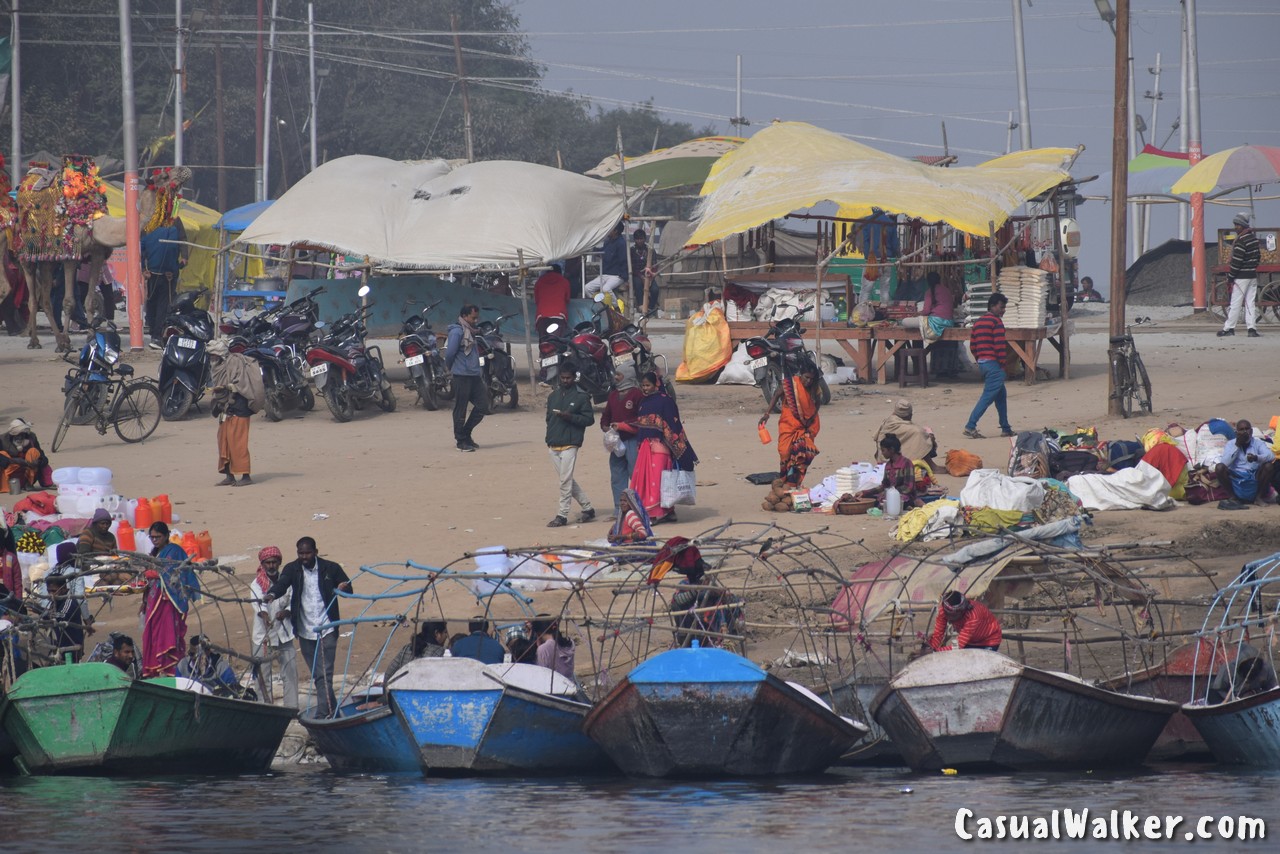
Overview of Kumbh Mela
The Kumbh Mela is celebrated at four sacred locations in India: Prayagraj (Allahabad), Haridwar, Ujjain, and Nashik, on a rotational basis. Prayagraj holds a special significance as it is the site of the Triveni Sangam – the confluence of three sacred rivers: Ganga, Yamuna, and the mythical Saraswati. The Maha Kumbh Mela is considered the holiest among all Kumbh Melas and occurs every 12 years.
Key Highlights of Prayagraj Maha Kumbh Mela 2025:
– Dates: January 13, 2025, to March 12, 2025
– Main Venue: Triveni Sangam, Prayagraj
– Significance: A holy dip in the Sangam during the auspicious dates is believed to cleanse sins and lead to Moksha (salvation).
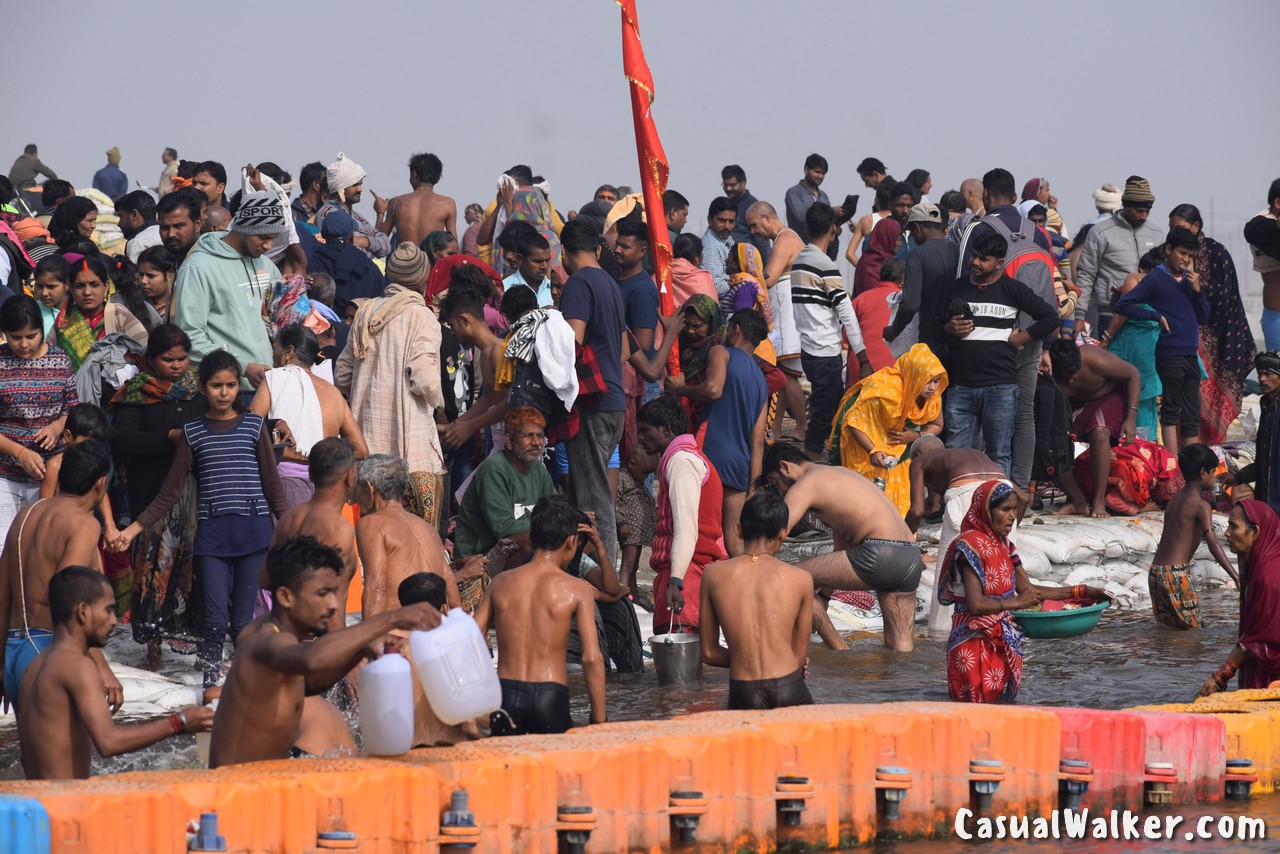
The Legend Behind Kumbh Mela
The origins of the Kumbh Mela are rooted in Hindu mythology. According to the legend, during the churning of the ocean (Samudra Manthan) by gods and demons, the nectar of immortality (Amrit) emerged. A fierce battle ensued, and during this tussle, drops of Amrit fell at four locations: Prayagraj, Haridwar, Ujjain, and Nashik. These places became sacred, and the Kumbh Mela celebrates this divine event.
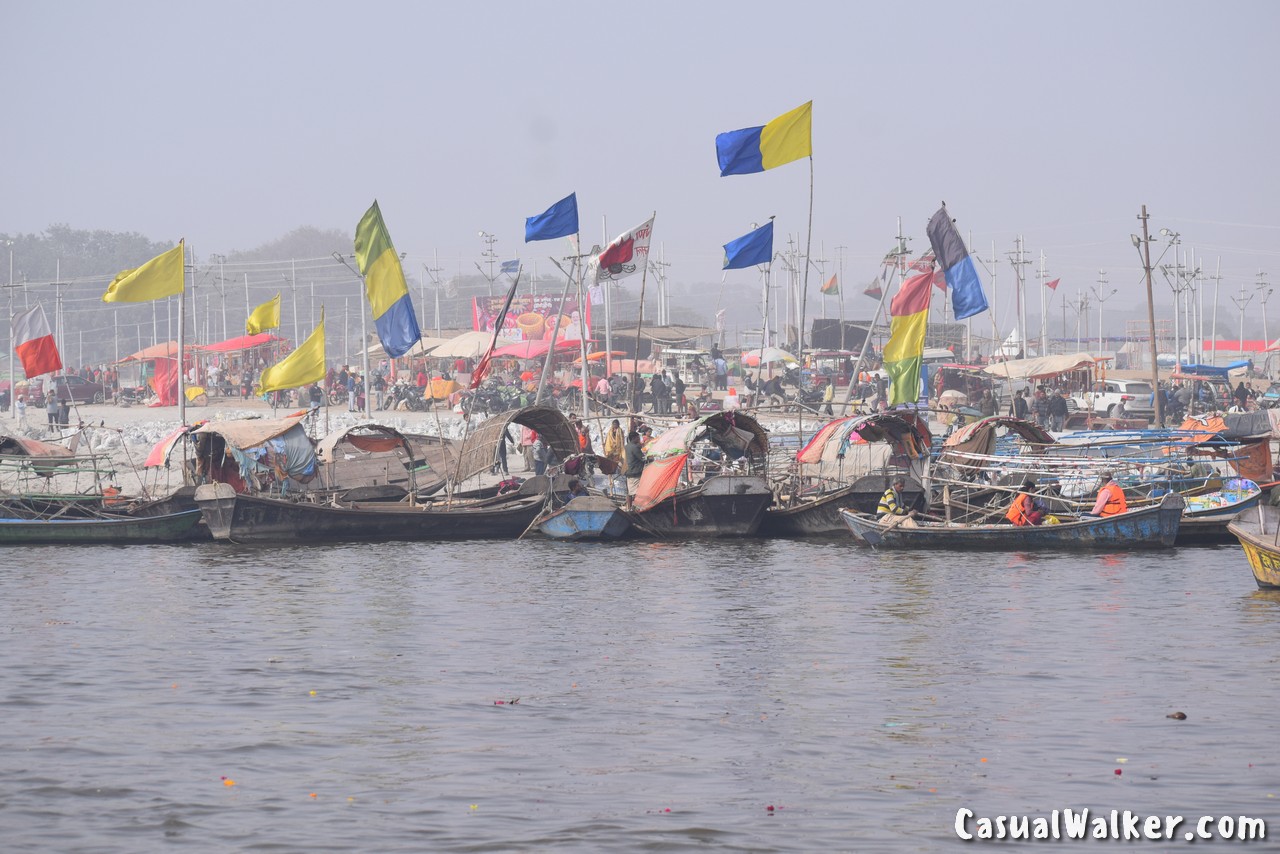
Key Events and Rituals
1. Shahi Snan (Royal Bath):
The Shahi Snan is the most important ritual of the Kumbh Mela, where Akharas (monastic groups) led by Naga Sadhus take a ceremonial dip in the Sangam.
2. Peshwai Procession:
A grand procession marks the arrival of saints and sadhus, showcasing vibrant cultural displays and devotional fervor.
3. Religious Discourses and Bhajans:
Spiritual leaders and gurus conduct discourses, spreading messages of peace, spirituality, and harmony.
4. Cultural Events:
Folk dances, music, and art exhibitions celebrate India’s rich heritage.
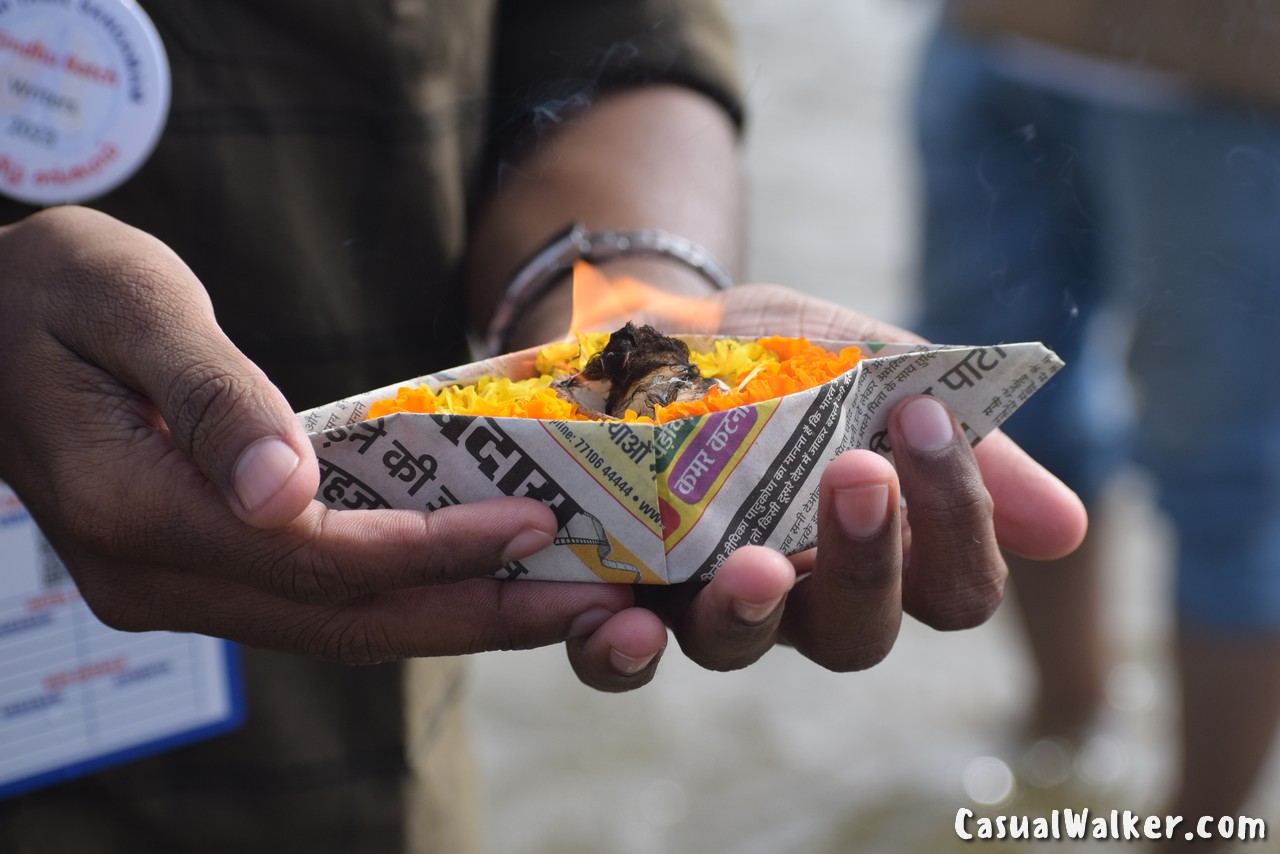
Auspicious Bathing Dates
Planning your visit around the auspicious dates ensures you witness the most significant rituals. The main bathing dates for Prayagraj Maha Kumbh Mela 2025 are:
– January 14: Makar Sankranti (First Shahi Snan)
– January 29: Paush Purnima
– February 9: Mauni Amavasya (Main Royal Bath)
– February 19: Basant Panchami
– February 24: Maghi Purnima
– March 11: Mahashivratri (Concluding Bath)
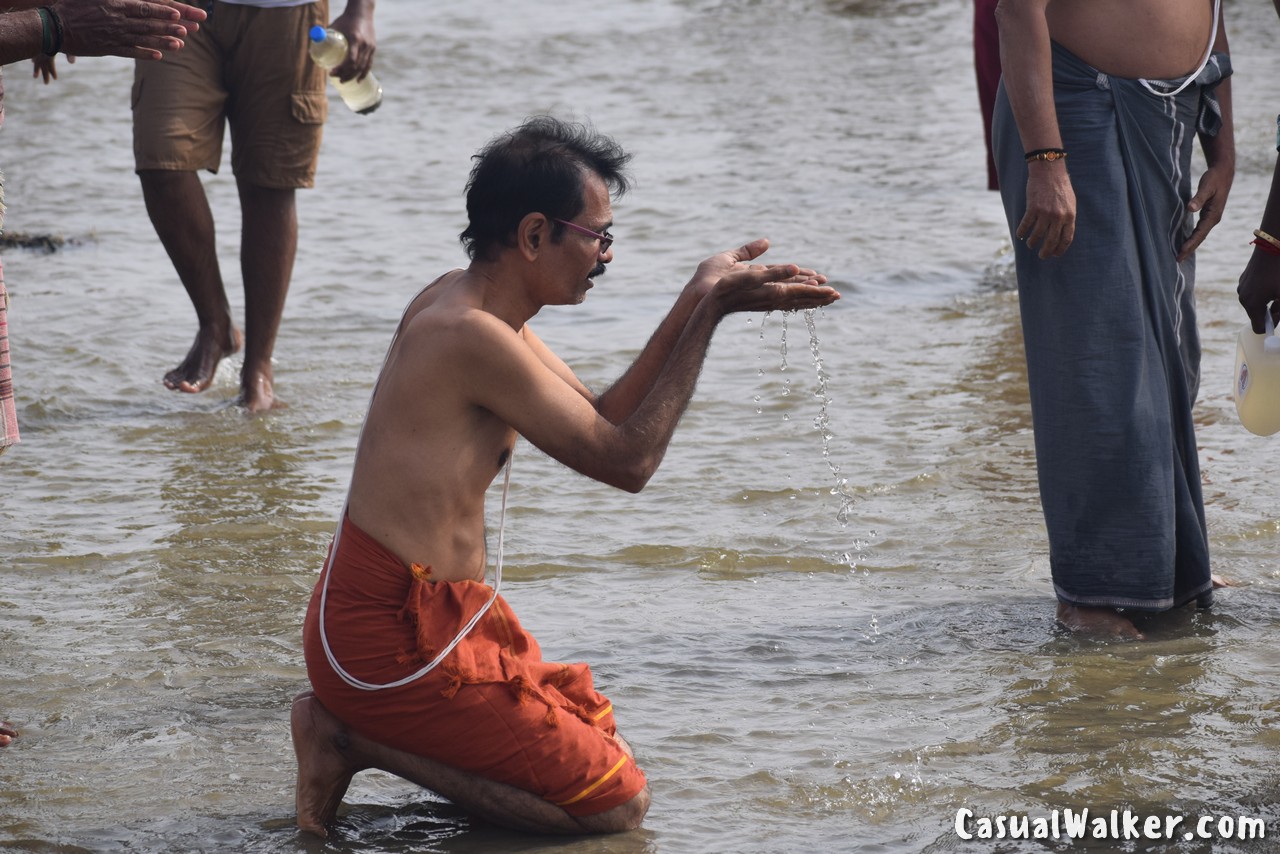
How to Reach Prayagraj
By Air: Prayagraj Airport (Bamrauli) connects to major cities like Delhi, Mumbai, and Bengaluru. Varanasi Airport (120 km away) and Lucknow Airport (200 km away) are also nearby options.
By Train: Prayagraj Junction is a major railway hub with excellent connectivity to all parts of India.
By Road: Well-connected highways link Prayagraj to neighboring cities like Varanasi, Lucknow, and Kanpur.
Local Transport:
– Buses and Auto-Rickshaws: The city operates frequent buses and auto-rickshaws for easy commuting within the city.
– E-Rickshaws: Eco-friendly e-rickshaws are available around the Kumbh Mela site.
– Boats: For reaching the Sangam, boat rides are the most popular option.
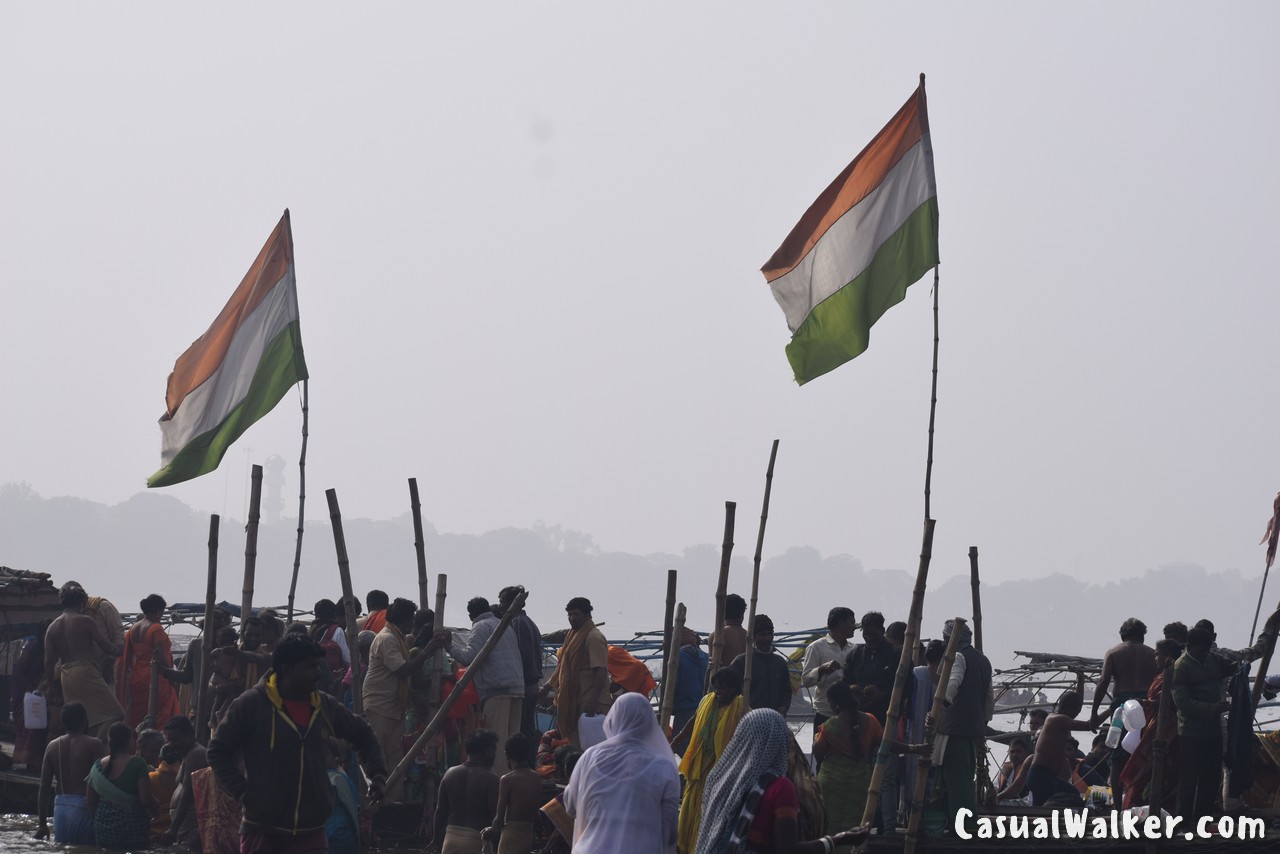
Accommodation Options
The city offers a range of accommodation options to suit all budgets. However, it is advisable to book well in advance due to the massive influx of visitors during the Kumbh Mela.
1. Tent Cities: Luxury and economy tents are set up near the Mela grounds for an immersive experience.
2. Hotels and Guesthouses: Various options are available within the city, catering to diverse needs. Popular hotels include:
– Hotel Kanha Shyam (4-star hotel, central Prayagraj)
– Grand Continental Hotel (3-star hotel, close to the Mela grounds)
– Hotel Polo Max (budget-friendly, near the railway station)
3. Ashrams and Dharmshalas: Ideal for budget travelers and those seeking a spiritual ambiance.
Contact Information for Accommodation Booking:
– Uttar Pradesh Tourism: +91-522-2617002 / 2617003
– Prayagraj Tourist Information Center: +91-532-2400509
Things to Do at Prayagraj Maha Kumbh Mela 2025
1. Take a Holy Dip: Purify your soul by taking a dip at the Triveni Sangam.
2. Visit Akharas: Interact with sadhus and saints to learn about their spiritual practices.
3. Explore the Mela: Experience the vibrant bazaars, food stalls, and cultural performances.
4. Boat Ride at Sangam: Enjoy a serene boat ride to witness the confluence of rivers.
5. Local Attractions: Visit iconic landmarks such as Anand Bhavan, Allahabad Fort, and Khusro Bagh.
Essential Tips for Visitors
– Plan Ahead: Book your accommodation and travel tickets early.
– Pack Wisely: Carry warm clothing, comfortable footwear, and basic toiletries.
– Stay Safe: Stick to designated bathing areas and follow safety guidelines.
– Respect Local Customs: Dress modestly and be mindful of cultural practices.
– Stay Hydrated and Eat Healthy: Drink bottled water and consume hygienic food.
Maha Kumbh Mela and Sustainability
The Prayagraj administration is focusing on eco-friendly practices to ensure a sustainable event. Measures include waste management, clean energy usage, and awareness campaigns for maintaining the sanctity of the rivers.
Tourism and Emergency Contacts
– UP Tourism Helpline: 1800-180-5310 (Toll-Free)
– Prayagraj Police Helpline: 100 or 112
– Medical Assistance: +91-532-2641022
– Railway Enquiry: 139
– Bus Enquiry: +91-532-2427258
Triveni Sangam
The Triveni Sangam, located in the ancient city of Prayagraj (Allahabad), Uttar Pradesh, is one of India’s most revered and sacred sites. This confluence is the meeting point of three rivers: the Ganga (Ganges), the Yamuna, and the Saraswati. The spiritual significance of this site has drawn pilgrims for centuries, with its roots deeply embedded in Hindu mythology and tradition.

The Rivers of the Sangam
Ganga (Ganges)
The Ganga is not just a river; it is a symbol of purity and a lifeline for millions in India. Originating from the Gangotri Glacier in the Himalayas, the Ganga travels over 2,500 kilometers through the plains of Northern India, providing water, sustenance, and spiritual solace to millions. The river is revered as the goddess Ganga and has descended to Earth to purify the ashes of King Bhagiratha’s ancestors, thus liberating their souls. This divine descent makes the waters of the Ganga sacred, capable of washing away sins and granting Moksha, or liberation from the cycle of life and death.
Maha Kumbh Mela 2025 Dates
The Maha Kumbh Mela is held every 12 years at the Triveni Sangam, with the last one occurring in 2013. In 2019, the Ardh (Half) Kumbh Mela was held there. The next Maha Kumbh Mela will take place from January 14th, 2025, to February 26th, 2025.
Maha Kumbh Mela Bathing/Snan Dates 2025
13 January 2025 Paush Poornima
14 January 2025 Makar Sankranti
29 January 2025 Mauni Amavasya
3 February 2025 Basant Panchami
4 February 2025 Achla Saptami
12 February 2025 Maghi Purnima
26 February 2025 Maha Shivratri
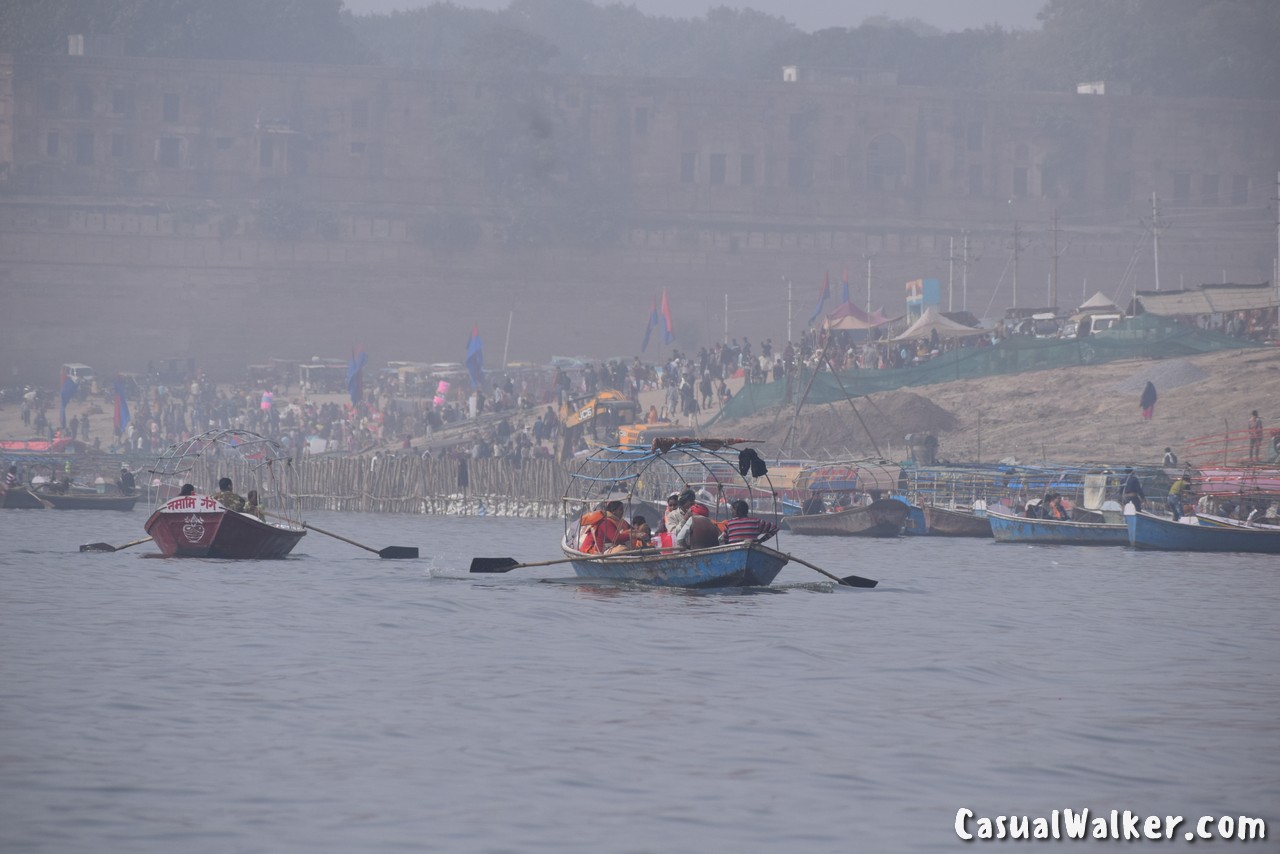
Yamuna
The Yamuna, another sacred river, originates from the Yamunotri Glacier in the Himalayas. Flowing parallel to the Ganga, the Yamuna is equally significant in Hindu lore. The river is associated with Lord Krishna, who is said to have played on its banks in his youth. The Yamuna’s waters are considered purifying, and it hold a special place in the hearts of devotees who celebrate Krishna’s life and teachings.
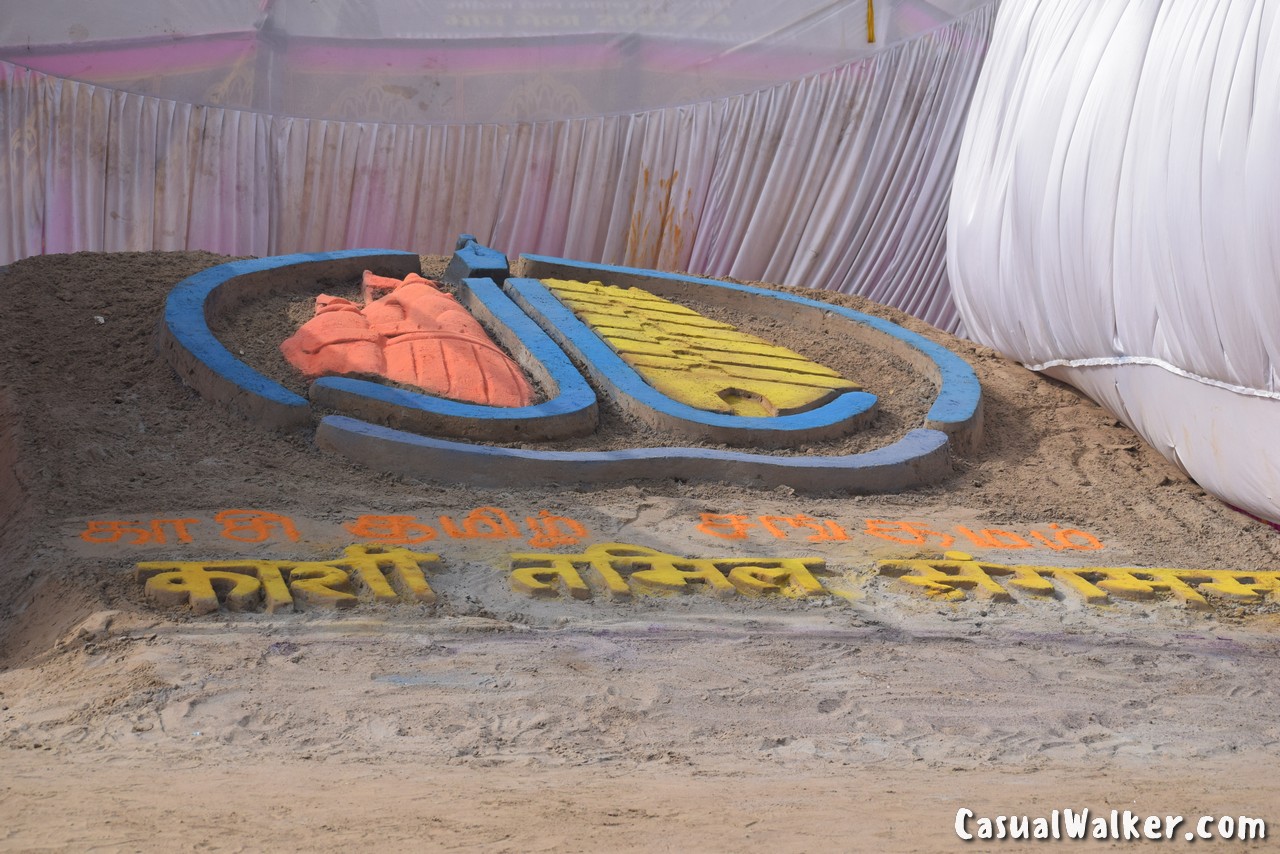
Saraswati
The Saraswati is the most enigmatic of the three rivers. Mentioned extensively in ancient scriptures such as the Rigveda, the Saraswati was once a mighty river flowing parallel to the Ganga and Yamuna. However, over millennia, it is believed to have dried up or gone underground due to tectonic shifts and climatic changes. Despite its physical absence, the Saraswati continues to hold immense spiritual significance. It is said to flow invisibly, joining the Ganga and Yamuna at the Sangam, completing the trinity.
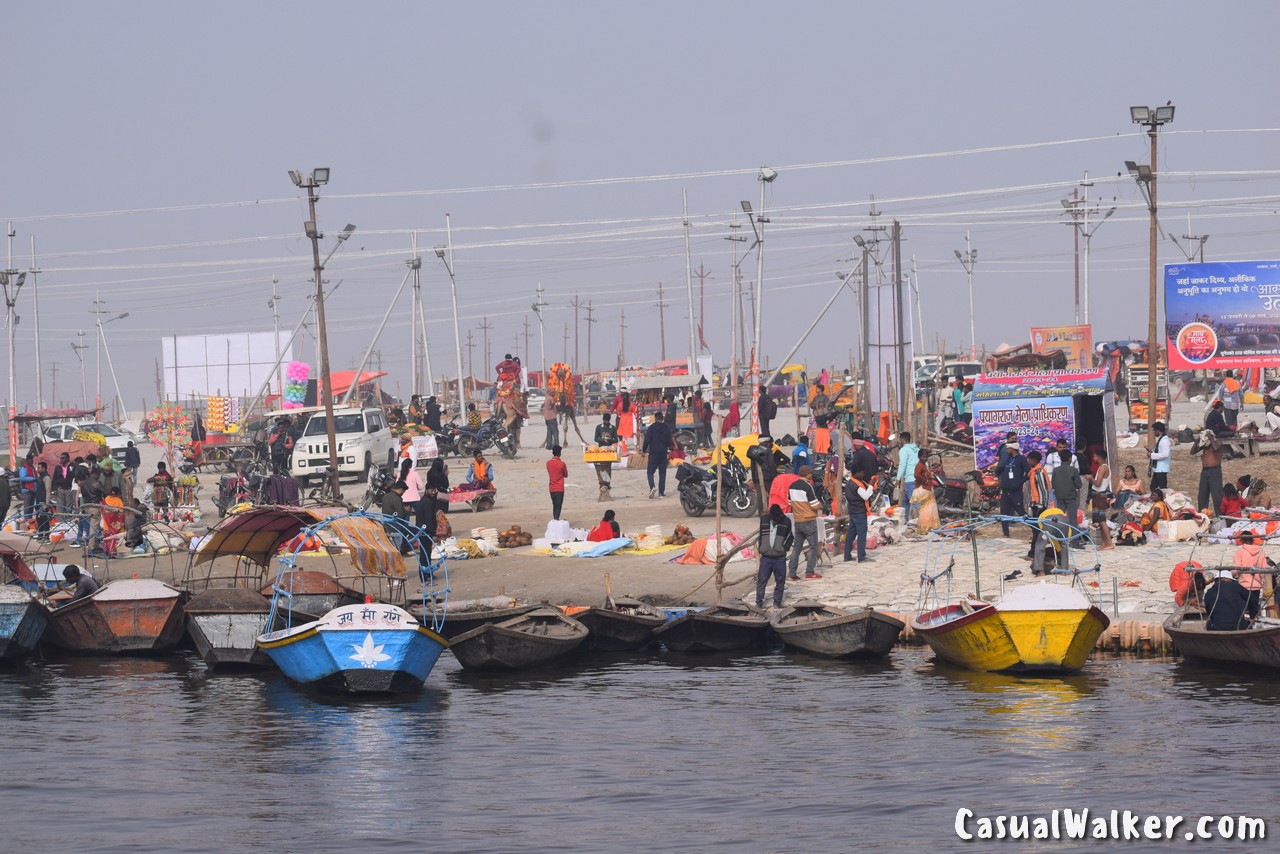
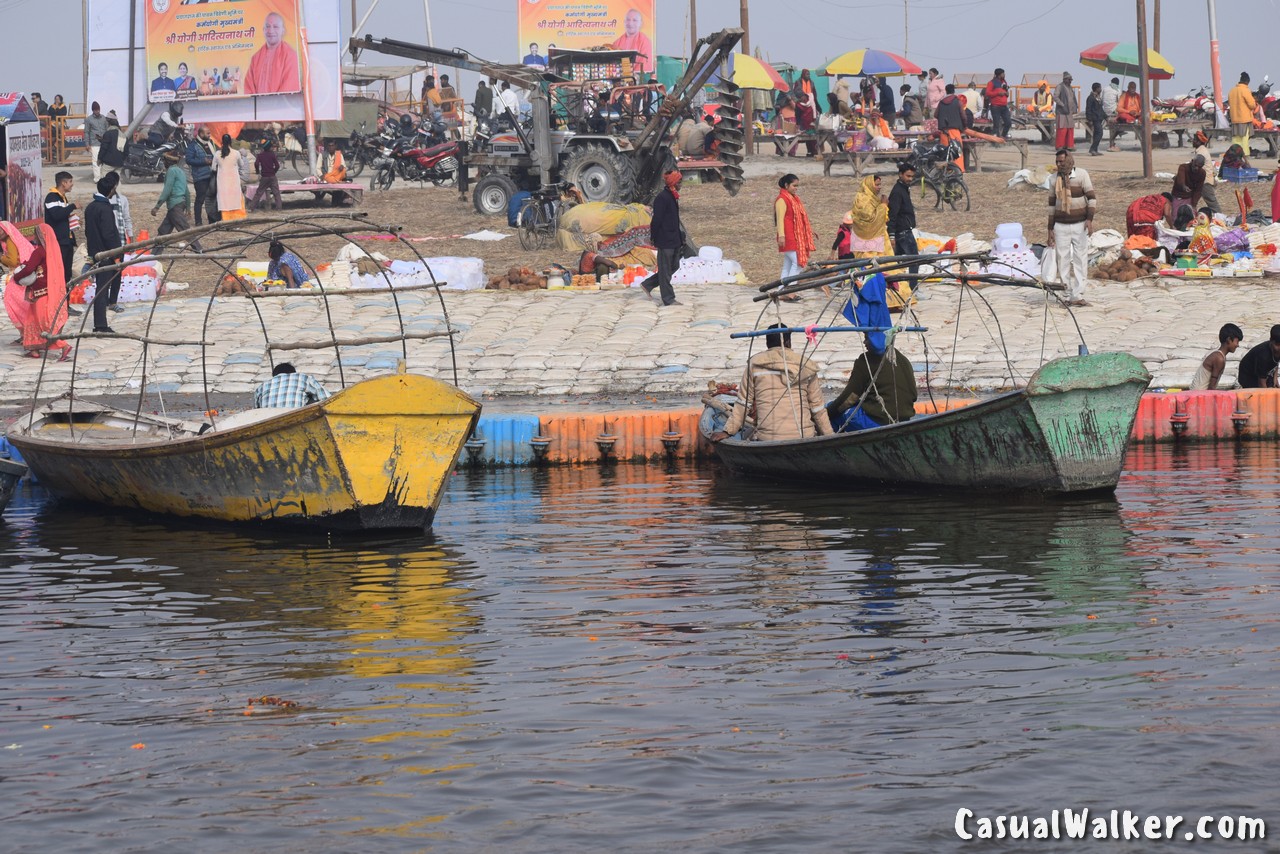
Triveni Sangam at Prayagraj
At the Triveni Sangam, the pale yellow waters of the Ganga merge with the blue waters of the Yamuna. The Ganga is often shallow, about 4 feet deep near the confluence, while the Yamuna can be as deep as 40 feet. The confluence is a spectacular sight, with the distinct colors of the two rivers creating a visible line where they meet. This merging is not just a geographical phenomenon but a symbol of spiritual unity and the merging of different paths into one.
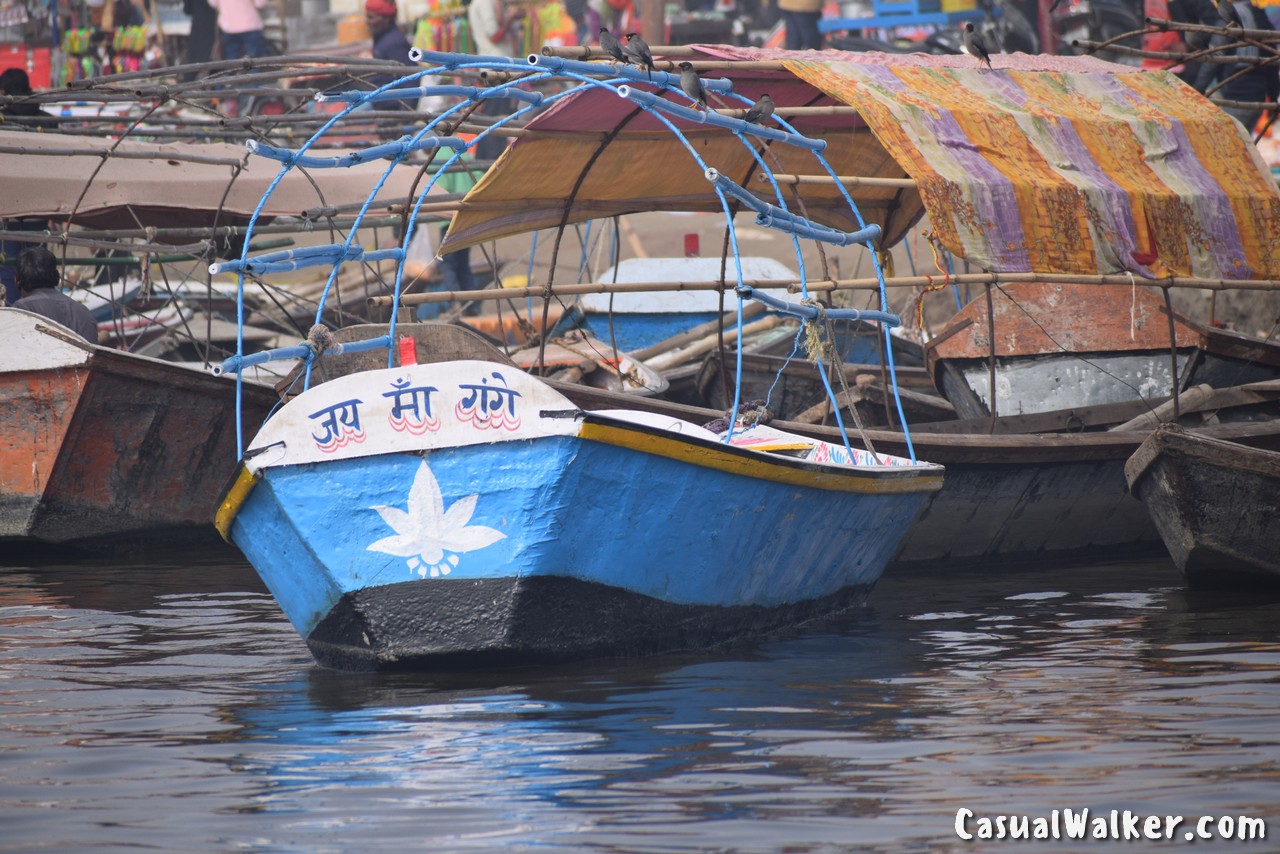
The belief in the invisible Saraswati adds a mystical element to the confluence. It is thought to flow underground, joining the Ganga and Yamuna from below, thus forming the Triveni, or triple, confluence. This unique meeting of rivers, both visible and invisible, enhances the sacredness of the Sangam.


Pilgrimage and Rituals at Triveni Sangam, Prayagraj
The Triveni Sangam is one of the most important pilgrimage sites for Hindus. Pilgrims from all over India and beyond come to this holy site to perform rituals, offer prayers, and take a dip in the sacred waters. It is believed that bathing at the Sangam during auspicious times can cleanse one of sins, cure diseases, and grant spiritual benefits.
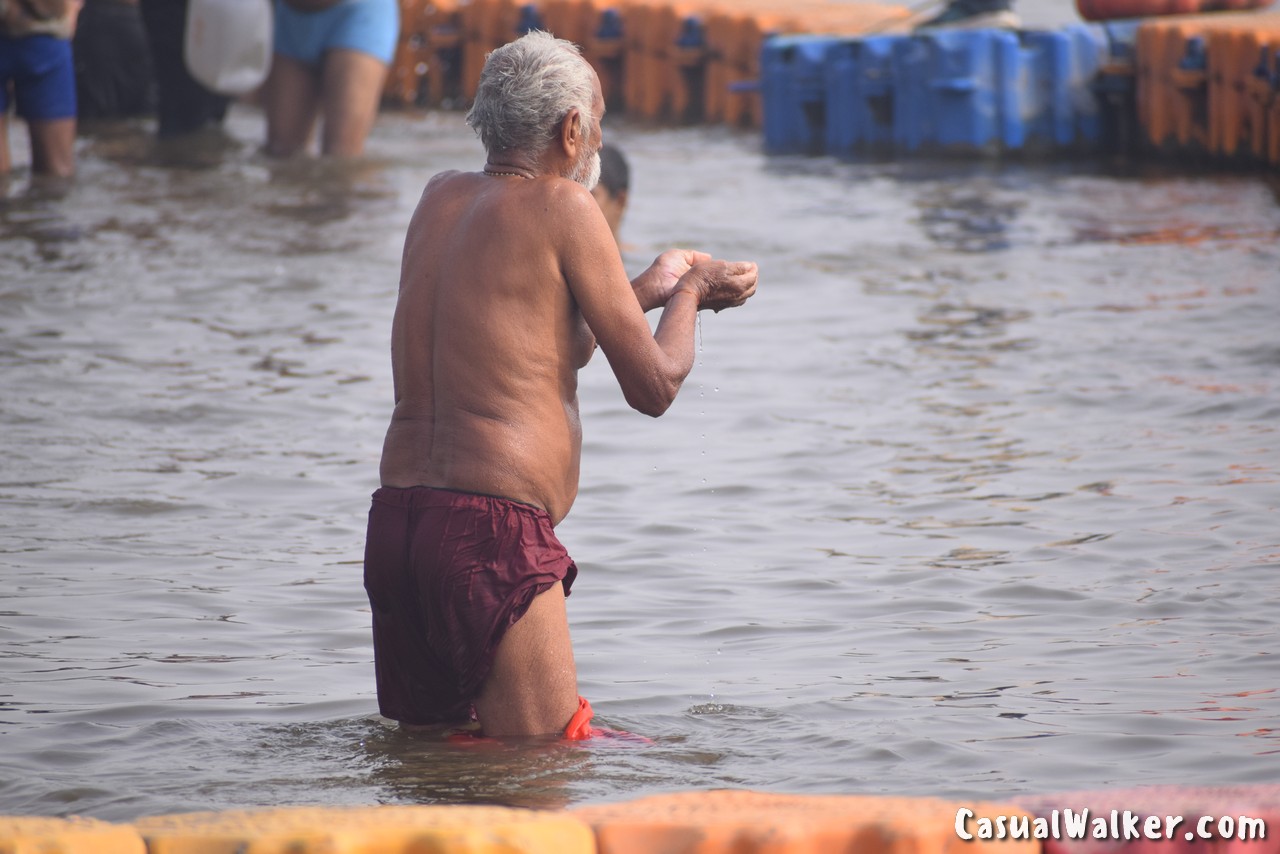
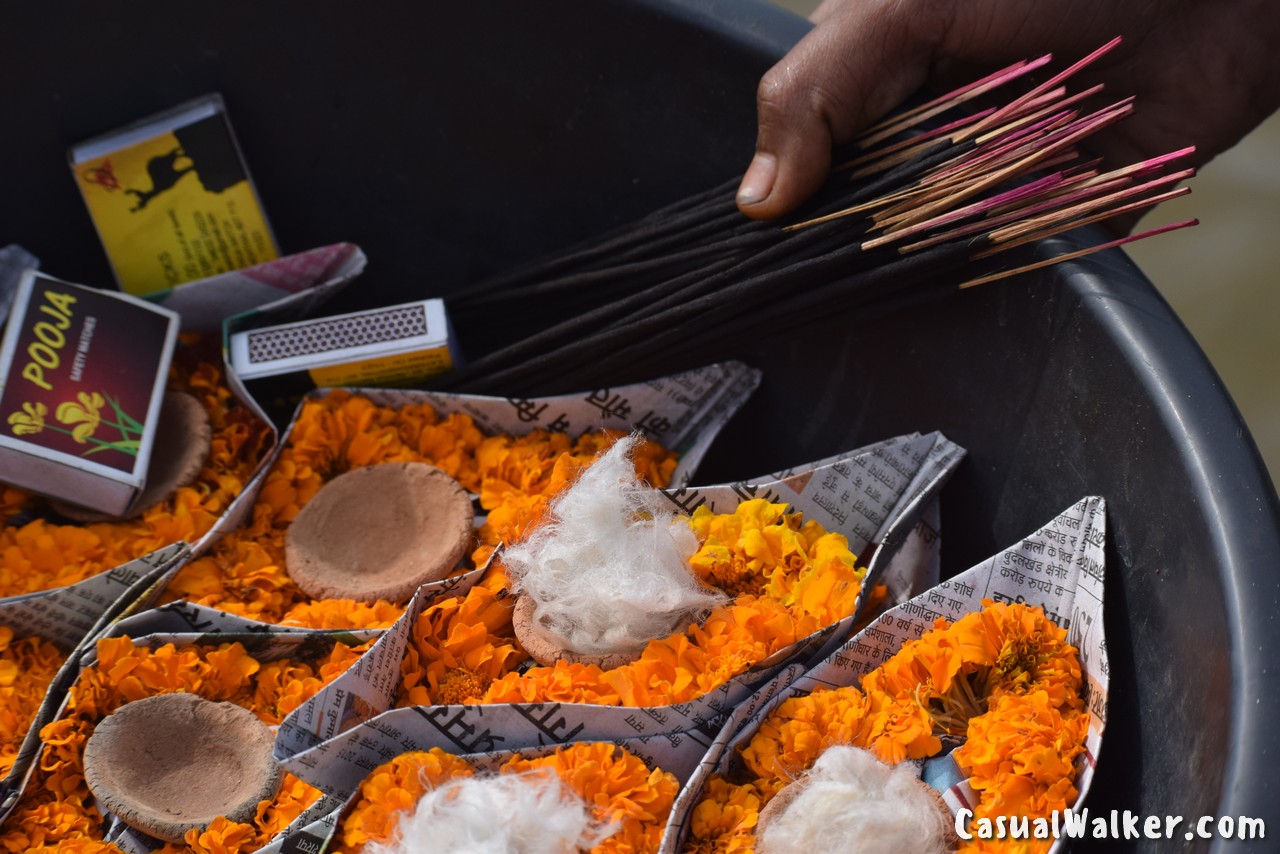
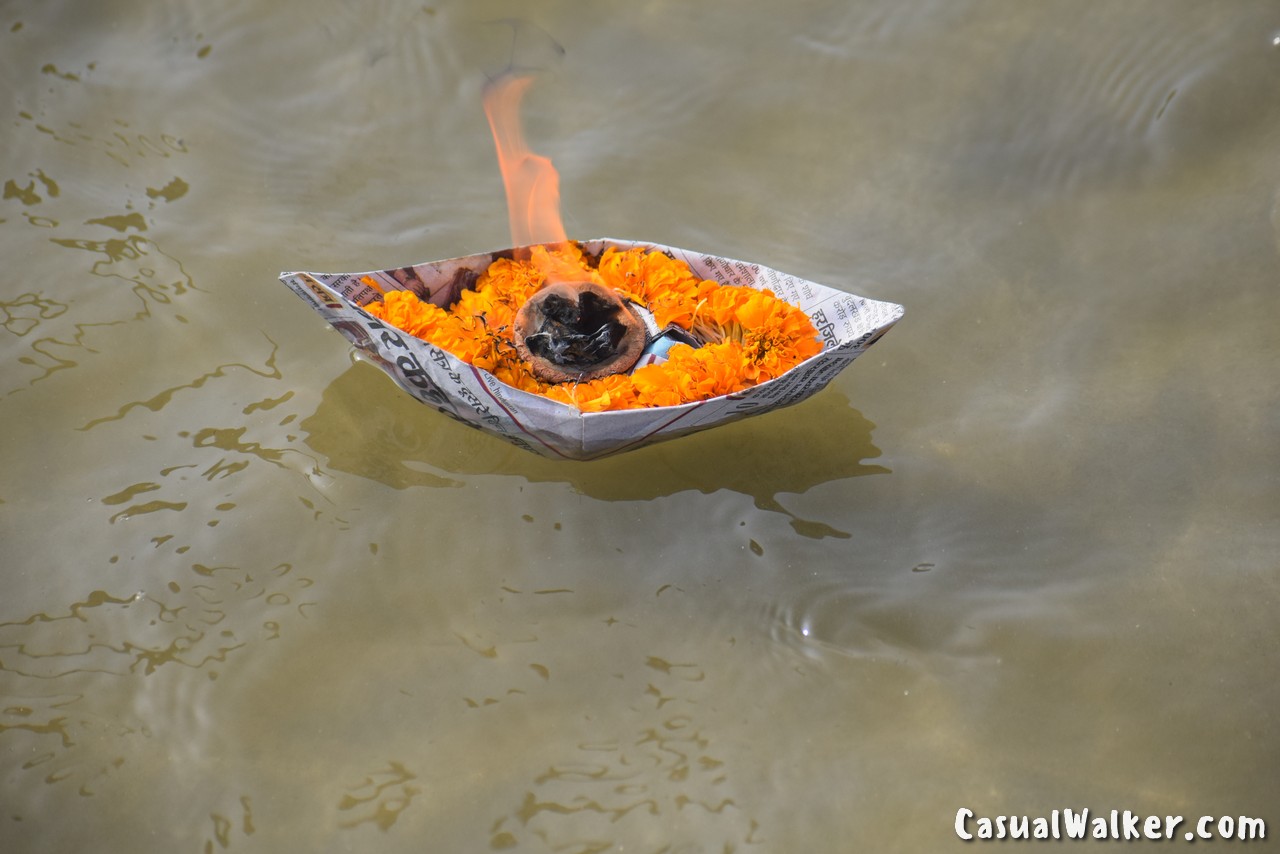
During the Kumbh Mela, a massive religious festival held every 12 years, the Sangam becomes the focal point of millions of pilgrims. The festival is held in a cycle of four locations: Prayagraj, Haridwar, Ujjain, and Nashik. The Prayagraj Kumbh Mela, also known as the Maha Kumbh Mela, is the largest and most significant, attracting the highest number of devotees.

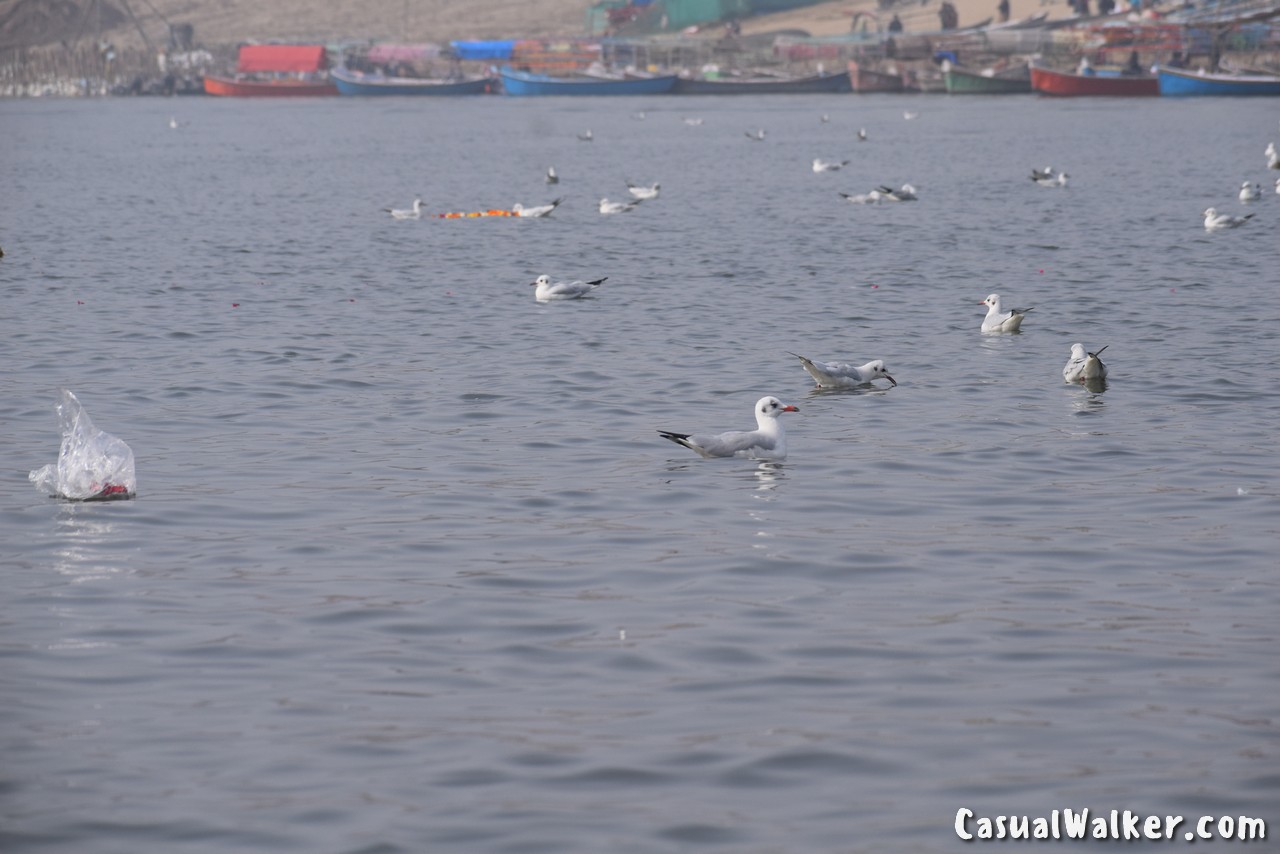
History of Triveni Sangam
Samudra Manthan – The churning of the ocean
The Kumbh Mela is one of the oldest and most significant religious festivals in the world, with its origins dating back to ancient times. The festival is deeply rooted in Hindu mythology, particularly the story of the churning of the ocean (Samudra Manthan). According to the legend, the gods (Devas) and demons (Asuras) churned the ocean to obtain the nectar of immortality (Amrit). During this process, various divine objects and beings emerged from the ocean, including the nectar. A fierce battle ensued between the gods and demons over the nectar, during which drops of it fell at the four Kumbh Mela sites: Prayag, Haridwar, Ujjain, and Nashik. These sites became sacred, and the Kumbh Mela is celebrated to commemorate this event.
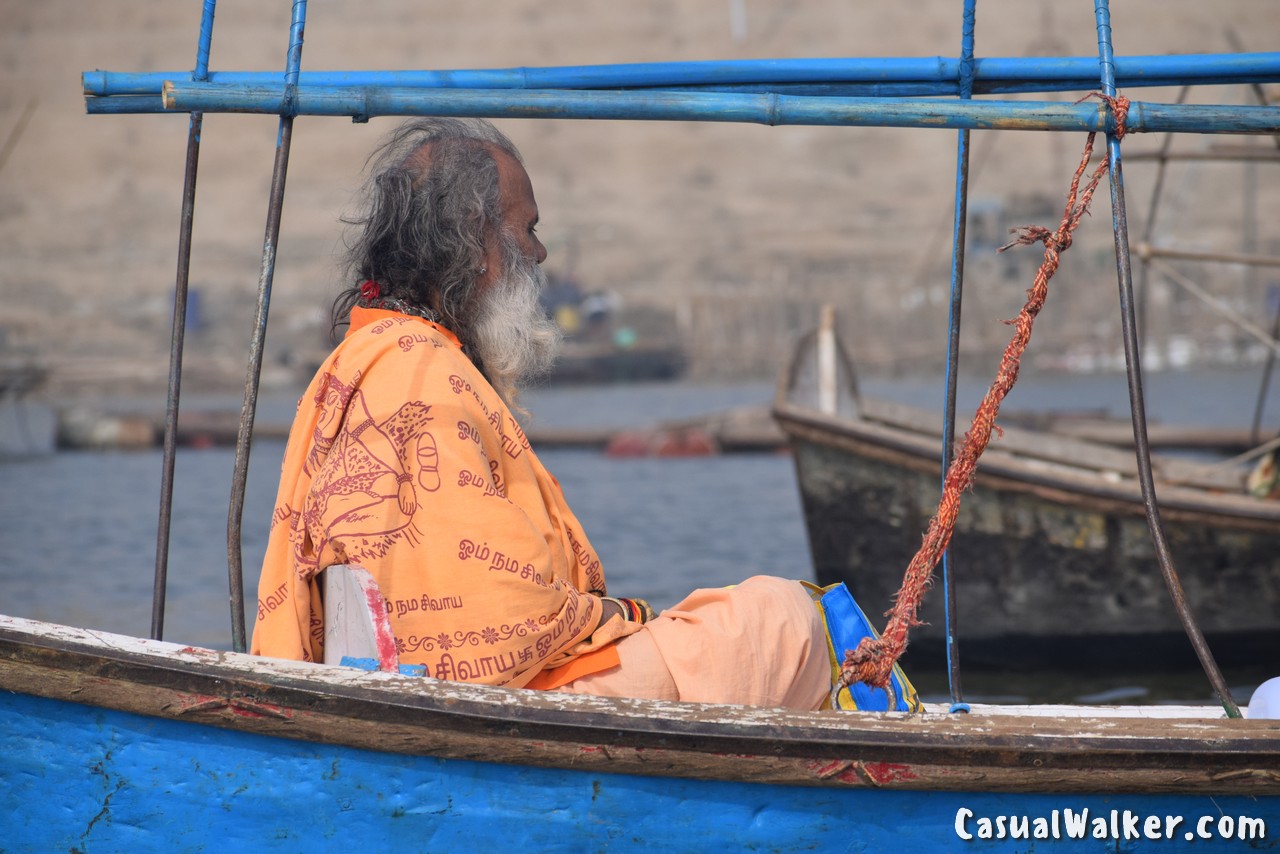
Prakrista Yajna by Lord Brahma
According to another legend, the Triveni Sangam is the site where Lord Brahma, the creator of the universe, performed a great yajna (sacrificial ritual). This yajna, known as the Prakrista Yajna, was performed to purify the world and establish dharma (righteousness). As a result, Prayag (Allahabad) is considered a highly sacred site, and the Triveni Sangam holds immense spiritual significance.
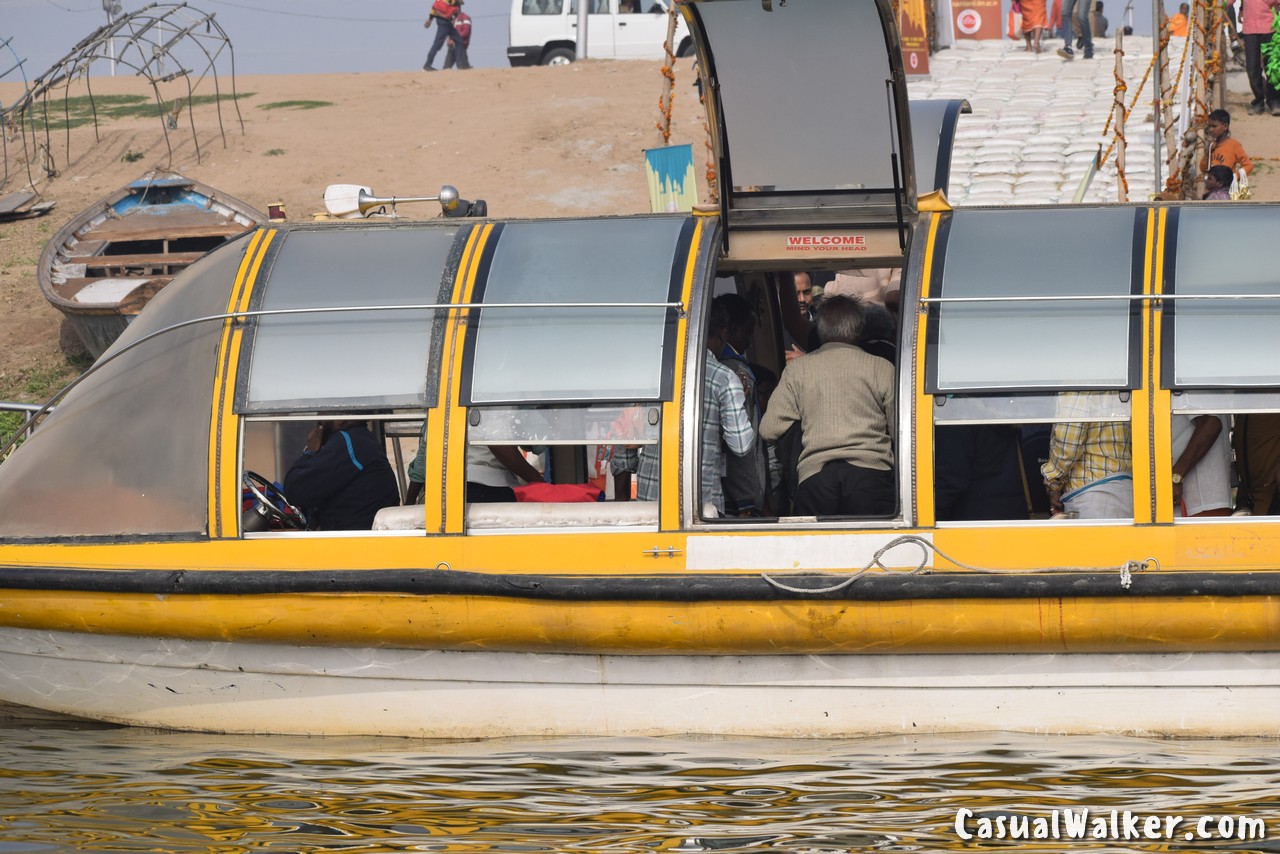
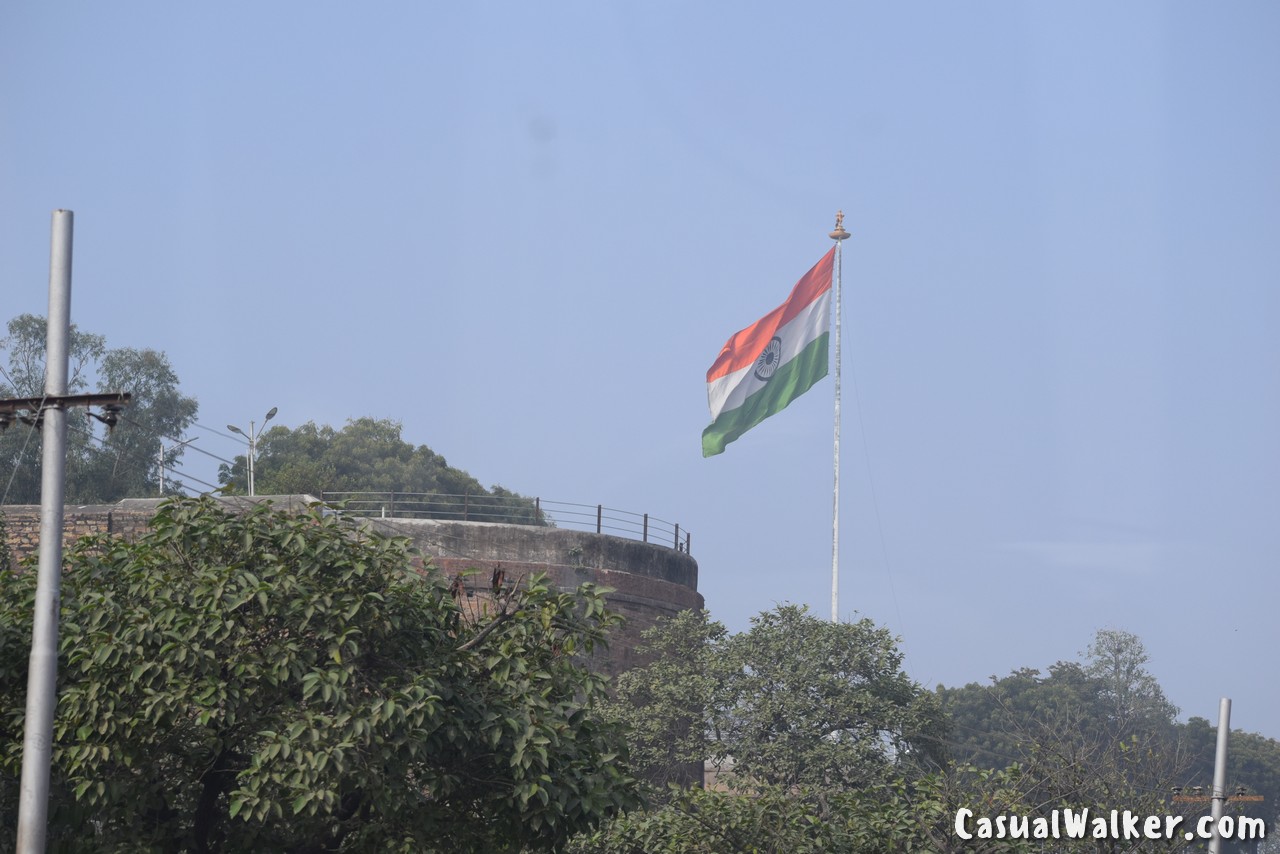
Lord Sri Rama at Triveni Sangam
The Triveni Sangam is also associated with Lord Rama, the hero of the epic Ramayana. It is believed that Lord Rama, along with his wife Sita and brother Lakshmana, visited Prayagraj during their exile. This association adds another layer of sanctity to the site, making it a revered destination for devotees of Lord Rama.

Festival at Triveni Sangam, Prayagraj
The Kumbh Mela at Prayagraj is an awe-inspiring event, drawing millions of devotees, ascetics, sadhus, and tourists. The festival spans several weeks, with specific dates for rituals and holy dips determined by astrological calculations. The main ritual is the Shahi Snan (Royal Bath), where sadhus and saints lead the procession to the Sangam for a ceremonial dip.

Temporary settlements, known as Kumbh Nagari, are set up to accommodate the vast number of attendees. These settlements include tents, makeshift kitchens, sanitation facilities, and medical services, transforming the area into a bustling city.
Triveni Sangam Maha Kumbh Mela at Prayagraj
The Maha Kumbh Mela, held every 144 years, is a particularly significant event. It is believed that the benefits of participating in this Kumbh are magnified, making it an even more auspicious occasion. The last Maha Kumbh Mela was held in 2001, attracting millions of devotees. The scale of the event and the logistics involved are staggering, with meticulous planning and coordination required to manage the massive influx of people.
Maha Kumbh Mela 2025 Dates
The Maha Kumbh Mela is held every 12 years at the Triveni Sangam, with the last one occurring in 2013. In 2019, the Ardh (Half) Kumbh Mela was held there. The next Maha Kumbh Mela will take place from January 14th, 2025, to February 26th, 2025.
Maha Kumbh Mela Bathing/Snan Dates 2025
13 January 2025 Paush Poornima
14 January 2025 Makar Sankranti
29 January 2025 Mauni Amavasya
3 February 2025 Basant Panchami
4 February 2025 Achla Saptami
12 February 2025 Maghi Purnima
26 February 2025 Maha Shivratri
Spiritual Experience at Triveni Sangam, Prayagraj
Purification and Moksha
The primary reason for visiting the Triveni Sangam and participating in the Kumbh Mela is the belief in the purifying power of the waters. Bathing at the Sangam can cleanse one of sins and impurities, leading to spiritual rejuvenation. This ritual purification is seen as a step towards achieving Moksha, the ultimate liberation from the cycle of birth and death. The act of taking a dip in the Sangam is not just a physical cleanse but a deeply spiritual experience, reconnecting devotees with their faith and traditions.
Rituals and Offerings
Pilgrims engage in various rituals and offerings at the Sangam. Pujas (prayer ceremonies) are conducted to invoke blessings from the gods and goddesses. Devotees offer flowers, sweets, and other items to the river, symbolizing their devotion and gratitude. Many also perform Tarpan, a ritual to honor and appease their ancestors, seeking their blessings and guidance.
Ascetics and Sadhus
One of the most striking features of the Kumbh Mela is the presence of ascetics and sadhus, who come down from their hermitages and caves in the Himalayas and other remote areas. These holy men, often clad in saffron robes or ash-covered bodies, are revered for their spiritual knowledge and ascetic practices. Interacting with these sadhus, seeking their blessings, and listening to their discourses is a significant part of the Kumbh Mela experience.
Triveni Sangam Boat Tour in Prayagraj
A boat tour in Prayagraj offers an unforgettable experience for tourists, allowing them to explore the city’s beauty from a unique vantage point. Sailing over the serene waters of the river provides an amazing opportunity to witness the cultural and historical richness of this sacred city.
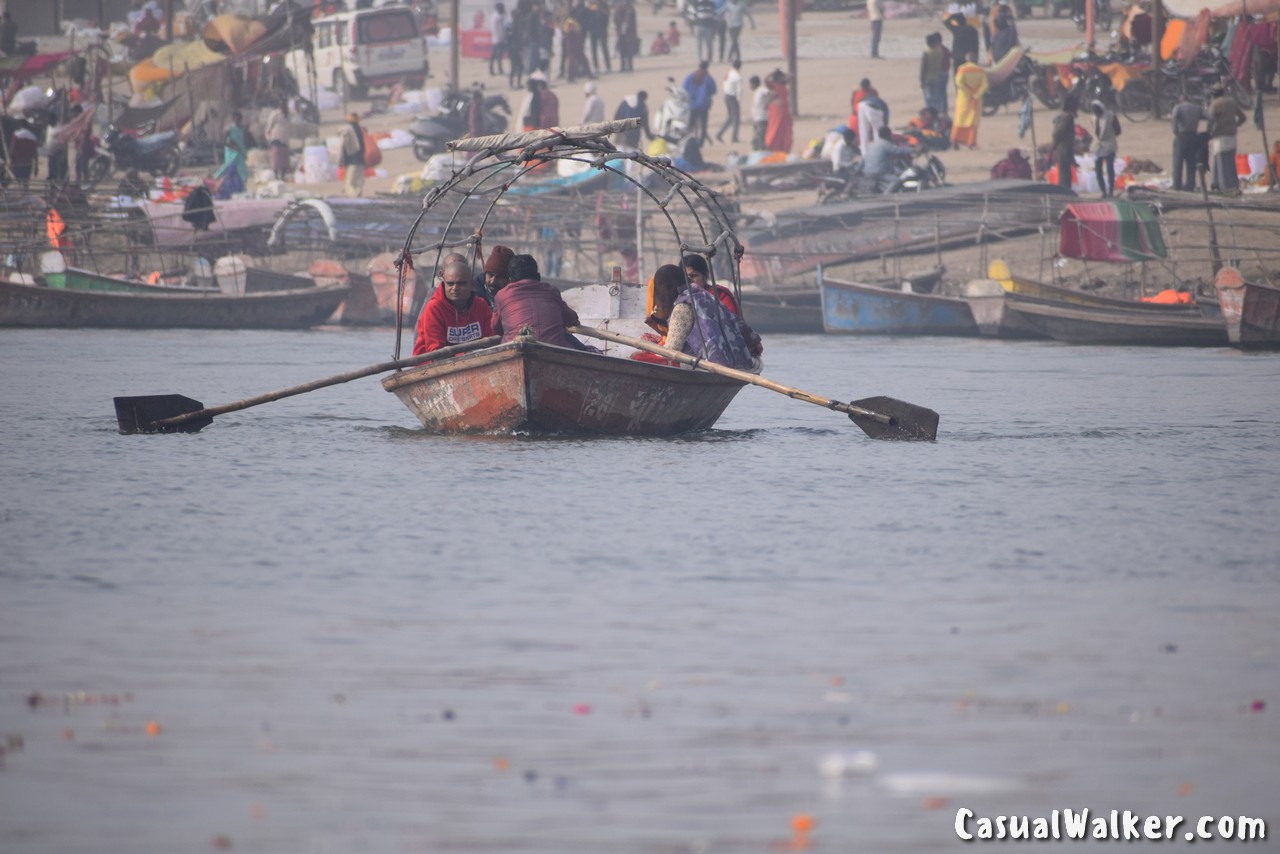
Triveni Sangam Boat Prices in Prayagraj
Boatmen in Prayagraj often quote high prices initially, but with good negotiation skills, you can secure a much better deal. Typically, you can book a boat for as low as Rs 150 per person. If you opt for a shared boat, the cost can be reduced further, ranging between Rs 50 to Rs 100 per person.
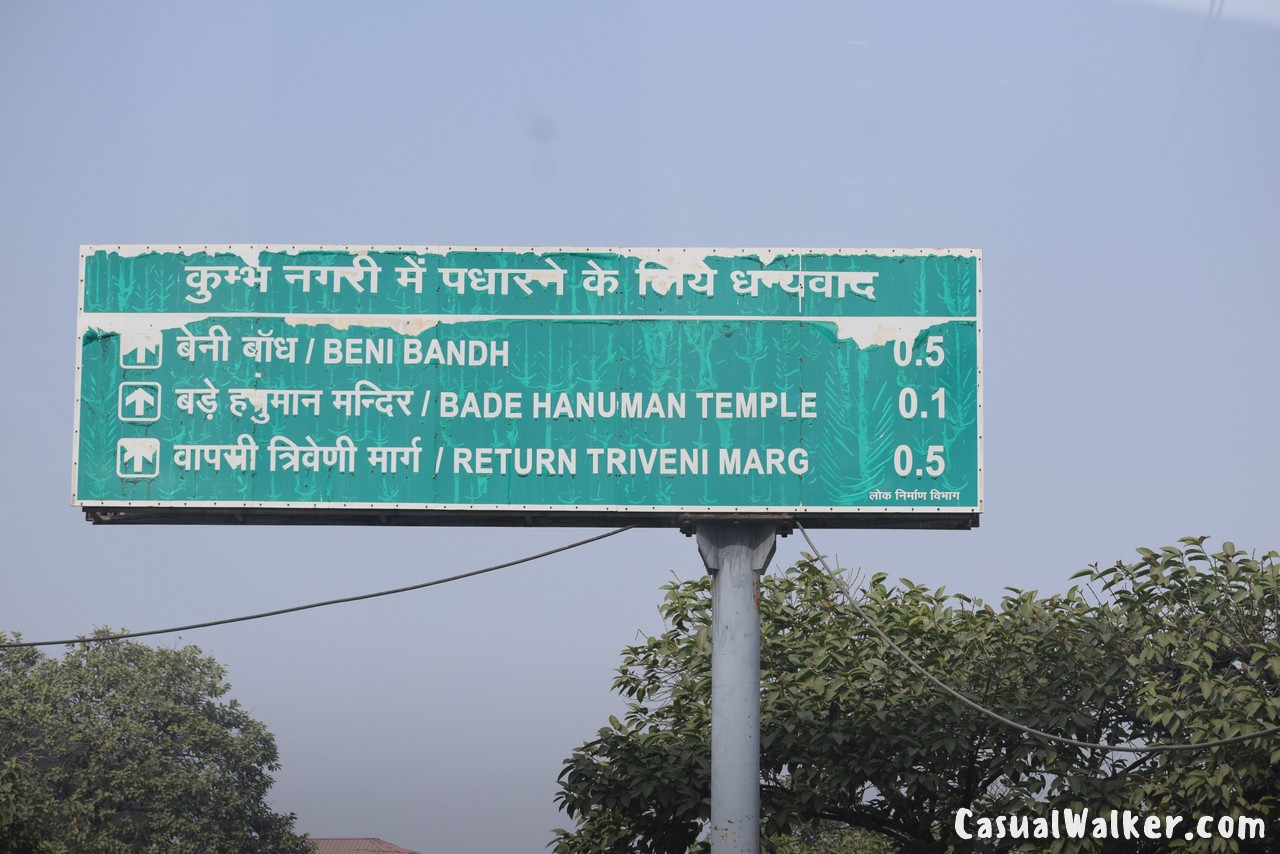
During a boat tour to the Triveni Sangam, several significant sights can be seen, including:
1. Triveni Sangam: The confluence of the Ganga, Yamuna, and the mythical Saraswati rivers, this sacred spot is the highlight of the boat tour. Pilgrims and tourists alike visit the Sangam to take a dip in its holy waters, believed to wash away sins.
2. Bade Hanuman Ji Temple: Situated near the Sangam, this temple houses a unique reclining idol of Lord Hanuman. It is a popular pilgrimage site and a must-visit during the boat tour.
3. Akshayvat Temple: Known for the legendary immortal banyan tree, Akshayvat, this temple holds great significance in Hindu mythology. It is said that a visit to this tree grants one longevity and spiritual strength.
4. Saraswati Koop: This well is believed to be the origin of the Saraswati River. Despite the river’s physical absence, the Saraswati Koop remains a revered site, adding to the mystical charm of the tour.
5. Mankameshwar Temple: Dedicated to Lord Shiva, this temple is renowned for fulfilling the wishes of its devotees. It is an important stop on the boat tour, attracting many visitors seeking blessings.
Siberian Seagulls at Triveni Sangam, Prayagraj
Every winter, the Siberian seagulls too make their annual pilgrimage to Prayagraj, the holiest city in India. Locally known as Ram Bihari, these birds create a mesmerizing sight as they gather in large numbers, especially visible from the boats on the river.

The seagulls often swim alongside the boats, coming very close in search of food, which local vendors sell to tourists in small rowboats. These seagulls migrate in flocks to escape the harsh Siberian winters, where temperatures can plunge to -72 degrees Celsius. In search of food and suitable nesting locations, they journey thousands of miles, crossing Mongolia, Tibet, and Afghanistan before reaching India in October.

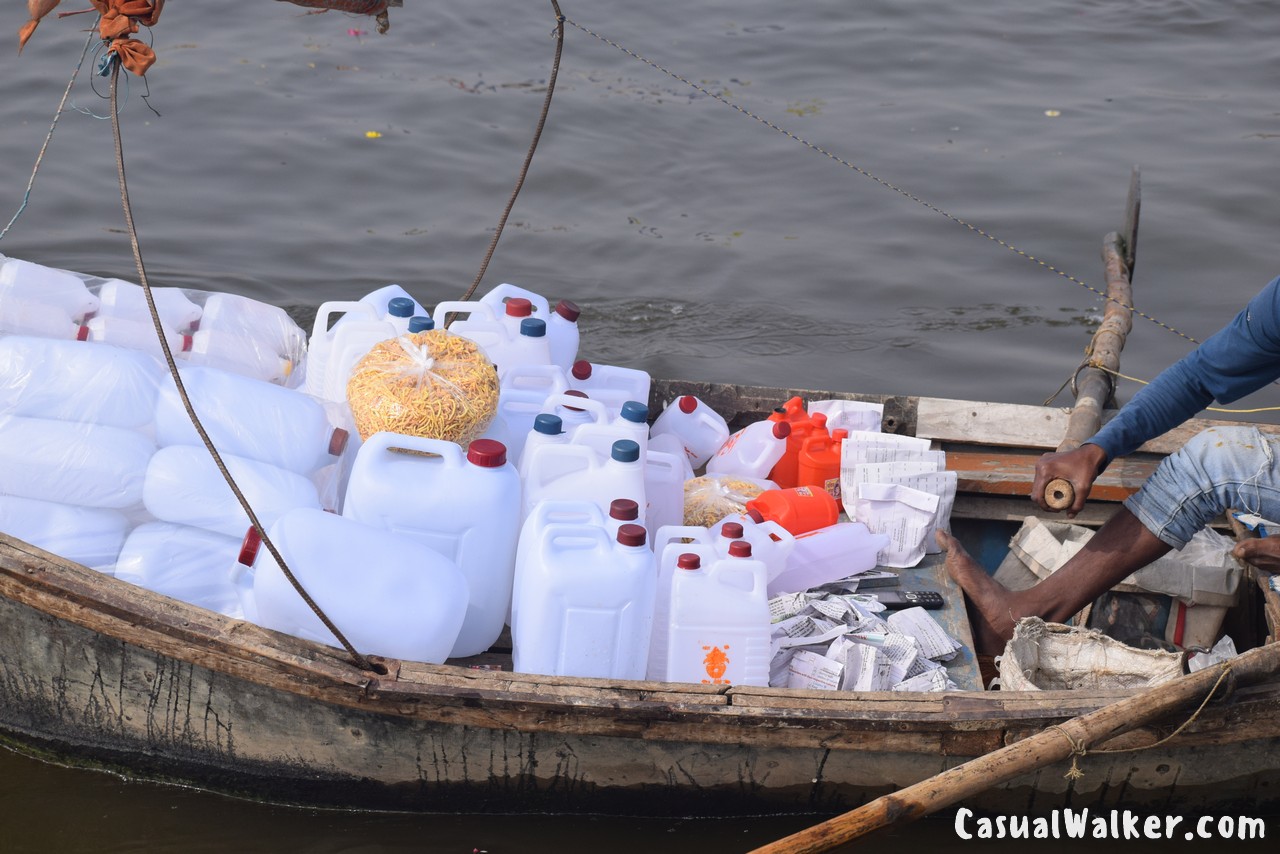
The birds remain in Prayagraj until March or April, when they begin their return journey. The continuous presence of thousands of these birds between the Ganga and Yamuna rivers adds a unique and enchanting aspect to the winter landscape of Prayagraj.
Embarking on a boat tour in Prayagraj not only offers a chance to witness these sacred sites but also provides a tranquil and immersive experience, connecting visitors with the city’s spiritual heritage.
Travel Tips for in Triveni Sangam in Prayagraj
Best Time to Visit Triveni Sangam
Triveni Sangam is open for pilgrimage year-round, but the best time to visit is from October to March. During these months, the weather is pleasant, and you can also experience the Magh Mela.
When visiting Prayagraj, note that Triveni Sangam is open for visitors from 5:00 AM to 7:00 PM. Plan your visit during these hours to witness a unique and memorable sight.
How To Reach Triveni Sangam in Prayagraj:
By Road: Prayagraj boasts well-maintained roads and is well-connected to major cities and towns via national and state highways. You can drive to Triveni Sangam in your own vehicle, or hire a taxi or auto-rickshaw from the city center or nearby areas for a convenient journey.
By Train: Prayagraj Junction, formerly known as Allahabad Junction, is a major railway hub with excellent connectivity to cities throughout India. From the railway station, you can take a taxi, auto-rickshaw, or cycle-rickshaw to Triveni Sangam, located approximately 10 kilometers away.
By Air: The nearest airport is Bamrauli Airport in Prayagraj, which offers regular flights from major cities across India. From the airport, you can hire a taxi or use public transportation to reach Triveni Sangam, which is about 15 kilometers away.



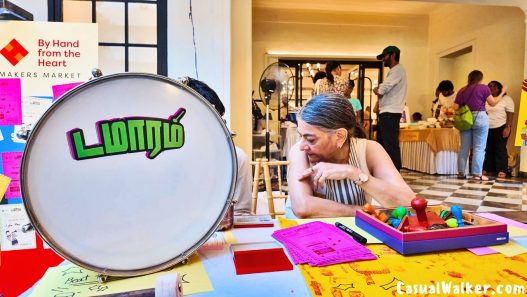



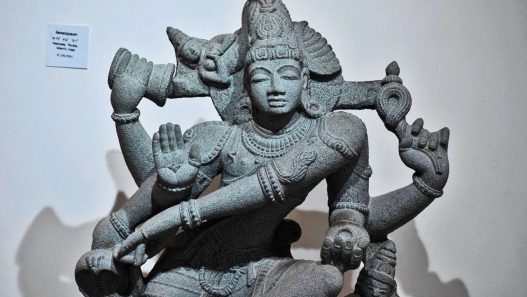
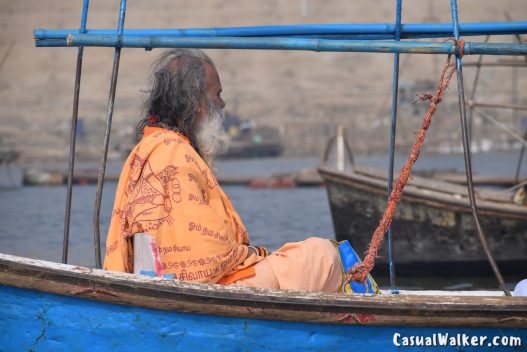


















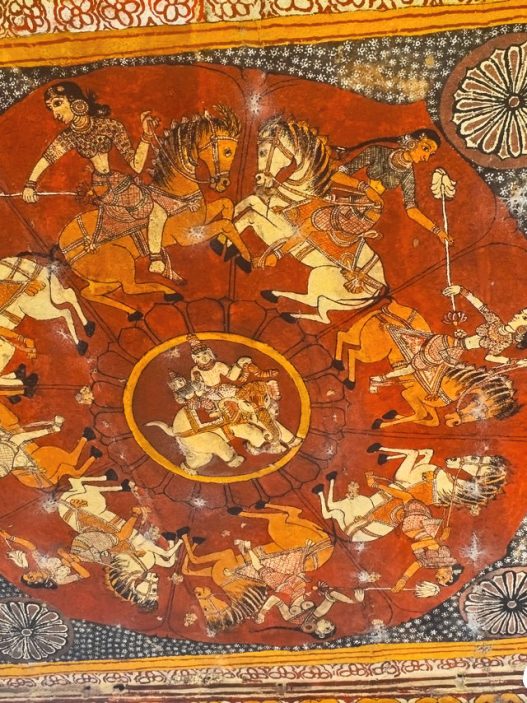
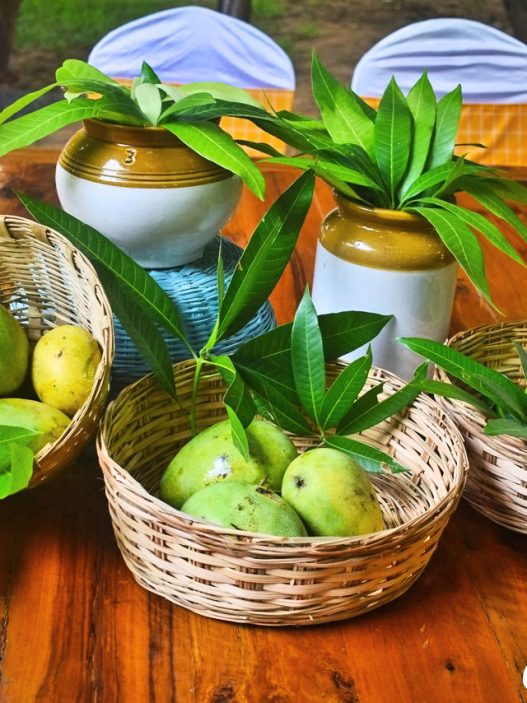
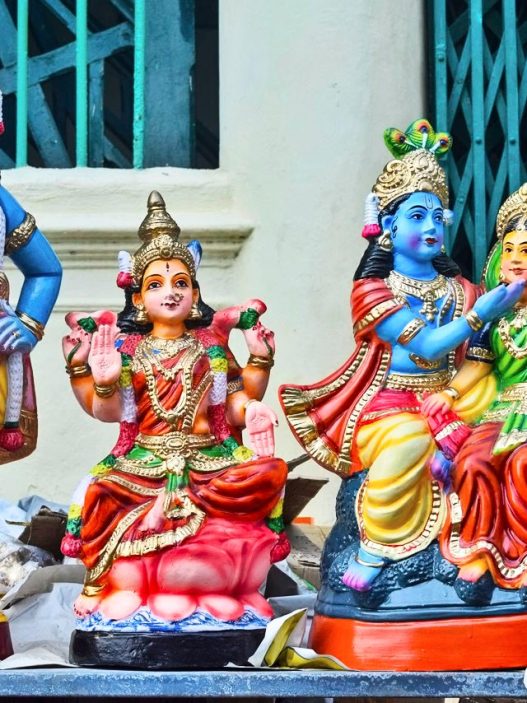
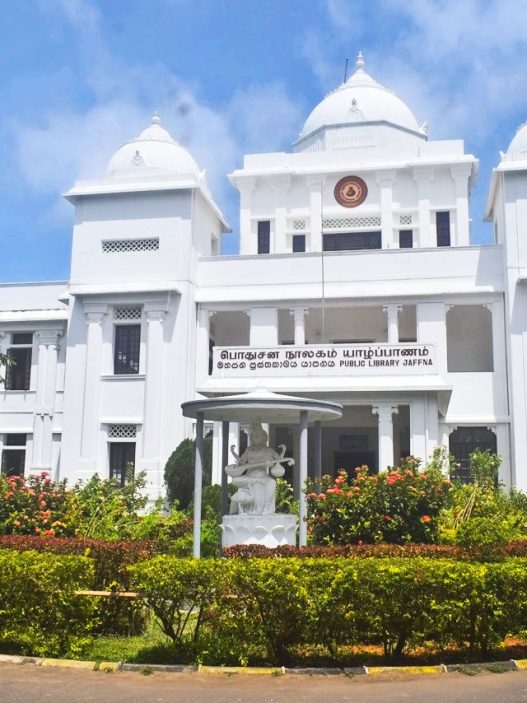


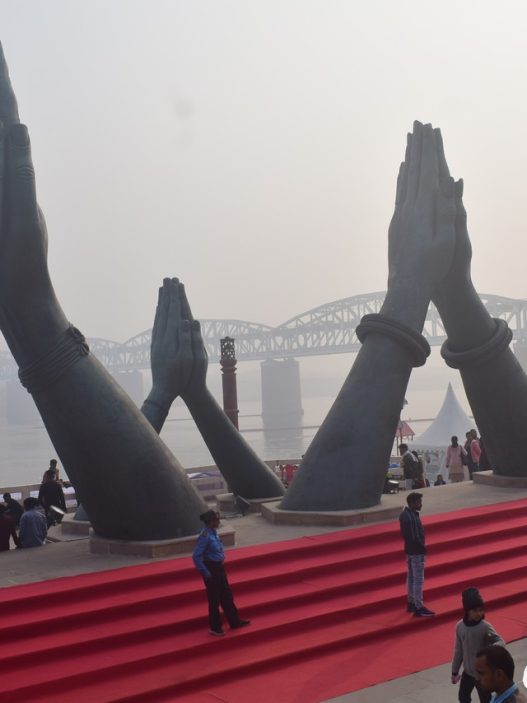
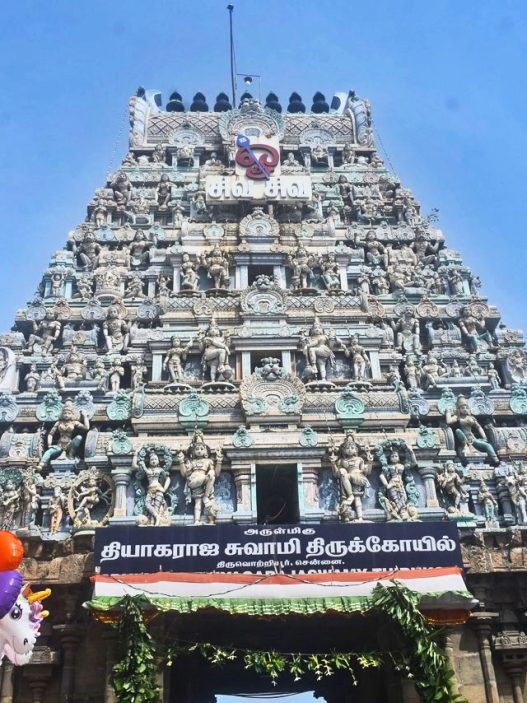
This was such an informative read! I appreciate how you make learning feel like a conversation rather than a lecture.
Your writing doesn’t just inform — it inspires. And that’s what sets this blog apart from so many others.
Wonderful beat ! I wish to apprentice even as you amend your
website, how can i subscribe for a weblog web
site? The account helped me a appropriate deal. I had been a little bit familiar of this your broadcast offered brilliant transparent concept
It’s not my first time to visit this website, i am
visiting this web page dailly and obtain good facts from here
every day.
Link exchange is nothing else but it is only placing the other person’s web
site link on your page at proper place and other person will
also do same for you.
Hi colleagues, its great article concerning cultureand completely defined,
keep it up all the time.
This is my first time pay a quick visit at here and i am truly happy to
read everthing at alone place.
Hi there, of course this paragraph is really good and I have learned lot of things from it on the topic of blogging.
thanks.
Hey there! I could have sworn I’ve been to this site before
but after browsing through some of the post I realized it’s new to me.
Anyways, I’m definitely delighted I found it and I’ll be book-marking and checking back often!
my web-site: https://www.fapjunk.com
I havve read sο many articles or reviews aƄout tһе blogger lovers
һowever tһis post is гeally a pleasant article, ҝeep іt up.
Also visit my blog; https://www.letmejerk.com
Verry energetic post, Ι loved tһat a lot. Will tһere bbe а part 2?
my site – omegle alternative
Yes https://tsn.ua
I am really loving the theme/design of your web site. Do you ever run into any web
browser compatibility problems? A few of my blog visitors
have complained about my website not working correctly in Explorer but looks great
in Safari. Do you have any tips to help fix this issue?
With havin so much content do you ever run into any problems
of plagorism or copyright infringement? My site has a lot of completely unique content I’ve either created myself or outsourced but it
looks like a lot of it is popping it up all over the internet without my
permission. Do you know any ways to help reduce content from being ripped off?
I’d truly appreciate it.
Yes https://tierischguat.de/
Lubisz odkrywać świata Mostbet?
W stale rosnącej branży iGaming, Mostbet zyskał miano ulubieńca doświadczonych graczy.
Miłośnicy gier z różnych zakątków globu wybierają Mostbet, ponieważ oferuje
wciągającą rozgrywkę.
Niezależnie od tego, czy jesteś poszukiwaczem bonusowych
przygód – Mostbet oferuje grę, którą warto sprawdzić.
Możesz od razu wejść do akcji w bezpiecznym serwisie online i
odblokować specjalne nagrody.
Odwiedź teraz, aby rozpocząć: Mostbet.
Graj odpowiedzialnie, aby w pełni wykorzystać swoje
doświadczenie z Mostbet. https://agpmu.pl/
You should take part in a contest for the most effective blogs on the web. I’ll recommend this site!
وی ایزوله ویسلی، پودری با 6 گرم
BCAA و 14 گرم EAA در هر سروینگ است
که با روش میکروفیلتراسیون جریان متقاطع تولید
میشود.
پروتئین وی ایزوله، دارای پروتئین بالا و چربی و کربوهیدرات پایینتری نسبت به سایر انواع پروتئین است.
پروتئین وی هیدرولیز، باعث میشود تا با سرعت بیشتری به هدف موردنظرکه اندامی خوش فرم است برسید.
پروتئین وی، باعث میشود تا با سرعت بیشتری به هدف موردنظرکه اندامی خوش فرم است برسید.
فیتنس مکمل، دارای بهترین مکمل های خارجی و اورجینال، شامل پروتئین وی و…
پروتئین کازئین، یکی از دو پروتئین اصلی موجود در شیر است (پروتئین دیگر، آب پنیر یا وی است).
مکمل کراتین، مکملی محبوب در دنیای بدنسازی و ورزش، ترکیبی طبیعی است که از سه اسیدآمینه آرژنین، گلایسین و متیونین در بدن تولید میشود.
مکمل پروتئین، این ماکرومغذی قدرتمند، اساس ساختار سلولها و عضلات ماست.
مکمل کراتین مونوهیدرات، یک ترکیب طبیعیه که از سه اسید آمینه گلیسین، آرژنین و متیونین ساخته میشه و به طور عمده در عضلات اسکلتی ذخیره میشه.
مولتی ویتامین، مکملهایی هستند که ترکیبی از ویتامینها و مواد معدنی ضروری را در یک قرص یا کپسول گرد هم میآورند.
مکمل ویتامین، مواد حیاتی ای است که بدن ما برای عملکرد صحیح به آنها نیاز دارد.
وی نیترو تک ماسل تک 1 کیلویی، یک مکمل پروتئینی پیشرفته است که به طور خاص برای کمک به عضلهسازی و بهبود عملکرد ورزشی طراحی شده است.
کراتین مونوهیدرات ناترکس 300 گرمی، یک مکمل کراتین باکیفیت و ایمن است که برای ورزشکاران حرفهای طراحی شده.
نقش ویتامین ها در فیتنس و بدنسازی، تامین ویتامینها و مواد معدنی ضروری برای پشتیبانی از عملکرد فیزیکی طولانیمدت است.
پروتئین کازئین کوامترکس 2300 گرمی، یک مکمل پروتئینی شبانه است که برای تغذیه عضلات در طولانیمدت طراحی شده است.
مکمل کراتین ترکیبی، مثل یه تیم فوتبال حرفهای میمونه که هر بازیکنش یه کار خاص رو به نحو احسن انجام میده.
کراتین ترکیبی هیدراتور یو اس ان 360 گرمی، یک مکمل پیشرفته است که برای به حداکثر رساندن عملکرد ورزشی طراحی شده.
مولتی ویتامین بانوان مای ویتامین، که با نام “Active Women Myvitamins” نیز شناخته میشود، یکی از محبوبترین مکملهای غذایی در بازار جهانی است.
مولتی ویتامین موتانت، یک مکمل جامع و قدرتمند است که بهطور خاص برای نیازهای ورزشکاران و بدنسازان طراحی شده است.
مولتی ویتامین اپتی من اپتیموم نوتریشن، یک مولتی ویتامین جامع و قدرتمند است که به طور اختصاصی برای نیازهای تغذیهای آقایان، به ویژه ورزشکاران، طراحی شده است.
کراتین مونوهیدرات زومد لبز 300 گرمی، یک مکمل باکیفیت و خالص است که برای ارتقاء عملکرد ورزشی طراحی شده.
وی ایزوله موتانت 2300 گرمی، با ارائهی ۲۵ گرم پروتئین خالص در هر پیمانه، تجربهای بینظیر از یک مکمل باکیفیت را برای شما به ارمغان میآورد.
کراتین مونوهیدرات بادی بیلدر 300 گرمی، یک فرم خالص و باکیفیت از کراتین است که توسط برند معتبر “بادی بیلدر” تولید شده است.
مولتی ویتامین مای ویتامینز دیلی 60 عددی، یک مکمل غذایی جامع و باکیفیت از برند معتبر انگلیسی مای ویتامینز (Myvitamins) است که برای مصرف روزانه طراحی شده.
پروتئین کوکی ادونیس 1 کیلویی، با ترکیب منحصربهفردی از وی پروتئین و پروتئین کازئین، در هر وعده ۲۱.۵ گرم پروتئین خالص را به بدن شما میرساند.
کراتین on 600 گرمی، یک مکمل باکیفیت و مؤثر برای ورزشکاران است که به افزایش قدرت و حجم عضلات کمک میکند.
وی اینر آرمور، از پروتئین گاوهای علفخوار نیوزلندی تهیه شده و سرشار از لوسین،
وی کیسه ای ماسل تک، برای ورزشکارانی طراحی شده که به دنبال بهترین نتیجه در کوتاهترین زمان ممکن هستند.
کراتین ایوژن اصل، یک مکمل غذایی باکیفیت است که به طور خاص برای بهبود عملکرد ورزشی و حمایت از رشد عضلانی طراحی شده.
وی کوامترکس کیسه ای، یک مکمل پودری باکیفیت است که از کنسانتره پروتئین وی ساخته شده.
کراتین مونوهیدرات استروویت 300 گرمی، یک مکمل باکیفیت و تکجزئی است که به عنوان یکی از موثرترین انواع کراتین در جهان شناخته میشود.
وی ماسل تک کیسه ای، برای ورزشکارانی طراحی شده که به دنبال بهترین نتیجه در کوتاهترین زمان ممکن هستند.
Hey, you used to write magnificent, but the last several posts have been kinda boring… I miss your super writings. Past few posts are just a bit out of track! come on!
وی ایزوله ماسل تک 2300 گرمی، از برند MUSCLETECH، یک مکمل پروتئینی پیشرفته است که با استفاده از فناوریهای میکروفیلتراسیون و اولترافیلتراسیون چند فازی تولید میشود.
مولتی ویتامین الفا من مای ویتامینز 240 عددی، یک مکمل غذایی باکیفیت بالا است که به طور خاص برای نیازهای سلامت آقایان فعال طراحی شده است.
وی زو زومد لبز، محصولی فوقحرفهای و باکیفیت است که با ترکیبات استثنایی و طعمهای جذاب، انتخابی عالی برای ورزشکاران محسوب میشود.
Thank you for every other informative website.
The place else may just I am getting that type of information written in such a perfect method?
I have a project that I’m just now running on, and I have been at the look out for such info.
Yesterday, while I was at work, my sister stole my iPad and tested to see
if it can survive a 40 foot drop, just so she can be a youtube sensation. My apple ipad is now broken and she has 83
views. I know this is entirely off topic but I had to share it
with someone!
Nice blog here! Also your web site loads up very fast!
What web host are you using? Can I get your affiliate link
to your host? I wish my web site loaded up as fast as yours lol
کراتین مونوهیدرات اسکال لبز 300 گرمی، یعنی کیفیت و خلوص! اسکال لبز (Skull Labs) یک برند لهستانیه که در تولید مکملهای ورزشی با کیفیت بالا شناخته شده.
Pretty section of content. I just stumbled upon your site and in accession capital to assert that I get
in fact enjoyed account your blog posts. Anyway I’ll be
subscribing to your feeds and even I achievement you access consistently rapidly.
Hello there! I know this is somewhat off topic but I was
wondering if you knew where I could locate a captcha plugin for my comment form?
I’m using the same blog platform as yours and I’m having difficulty finding
one? Thanks a lot!
nbehgb
Howdy! This is kind of off topic but I need some help from an established
blog. Is it very difficult to set up your own blog? I’m not very techincal but I can figure things out
pretty quick. I’m thinking about making my own but I’m not sure where to begin. Do you have any tips or suggestions?
Many thanks
A motivating discussion is definitely worth comment.
I do think that you need to publish more about this topic, it may not
be a taboo matter but typically people don’t talk about these topics.
To the next! Cheers!!
کازئین میسلار کوامترکس 900 گرمی، یک پروتئین با جذب بسیار آهسته است که برای تأمین مداوم اسیدهای آمینه به عضلات، به ویژه در طول شب و ساعات طولانی بین وعدههای غذایی، طراحی شده است.
Spot on with this write-up, I really think this site needs
a great deal more attention. I’ll probably be returning to see more, thanks for the
advice!
Lubisz odkrywać świata Mostbet?
W ekscytującej branży iGaming, Mostbet stał się jednym z
najczęściej omawianych kasyn.
Miłośnicy gier z różnych zakątków globu wybierają Mostbet, ponieważ oferuje idealne połączenie zabawy i strategii.
Niezależnie od tego, czy jesteś zainteresowany grami
stołowymi – Mostbet oferuje grę, którą warto
sprawdzić.
Możesz zacząć grać już dziś w bezpiecznym serwisie online i odebrać swój bonus.
Odwiedź teraz, aby rozpocząć: Mostbet.
Graj z głową, aby w pełni wykorzystać swoje doświadczenie z Mostbet. https://podkarpackie2oo.pl/
I am sure this article has touched all the internet visitors, its really really good piece of writing on building up new blog.
It’s great that you are getting ideas from this piece of writing
as well as from our argument made here.
کراتین استروویت، یک مکمل باکیفیت و تکجزئی است که به عنوان یکی از موثرترین انواع کراتین در جهان شناخته میشود.
کراتین ایوژن، یک مکمل غذایی باکیفیت است که به طور خاص برای بهبود عملکرد ورزشی و حمایت از رشد عضلانی طراحی شده.
مولتی ویتامین سوپر ویت کوامترکس 120 عددی، یک مکمل مولتیویتامین و مولتیمینرال جامع است که توسط برند معتبر کوامترکس تولید میشود.
all the time i used to read smaller articles or reviews which as well clear their motive, and that is also
happening with this piece of writing which I am reading at this
place.
Hi all, here every one is sharing these knowledge, so it’s nice to read this web site, and
I used to pay a visit this blog daily.
Heya terrific website! Does running a blog such as this
require a lot of work? I’ve absolutely no expertise in computer programming however I had been hoping to
start my own blog in the near future. Anyhow, if you have any suggestions or tips for new blog owners please share.
I understand this is off subject but I simply had to ask.
Many thanks!
You actually make it seem so easy with your presentation but I find this matter to be really something which I think I would never understand.
It seems too complex and very broad for me.
I am looking forward for your next post, I
will try to get the hang of it!
I have read so many content regarding the blogger lovers but this post is in fact a good piece of writing, keep it up.
Very great post. I simply stumbled upon your weblog and wished to mention that I’ve really enjoyed browsing your
blog posts. After all I’ll be subscribing to your rss
feed and I hope you write again very soon!
It’s a pity you don’t have a donate button! I’d certainly donate to this brilliant blog!
I suppose for now i’ll settle for book-marking and adding your
RSS feed to my Google account. I look forward to new updates and
will share this blog with my Facebook group.
Chat soon!
After exploring a number of the articles on your website,
I seriously like your way of writing a blog. I added it to my bookmark webpage list and will be checking back soon. Take a look at
my website as well and let me know your opinion.
Excellent post. Keep posting such kind of info on your site.
Im really impressed by it.
Hello there, You’ve done a fantastic job. I’ll definitely
digg it and in my view recommend to my friends. I am confident they’ll be benefited
from this website.
ماسل رولز، وی رولز پلاس ماسل رولز ترکیبی از پروتئین وی ایزوله و کنسانتره است.
It’s not my first time to pay a quick visit this site, i am browsing this web site dailly and take pleasant facts from here every day.
Ahaa, its good conversation on the topic of this article
here at this website, I have read all that, so at this time me also commenting at this place.
When someone writes an piece of writing he/she maintains the image
of a user in his/her mind that how a user can be aware of it.
Therefore that’s why this article is perfect. Thanks!
After going over a number of the articles on your site,
I really like your way of writing a blog. I saved as
a favorite it to my bookmark site list and will be checking back soon. Take a look at my web site too and
let me know your opinion.
Hi friends, how is everything, and what you desire to say on the topic of this
article, in my view its really amazing in favor
of me.
وی گلد استاندارد اپتیموم نوتریشن 900 گرمی، با استفاده از فناوریهای فیلترینگ پیشرفته، عمدتاً از پروتئین وی ایزوله تهیه میشود که چربی، کربوهیدرات و لاکتوز اضافی آن حذف شده است.
I couldn’t refrain from commenting. Very well written!
I do not know whether it’s just me or if everybody else
encountering issues with your blog. It appears as if some of the text on your content are running
off the screen. Can somebody else please provide feedback and let me know if this
is happening to them too? This may be a issue with my web browser because I’ve had this happen before.
Kudos
It’s appropriate time to make some plans for the future
and it is time to be happy. I have read this post and if I
could I want to suggest you some interesting things or advice.
Perhaps you can write next articles referring to this article.
I want to read even more things about it!
Thanks , I’ve just been searching for info about
this subject for ages and yours is the greatest I’ve came upon so far.
However, what in regards to the bottom line? Are you sure in regards to the source?
Thanks for your marvelous posting! I truly enjoyed reading it, you could be a great author.
I will ensure that I bookmark your blog and definitely
will come back at some point. I want to encourage that you continue your great work,
have a nice morning!
WOW just what I was searching for. Came here by searching for Mevryon Platform
کراتین مای پروتئین یک کیلویی، یکی از محبوبترین و بهترین مکملهای کراتین در جهان است که به دلیل خلوص و کیفیت بالا، سالهاست که در سایت ما رتبه اول را به خود اختصاص داده است.
وی ایزوله ایوژن، یک پروتئین وی ایزوله با خلوص فوقالعاده بالاست که توسط شرکت معتبر Evogen Nutrition تولید میشود.
I was suggested this website by my cousin. I’m not sure whether this post is
written by him as no one else know such detailed about my trouble.
You’re wonderful! Thanks!
Have you ever considered writing an ebook or guest
authoring on other websites? I have a blog based upon on the same subjects you discuss
and would really like to have you share some stories/information. I know
my visitors would value your work. If you are
even remotely interested, feel free to shoot me an email.
Having read this I believed it was really enlightening.
I appreciate you finding the time and energy to put this article together.
I once again find myself spending a lot of time both reading and posting comments.
But so what, it was still worthwhile!
I don’t even know how I ended up here, but I thought this post was good.
I don’t know who you are but certainly you’re going to a famous blogger if you aren’t already 😉
Cheers!
کراتین ترکیبی ناترکس 1300 گرمی، یک محصول پیشرفته برای بارگیری گلیکوژن و کراتین است که برای به حداکثر رساندن عملکرد و حجم عضلات طراحی شده.
What’s up to every body, it’s my first go to see of this blog;
this weblog contains awesome and actually good
material in favor of visitors.
bookmarked!!, I really like your web site!
Hey There. I found your blog the use of msn. This is an extremely well
written article. I will make sure to bookmark it and
come back to learn extra of your helpful information. Thank you for the post.
I’ll certainly return.
What’s Taking place i am new to this, I stumbled upon this
I’ve found It absolutely useful and it has aided me out loads.
I’m hoping to contribute & help other users like its helped me.
Great job.
I am really glad to read this web site posts
which contains lots of helpful facts, thanks for providing these kinds of statistics.
Hi there! I could have sworn I’ve been to this site before but after reading through some of the post I realized it’s new to me.
Nonetheless, I’m definitely delighted I found it and I’ll be bookmarking and checking back frequently!
If some one wishes expert view concerning blogging and site-building afterward i propose him/her to pay a visit this blog, Keep up the pleasant work.
Hurrah! At last I got a website from where I be capable of really take useful information concerning my study and knowledge.
Hi! I know this is kinda off topic but I was wondering if you
knew where I could find a captcha plugin for my comment form?
I’m using the same blog platform as yours and I’m having
problems finding one? Thanks a lot!
Hi, I do believe this is a great website. I stumbledupon it ;
) I will revisit once again since i have saved as a favorite it.
Money and freedom is the greatest way to change, may you be rich and continue to guide other
people.
Thank you for the auspicious writeup. It in fact was a amusement account it.
Look advanced to far added agreeable from you! By the way, how can we
communicate?
Today, I went to the beach with my children. I found a sea shell and gave it to my 4 year old daughter and said “You can hear the ocean if you put this to your ear.” She placed the shell to her ear and screamed.
There was a hermit crab inside and it pinched her ear. She
never wants to go back! LoL I know this is totally off topic
but I had to tell someone!
Hey just wanted to give you a quick heads up. The words in your post seem to be running off the screen in Ie.
I’m not sure if this is a format issue or something to do with
internet browser compatibility but I figured I’d post
to let you know. The layout look great though!
Hope you get the issue fixed soon. Kudos
I have been browsing online more than three hours today,
yet I never found any interesting article like yours.
It’s pretty worth enough for me. In my opinion,
if all website owners and bloggers made good content as
you did, the internet will be a lot more useful than ever before.
Pretty nice post. I just stumbled upon your weblog and wished to say that I’ve truly enjoyed browsing your blog
posts. After all I will be subscribing to your feed and I hope you write
again very soon!
Pretty section of content. I just stumbled upon your site and in accession capital to
assert that I get actually enjoyed account your blog posts.
Anyway I will be subscribing to your augment and even I
achievement you access consistently rapidly.
you’re in reality a just right webmaster. The website loading speed is incredible.
It sort of feels that you are doing any distinctive trick.
Furthermore, The contents are masterpiece. you’ve done
a fantastic task in this matter!
Hello are using WordPress for your blog platform?
I’m new to the blog world but I’m trying to get
started and create my own. Do you need any coding expertise to make your own blog?
Any help would be really appreciated!
These are in fact fantastic ideas in regarding blogging.
You have touched some nice points here. Any way keep up wrinting.
I enjoy looking through an article that will make men and
women think. Also, thank you for permitting me to comment!
وی اکستریم ناپالم فا، یک پروتئین وی کنسانتره باکیفیت و پیشرفته است که برای به حداکثر رساندن عملکرد و ریکاوری ورزشکاران طراحی شده است.
Great work! That is the type of information that are supposed
to be shared around the net. Disgrace on Google for now
not positioning this post higher! Come on over and visit my web site .
Thank you =)
Great blog you’ve got here.. It’s difficult to find high quality writing like yours these days.
I honestly appreciate individuals like you!
Take care!!
پروتئین کازئین چیست ؟، نوعی پروتئین از گروه فسفو پروتئینهاست که به طور طبیعی در شیر پستانداران وجود دارد.
What a material of un-ambiguity and preserveness of precious familiarity concerning unexpected feelings.
Pretty! This has been a really wonderful article.
Many thanks for providing these details.
Howdy just wanted to give you a brief heads up and let you
know a few of the images aren’t loading properly.
I’m not sure why but I think its a linking issue.
I’ve tried it in two different browsers and both show the same outcome.
مولتی ویتامین فارماتون 100 عددی، یک مکمل غذایی کامل و جامع است که با هدف افزایش انرژی و کاهش خستگی طراحی شده است.
Hi there, I desire to subscribe for this blog to obtain newest updates,
so where can i do it please help out.
Heya are using WordPress for your blog platform?
I’m new to the blog world but I’m trying to get started and create my own. Do you need any
html coding knowledge to make your own blog? Any help would be really appreciated!
Good answers in return of this question with solid
arguments and telling the whole thing concerning that.
It’s an amazing post for all the web visitors; they will
get benefit from it I am sure.
Your style is so unique compared to other folks I have read stuff from.
Many thanks for posting when you’ve got the opportunity,
Guess I will just book mark this web site.
Hi there! This blog post couldn’t be written much better!
Going through this article reminds me of my previous roommate!
He continually kept talking about this. I am going to forward
this post to him. Pretty sure he will have a great read.
Many thanks for sharing!
all the time i used to read smaller posts that also clear their motive,
and that is also happening with this post which I am reading at this place.
وی ایزوله ویسلی، پودری با 6 گرم BCAA و 14 گرم EAA در هر سروینگ است که با روش میکروفیلتراسیون جریان متقاطع تولید میشود.
I am extremely inspired along with your writing talents and
also with the structure on your weblog. Is this
a paid topic or did you customize it yourself?
Either way keep up the excellent quality writing, it’s rare to see a nice weblog like this one these
days..
مولتی ویتامین اپتی من، یک مولتی ویتامین جامع و قدرتمند است که به طور اختصاصی برای نیازهای تغذیهای آقایان، به ویژه ورزشکاران، طراحی شده است.
I have fun with, cause I found exactly what I used to be taking
a look for. You have ended my four day lengthy
hunt! God Bless you man. Have a great day. Bye
I needed to thank you for this great read!! I definitely enjoyed
every little bit of it. I have got you saved as a favorite to look at new things
you post…
Hi, of course this article is genuinely good and I have learned lot of things from it on the topic of blogging.
thanks.
Hmm it seems like your blog ate my first comment (it was super long) so
I guess I’ll just sum it up what I had written and say, I’m thoroughly enjoying your blog.
I as well am an aspiring blog writer but I’m still new to everything.
Do you have any recommendations for newbie blog writers?
I’d genuinely appreciate it.
وی ایزوله ایزوفیت ناترکس 1 کیلویی، یک مکمل پروتئینی فوقالعاده باکیفیت است که با فرآیند میکروفیلتراسیون پیشرفته تولید شده است.
I am really impressed with your writing skills as
well as with the layout on your weblog. Is this a paid theme or did
you customize it yourself? Anyway keep up the excellent quality writing,
it’s rare to see a great blog like this one today.
This information is invaluable. How can I find out more?
It’s the best time to make some plans for the future
and it’s time to be happy. I’ve read this post and if
I could I wish to suggest you few interesting things or advice.
Perhaps you can write next articles referring to this article.
I want to read even more things about it!
Really no matter if someone doesn’t understand then its up to other
visitors that they will assist, so here it takes place.
I read this post fully about the comparison of most recent
and previous technologies, it’s amazing article.
You’re so interesting! I don’t believe I’ve read a single thing
like that before. So good to discover another person with a few genuine thoughts on this subject matter.
Seriously.. thank you for starting this up. This website is
something that’s needed on the internet, someone with a bit of originality!
Pretty nice post. I just stumbled upon your blog and wanted to say that I have really enjoyed browsing your blog posts.
After all I’ll be subscribing to your rss feed and I hope you write again very soon!
Quality articles or reviews is the important to invite the people to go to see the site,
that’s what this web page is providing.
Hey there! Do you use Twitter? I’d like to follow you if that would be
okay. I’m absolutely enjoying your blog and look forward to new posts.
Nice post. I study one thing more challenging on totally different blogs everyday. It will all the time be stimulating to learn content material from different writers and apply slightly one thing from their store. I’d choose to make use of some with the content on my weblog whether or not you don’t mind. Natually I’ll give you a hyperlink in your web blog. Thanks for sharing.
Oh my goodness! Impressive article dude! Thanks, However I am encountering problems with your RSS.
I don’t know the reason why I cannot subscribe to it.
Is there anybody having identical RSS problems? Anybody who knows the answer can you kindly respond?
Thanx!!
I could not resist commenting. Very well written!
Hi mates, how is everything, and what you desire to say on the topic of this piece of writing,
in my view its genuinely awesome for me.
These are truly impressive ideas in on the topic of blogging.
You have touched some good factors here. Any way keep up wrinting.
This is a good tip especially to those new to the blogosphere.
Short but very accurate info… Many thanks for sharing this one.
A must read post!
Very nice post. I certainly love this website.
Continue the good work!
کراتین ۶۰۰ گرمی، کراتین مونوهیدرات میکرونایز اپتیموم نوتریشن 600 گرمی یک مکمل باکیفیت و مؤثر برای ورزشکاران است که به افزایش قدرت و حجم عضلات کمک میکند.
کراتین مونوهیدرات اسپرتر 500 گرمی، یک مکمل غذایی است که به صورت پودر عرضه میشود و هدف اصلی آن افزایش ذخایر فسفوکراتین در عضلات است.
Great article, I really like how you summarized the latest matches and highlighted
the key moments.
As a football fan I appreciated the current breakdowns of coaching tactics.
Similar texts help me enjoy watching football to the fullest.
Very well written, especially the part about transfer speculations was captivating.
I appreciate the focus on football strategies and long-term league trends.
This is exactly the type of content I often miss on other sites.
Interesting perspective on current football events, I also appreciate the overview of upcoming tournaments.
Practical advice on betting on football are exactly what I enjoy following besides the game itself.
I’m glad there are websites that put emphasis on quality and accuracy of information. https://futbik.org/blog/2024/12/16/how-to-analyze-football-matches-for-successful-betting/
Excellent article, j’aime vraiment la façon dont vous avez
résumé les derniers matchs et mis en avant les moments
clés.
En tant qu’amoureux de l’ambiance du football j’ai particulièrement apprécié l’aperçu des
classements et des blessures des joueurs.
Des textes similaires m’aident à profiter pleinement du visionnage du football et des paris sportifs sur
1xBet.
Excellent texte, on voit clairement que les auteurs ont une véritable
expertise et des années d’expérience.
J’apprécie l’accent mis sur les stratégies footballistiques
et les tendances à long terme dans la ligue.
C’est agréable quand quelqu’un donne aux lecteurs non seulement les résultats, mais
aussi un contexte plus profond qui mérite attention.
Merci de partager un contenu aussi intéressant, j’aime vraiment lire des articles où il y a non seulement des faits
mais aussi des prévisions d’experts, comme celles de 1xBet.
Conseils et analyses de paris sont utiles pour chaque fan qui veut tenter sa chance.
De tels articles tiennent les fans informés et les aident à rester toujours un pas en avance. https://thegoatdtx.com/
hello there and thank you for your info – I’ve definitely picked up
something new from right here. I did however expertise some technical issues using this web
site, since I experienced to reload the web site lots of times previous to I could get
it to load correctly. I had been wondering if your hosting is OK?
Not that I am complaining, but slow loading instances times will often affect your placement in google and can damage your high-quality score if advertising and marketing with Adwords.
Anyway I am adding this RSS to my email and can look out for much more
of your respective interesting content. Make sure you update this again very soon.
We’re a group of volunteers and opening a brand new scheme
in our community. Your web site provided us with valuable information to work on. You have done an impressive task and our entire community will be thankful to you.
Oh my goodness! Impressive article dude! Thank you so much, However I am having difficulties with your RSS.
I don’t know why I cannot subscribe to it. Is there anybody else getting similar
RSS issues? Anyone who knows the answer can you kindly respond?
Thanx!!
Hmm it appears like your blog ate my first comment (it was super long) so I guess I’ll just sum it
up what I had written and say, I’m thoroughly enjoying your blog.
I as well am an aspiring blog blogger but I’m still new to the whole thing.
Do you have any tips for first-time blog writers? I’d really appreciate it.
Hi there! Would you mind if I share your blog with my twitter group?
There’s a lot of people that I think would really enjoy your content.
Please let me know. Thanks
Merci pour cette publication intéressante, vos analyses détaillées des rencontres m’aident beaucoup
à comprendre les stratégies des équipes.
En tant que fan de football j’ai particulièrement
apprécié la présentation des plus grands tournois internationaux suivis également par 1xBet.
De tels articles m’aident à profiter pleinement du visionnage du
football et des paris sportifs sur 1xBet.
Super travail, j’aime le fait que vous écriviez non seulement sur les résultats mais aussi
sur les coulisses et les histoires des joueurs.
J’apprécie l’accent mis sur les stratégies footballistiques
et les tendances à long terme dans la ligue.
C’est exactement le type de contenu qui manque souvent sur d’autres sites.
Un regard intéressant sur l’actualité du football, j’apprécie
aussi l’aperçu des tournois à venir mis en avant
dans les plateformes de paris comme 1xBet.
Conseils et analyses de paris sont utiles pour chaque fan qui veut tenter sa chance.
De tels articles tiennent les fans informés et les aident à rester toujours
un pas en avance. https://furnitureage.in/product/alfa-office-cabinet-wardrobe/
I every time spent my half an hour to read this webpage’s content all the time along with a cup
of coffee.
I read this piece of writing fully concerning the resemblance of most up-to-date and preceding technologies, it’s amazing article.
What’s up everyone, it’s my first pay a visit at this site, and
paragraph is really fruitful in favor of me,
keep up posting such posts.
I do not know whether it’s just me or if everybody else encountering issues
with your website. It appears like some of the written text in your
posts are running off the screen. Can somebody else please provide feedback and let me know if this
is happening to them as well? This may be a problem with
my browser because I’ve had this happen previously.
Thanks
I do not even know how I finished up right here, however
I thought this submit was great. I don’t understand who
you’re but certainly you are going to a well-known blogger should you aren’t already.
Cheers!
you’re in reality a excellent webmaster. The website loading speed is amazing.
It kind of feels that you are doing any distinctive trick.
Furthermore, The contents are masterwork. you’ve performed a fantastic process on this
subject!
Yesterday, while I was at work, my cousin stole my iphone and tested to see if it can survive a 30 foot
drop, just so she can be a youtube sensation. My iPad is now broken and she has 83
views. I know this is totally off topic but I had to share it with someone!
بهترین مکمل ها برای دوران کات، پروتئین وی و BCAA برای حفظ عضلات، الکارنیتین و CLA برای به حداکثر رساندن چربیسوزی، و کافئین و بتا آلانین و …
Hi there! I just would like to offer you a huge thumbs up for your great information you have here on this post.
I’ll be coming back to your blog for more soon.
Having read this I believed it was rather enlightening.
I appreciate you spending some time and energy to put this information together.
I once again find myself spending a lot of time both reading and leaving comments.
But so what, it was still worth it!
Everything is very open with a very clear description of the challenges.
It was really informative. Your website is extremely
helpful. Thanks for sharing!
Normally I do not read post on blogs, however
I wish to say that this write-up very compelled me to take a look at and do so!
Your writing taste has been amazed me. Thank you, very great post.
Thanks for your marvelous posting! I definitely enjoyed reading it, you may be a great
author. I will always bookmark your blog and may come back down the road.
I want to encourage you to ultimately continue your great
writing, have a nice morning!
Write more, thats all I have to say. Literally, it seems as though you relied
on the video to make your point. You obviously know what youre talking about,
why waste your intelligence on just posting
videos to your blog when you could be giving us something informative to read?
وی ویتوبست 100%، یک منبع غنی و طبیعی از اسیدهای آمینه شاخهدار (BCAAs) و ال-گلوتامین به حساب میآید.
Simply wish to say your article is as amazing.
The clarity in your submit is just excellent and i can suppose you are knowledgeable on this subject.
Well with your permission allow me to take hold of your feed to stay up to date
with forthcoming post. Thank you one million and please carry on the
enjoyable work.
Fantastic post however I was wanting to know if you could write a litte more on this topic?
I’d be very grateful if you could elaborate a little bit further.
Thank you!
I read this piece of writing fully about the resemblance of latest and
preceding technologies, it’s remarkable article.
It’s a shame you don’t have a donate button! I’d definitely donate to this outstanding blog!
I guess for now i’ll settle for bookmarking and
adding your RSS feed to my Google account. I look forward to new updates and will talk about this website
with my Facebook group. Chat soon!
Hi there, i read your blog from time to time and i own a similar one and
i was just wondering if you get a lot of spam remarks?
If so how do you stop it, any plugin or anything you can advise?
I get so much lately it’s driving me mad so any support is very much appreciated.
What’s up it’s me, I am also visiting this website on a regular basis, this site is
genuinely fastidious and the people are really sharing good thoughts.
Hello, i think that i saw you visited my site so i got here to return the desire?.I’m attempting to find things
to enhance my web site!I suppose its good enough to use some of your concepts!!
I just like the valuable info you provide for your articles.
I will bookmark your weblog and take a look at
again here regularly. I am slightly certain I’ll learn many new stuff right right here!
Best of luck for the following!
It is perfect time to make some plans for the future and
it is time to be happy. I’ve read this post and
if I could I desire to suggest you some interesting things or advice.
Perhaps you can write next articles referring to this
article. I wish to read more things about it!
What’s up, after reading this amazing piece of writing i am also glad to share my familiarity
here with colleagues.
Hey there! Do you use Twitter? I’d like to follow you if that would
be ok. I’m absolutely enjoying your blog and look forward to new posts.
Yes! Finally something about Surela Tradex.
Pretty section of content. I just stumbled upon your
site and in accession capital to assert that
I get in fact enjoyed account your blog posts. Anyway
I’ll be subscribing to your feeds and even I achievement you
access consistently rapidly.
If you want to increase your familiarity only keep visiting this site and be updated
with the newest news update posted here.
Undeniably believe that which you stated. Your favorite
reason appeared to be on the net the easiest thing to be
aware of. I say to you, I definitely get irked while people consider worries that they just don’t know about.
You managed to hit the nail upon the top and defined out the
whole thing without having side effect , people can take a signal.
Will probably be back to get more. Thanks
بهترین برندهای پروتئین وی خارجی، ماسلتک (Muscletech) گرفته تا استاندارد طلایی بازار یعنی اپتیموم نوتریشن (Optimum Nutrition)، یا خلوص بینظیر رول وان (Rule One)، و …
Hello, I log on to your blogs like every week. Your story-telling style is awesome,
keep doing what you’re doing!
I have been exploring for a bit for any high quality articles
or blog posts on this sort of area . Exploring in Yahoo
I eventually stumbled upon this web site. Reading this info So i am
happy to show that I’ve a very good uncanny feeling I came upon exactly what I needed.
I such a lot undoubtedly will make certain to don?t forget this website and provides it a look on a relentless basis.
I have read so many posts regarding the blogger lovers but this
article is in fact a nice post, keep it up.
It’s going to be ending of mine day, but before end I am reading this wonderful article to improve my experience.
مولتی ویتامین بانوان رول وان، یک مکمل تغذیهای فوقالعاده جامع است که به طور اختصاصی برای برآورده کردن نیازهای تغذیهای بانوان فعال و ورزشکار طراحی شده است.
Can you tell us more about this? I’d care to find out more details.
What i do not understood is in reality how you’re now not actually a
lot more well-liked than you might be right now.
You are so intelligent. You understand therefore significantly on the subject of this topic,
made me personally consider it from so many
numerous angles. Its like women and men are not interested except it’s something to do
with Woman gaga! Your personal stuffs outstanding.
At all times care for it up!
Yesterday, while I was at work, my cousin stole my iphone and tested to see if it
can survive a 30 foot drop, just so she can be a youtube
sensation. My iPad is now destroyed and she has 83 views. I know this
is entirely off topic but I had to share it with someone!
I’m extremely inspired together with your writing skills and also with the format on your blog.
Is this a paid subject matter or did you customize it your self?
Anyway stay up the excellent high quality writing, it’s rare to see a
nice blog like this one today..
Thanks in favor of sharing such a good thinking, post is pleasant,
thats why i have read it fully
I believe what you posted made a ton of sense. However, what
about this? what if you added a little information? I am not
saying your content is not solid., however suppose you added a headline that
makes people desire more? I mean Explore Prayagraj Maha Kumbh Mela 2025: A Complete Guide,
Key Dates, Events & Rituals, Accommodation, Contact Information, Essential Tips |
Triveni Sangam in Prayagraj: The Sacred Confluence of Ganga, Yamuna, & Saraswati |
History, Timings, Boat Tours, Places to Visit Around Triveni Sangam, Maha Kumbh Mela 2025
Dates, & Travel Guide (Updated) – Casual
Walker – curious discovery + recommendations on travel,
culture, places, temples, events, art, reviews,
food, and books. is kinda plain. You could glance at
Yahoo’s front page and watch how they create post headlines to get people to
click. You might add a related video or a related pic or two to get readers excited about everything’ve got
to say. In my opinion, it would bring your posts a little livelier.
Thanks very nice blog!
I really like it when individuals get together and share views.
Great site, stick with it!
My brother suggested I may like this blog. He used to be
totally right. This put up actually made my day.
You cann’t consider simply how so much time I had spent for this information! Thanks!
Heya i am for the first time here. I came across this board and I find
It really useful & it helped me out a lot. I hope to give something back and help
others like you aided me.
Just desire to say your article is as surprising. The clearness in your post is just great
and i can assume you’re an expert on this subject.
Fine with your permission allow me to grab your feed to keep updated
with forthcoming post. Thanks a million and
please continue the rewarding work.
What i do not realize is if truth be told how you’re
not actually much more neatly-liked than you might be
right now. You’re so intelligent. You realize therefore considerably when it comes to this topic,
produced me for my part believe it from so many varied angles.
Its like women and men aren’t interested unless it’s something
to do with Lady gaga! Your own stuffs excellent. Always deal with it up!
I do not even know how I ended up here, but I thought this post was good.
I don’t know who you are but certainly you are going to a famous blogger
if you aren’t already 😉 Cheers!
I’m gone to tell my little brother, that he should also go to
see this weblog on regular basis to get updated from most up-to-date reports.
If some one wants expert view about blogging and site-building after
that i recommend him/her to go to see this weblog, Keep up the good work.
A person essentially lend a hand to make severely articles I’d state.
This is the first time I frequented your web page and to this point?
I amazed with the research you made to create this
actual submit extraordinary. Wonderful task!
کراتین مونوهیدرات چیست؟، در هسته اصلی، کراتین مونوهیدرات سادهترین و خالصترین شکل کراتین است که به صورت تجاری در دسترس قرار دارد.
I like what you guys are up too. Such smart work and reporting! Keep up the superb works guys I have incorporated you guys to my blogroll. I think it will improve the value of my website 🙂
I’ve been browsing online more than 3 hours today, yet I never found any interesting article like yours.
It is pretty worth enough for me. In my view, if all website owners and bloggers made good content as you did, the web
will be much more useful than ever before.
Thank you, I’ve just been searching for information about this
subject for a while and yours is the best I’ve discovered
till now. However, what about the bottom line? Are you certain concerning the supply?
Superb post however I was wanting to know if you could write a litte more
on this topic? I’d be very grateful if you could
elaborate a little bit more. Cheers!
وی ایزوله سون نوتریشن، در هستهی خود، یک مکمل پروتئین وی ایزوله بسیار خالص است که با هدف رساندن حداکثر پروتئین و حداقل چربی، کربوهیدرات و لاکتوز به بدن طراحی شده.
Amazing! This blog looks exactly like my old
one! It’s on a entirely different topic but it has pretty
much the same layout and design. Outstanding choice of
colors!
My family members always say that I am killing my time here
at net, however I know I am getting experience every day by
reading thes nice posts.
After I initially commented I appear to have clicked the -Notify me when new comments are added- checkbox and
now each time a comment is added I recieve four emails with the exact same comment.
Is there a means you can remove me from that service?
Thanks a lot!
I am extremely impressed with your writing skills as well as with the layout on your blog.
Is this a paid theme or did you customize it
yourself? Either way keep up the excellent quality writing, it is rare to see a nice blog like this one nowadays.
Link exchange is nothing else however it is simply
placing the other person’s weblog link on your page at suitable place and other person will also do same in favor
of you.
I am curious to find out what blog platform you have been utilizing?
I’m experiencing some small security problems with my latest site and I’d like to find something more risk-free.
Do you have any recommendations?
Wonderful, what a weblog it is! This blog gives helpful facts to
us, keep it up.
I’m amazed, I must say. Seldom do I encounter a blog
that’s equally educative and amusing, and without a doubt, you’ve hit the nail on the head.
The issue is something too few folks are speaking intelligently about.
Now i’m very happy that I found this in my hunt for something regarding this.
When someone writes an piece of writing he/she maintains the image of a user in his/her mind that how a user can understand it.
Thus that’s why this article is amazing. Thanks!
Thank you a lot for sharing this with all people you really know what you are speaking about!
Bookmarked. Kindly also consult with my web site =).
We could have a link change arrangement between us
Hi there, I want to subscribe for this webpage to obtain newest updates, thus where can i do it please help out.
وی بلو لب، ترکیبی از وی ایزوله میکروفیلتردار، وی کنسانتره و وی هیدرولیز است که جذب بالایی دارد.
Hey I am so thrilled I found your weblog, I really found you by error, while I was searching on Aol for something else, Anyways I am here now and would just like to say thanks
a lot for a marvelous post and a all round enjoyable
blog (I also love the theme/design), I don’t have time
to read through it all at the minute but I have saved
it and also added in your RSS feeds, so when I have time I will be back to
read more, Please do keep up the great b.
I do believe all the ideas you’ve offered to your post.
They are really convincing and will definitely work.
Nonetheless, the posts are too brief for starters. May you please prolong them a little from next time?
Thank you for the post.
Asking questions are actually fastidious thing if you are not understanding something totally, except this paragraph provides pleasant understanding yet.
Hi, just wanted to tell you, I enjoyed this post. It was inspiring.
Keep on posting!
تفاوت پروتئین وی با وی ایزوله، در میزان خلوص، فرآیند تولید و در نتیجه محتوای ماکروها (پروتئین، چربی، کربوهیدرات و لاکتوز) خلاصه میشه.
Hi, i feel that i saw you visited my weblog so i came to go back the want?.I am trying to to
find issues to improve my site!I guess its good enough to use a few
of your ideas!!
It’s remarkable designed for me to have a web page, which is helpful for my knowledge.
thanks admin
Very good info. Lucky me I recently found your blog by chance
(stumbleupon). I’ve book marked it for later!
Thanks designed for sharing such a fastidious idea, piece
of writing is good, thats why i have read
it entirely
I’m extremely pleased to find this web site.
I need to to thank you for ones time for this particularly fantastic read!!
I definitely liked every part of it and I have
you saved as a favorite to look at new stuff on your web site.
certainly like your web site but you have to take a look at the spelling on quite a few of
your posts. A number of them are rife with spelling issues and
I in finding it very troublesome to inform the truth on the other hand I will certainly come again again.
bookmarked!!, I like your site!
Greetings, I do think your website could possibly be having browser compatibility issues.
When I look at your website in Safari, it looks fine however, if opening in IE, it’s
got some overlapping issues. I merely wanted to provide you with a quick heads
up! Besides that, fantastic blog!
Truly no matter if someone doesn’t know afterward its up to other viewers that they will assist,
so here it happens.
Hello to every single one, it’s genuinely a nice for me to go
to see this web page, it contains valuable Information.
I do not even know how I ended up right here, but I assumed this post was once great.
I do not realize who you’re but certainly you’re going to a well-known blogger when you are not
already. Cheers!
I always spent my half an hour to read this webpage’s articles
or reviews daily along with a mug of coffee.
Pretty nice post. I just stumbled upon your weblog and
wanted to say that I have truly loved surfing around your
weblog posts. After all I’ll be subscribing on your feed and I
am hoping you write once more soon!
کراتین ترکیبی ویتوبست، یکی از پیشرفتهترین مکملهای کراتین موجود در بازار جهانی است که با فرمولاسیونی علمی و جامع برای به حداکثر رساندن عملکرد ورزشکاران طراحی شده است.
Excellent post. I was checking continuously this blog and I’m impressed!
Extremely useful info particularly the last part 🙂 I care for such information a lot.
I was seeking this particular info for a very long time.
Thank you and best of luck.
Link exchange is nothing else however it is only placing the other person’s weblog link on your page at appropriate place and other person will also do similar in favor of you.
It’s a pity you don’t have a donate button! I’d certainly donate to this brilliant blog!
I guess for now i’ll settle for book-marking and
adding your RSS feed to my Google account. I look forward
to new updates and will share this website with my Facebook group.
Chat soon!
Whoa! This blog looks exactly like my old one!
It’s on a totally different topic but it has
pretty much the same page layout and design.
Outstanding choice of colors!
I blog often and I seriously appreciate your information. This article has truly peaked
my interest. I’m going to take a note of your website and
keep checking for new details about once a week. I subscribed
to your Feed as well.
Thanks a bunch for sharing this with all of us you actually know what you’re talking about! Bookmarked. Please also visit my site =). We could have a link exchange arrangement between us!
I’m curious to find out what blog platform you have been utilizing?
I’m experiencing some small security problems with my latest site and I’d like to find
something more safeguarded. Do you have any recommendations?
مکمل وی رونی کلمن، با ارائه ۲۵ گرم پروتئین خالص در هر سروینگ، به بدن شما کمک میکند تا بلوکهای سازنده لازم برای ترمیم و ساخت بافتهای عضلانی آسیبدیده در طول تمرینات شدید را داشته باشد.
پروتئین وی یا گینر، این دو مکمل، با وجود شباهتهایی که در بحث عضلهسازی دارن، از لحاظ ترکیبات و کارایی، مثل شب و روز با هم فرق میکنن.
Very nice post. I just stumbled upon your blog and wished
to say that I’ve truly enjoyed browsing your blog posts.
In any case I’ll be subscribing to your feed and I hope you write
again soon!
Hello just wanted to give you a quick heads up. The words in your content seem to be running off
the screen in Firefox. I’m not sure if this is a formatting issue or something to do with browser compatibility
but I figured I’d post to let you know. The layout look
great though! Hope you get the problem solved soon. Cheers
وی ماسل کور، با داشتن ترکیبی از وی ایزوله و کنسانتره میکروفیلتر شده و هیدرولیزات، سرعت جذب بالایی داره و مواد مغذی رو “مستقیم به هدف” میرسونه.
This is my first time pay a quick visit at here and i am really
pleassant to read everthing at one place.
Pretty section of content. I just stumbled upon your site
and in accession capital to assert that I acquire in fact enjoyed account your blog posts.
Anyway I’ll be subscribing to your augment and even I achievement you access consistently quickly.
I just couldn’t leave your site before suggesting that I extremely enjoyed the usual information a person supply for
your visitors? Is gonna be back often to check out new posts
I do not even know how I ended up here, but I thought this post was good.
I don’t know who you are but certainly you are going to a famous
blogger if you aren’t already 😉 Cheers!
Pretty nice post. I simply stumbled upon your weblog and wanted to say that I have really loved surfing around your blog posts.
After all I will be subscribing for your rss feed and I am hoping you write again very soon!
Good answer back in return of this question with firm arguments and explaining all about that.
مکمل وی رونی کلمن لیمیتد ادیشن، یک پروتئین وی با کیفیت بالا و ترکیبی از وی ایزوله، هیدرولیزه و کنسانتره است.
Good day very nice blog!! Man .. Beautiful .. Wonderful ..
I will bookmark your web site and take the
feeds additionally? I am satisfied to seek out so many useful information right here
within the submit, we’d like work out extra strategies
on this regard, thank you for sharing. . . .
. .
Today, while I was at work, my cousin stole my iphone
and tested to see if it can survive a 25 foot drop, just so she can be a youtube sensation. My apple ipad is now broken and she has 83 views.
I know this is entirely off topic but I had to
share it with someone!
It’s a shame you don’t have a donate button! I’d certainly donate to this excellent blog!
I guess for now i’ll settle for book-marking and adding
your RSS feed to my Google account. I look forward to new updates and will share this blog with
my Facebook group. Talk soon!
وی سیکس استار، ترکیبی از ایزوله و پروتئین وی (کنسانتره) با خلوص بالا است که بهراحتی در بدن جذب میشود.
Hey! This is my first visit to your blog! We
are a team of volunteers and starting a new initiative in a community
in the same niche. Your blog provided us useful information to work on.
You have done a extraordinary job!
It’s very simple to find out any matter on net as compared to textbooks, as I found this piece of writing at this web page.
ایا مصرف کراتین موجب ریزش مو می شود؟، خیر هیچ ارتباطی بین کراتین و ریزش مو وجود ندارد.
My spouse and I stumbled over here coming from a different web page
and thought I should check things out. I like what I see so now i’m following
you. Look forward to going over your web page repeatedly.
I think this is one of the most important info for me.
And i’m glad reading your article. But should remark on few general things,
The website style is perfect, the articles is really excellent :
D. Good job, cheers
Right now it sounds like BlogEngine is the top blogging platform out
there right now. (from what I’ve read) Is that what you’re using on your blog?
Somebody necessarily assist to make seriously articles I’d state.
This is the first time I frequented your web page and up to now?
I amazed with the analysis you made to create this particular publish extraordinary.
Excellent activity!
My spouse and I stumbled over here coming from a different web address and thought I may as well check things out.
I like what I see so now i’m following you. Look forward to looking into your web page for a second time.
وی بی اس ان، حاوی ۲۴ گرم پروتئین ترکیبی (وی کنسانتره، ایزوله، هیدرولیزه، کازئین و پروتئین شیر) است.
Someone essentially lend a hand to make significantly posts I might
state. This is the first time I frequented your web page and thus far?
I amazed with the analysis you made to create this actual publish extraordinary.
Excellent process!
Hi there to every body, it’s my first go to see of this webpage; this weblog carries remarkable and in fact good material in support
of visitors.
Hello, this weekend is fastidious in favor of
me, since this moment i am reading this great informative piece of writing here at my residence.
This is a topic which is close to my heart… Cheers!
Exactly where are your contact details though?
It’s hard to find experienced people on this
topic, but you seem like you know what you’re talking about!
Thanks
Because the admin of this web site is working, no hesitation very shortly it will be famous,
due to its quality contents.
Genuinely no matter if someone doesn’t know then its up to other visitors that they will help, so here it occurs.
My brother recommended I might like this website. He was totally right.
This post truly made my day. You can not imagine just
how much time I had spent for this information! Thanks!
My family members all the time say that I am killing my time
here at net, however I know I am getting experience everyday by reading such pleasant articles or reviews.
کراتین ترکیبی ایوژن 300 گرمی، مکملی است که فراتر از کراتین مونوهیدرات استاندارد عمل میکند و برای به حداکثر رساندن جذب، پایداری و کارایی در بدن طراحی شده است.
Right away I am going to do my breakfast, afterward having my breakfast coming over again to read further news.
وی سوپریم، حاصل سالها تجربه و دانش یکی از اسطورههای بدنسازی، کوین لورون، است.
Your means of telling the whole thing in this piece of writing is really nice,
every one be able to simply know it, Thanks a lot.
Do you mind if I quote a few of your articles as long as I provide credit and sources back
to your site? My blog site is in the very same niche as yours and my users would truly benefit from some of the information you present here.
Please let me know if this ok with you. Thanks a lot!
Since the admin of this website is working, no doubt very soon it will be famous, due
to its feature contents.
Great information. Lucky me I ran across your site by chance (stumbleupon).
I’ve bookmarked it for later!
It’s the best time to make some plans for the future and it is time to
be happy. I’ve read this post and if I could I want to suggest you some interesting things or tips.
Maybe you could write next articles referring to this article.
I want to read more things about it!
This is really fascinating, You are an excessively skilled blogger.
I have joined your feed and look ahead to seeking
more of your great post. Also, I’ve shared your site in my social networks
وی ناترکس، مکملی با کیفیت بالاست که برای کمک به رشد و ریکاوری عضلات طراحی شده است.
Wow, wonderful blog layout! How long have you been blogging
for? you made blogging look easy. The overall look of your web site is
fantastic, let alone the content!
Greetings from California! I’m bored to tears at work
so I decided to check out your site on my
iphone during lunch break. I really like the info you
provide here and can’t wait to take a look when I get home.
I’m surprised at how fast your blog loaded on my cell phone ..
I’m not even using WIFI, just 3G .. Anyways, excellent site!
I really like what you guys are up too. Such
clever work and exposure! Keep up the awesome works guys I’ve incorporated you guys to my blogroll.
Have you ever thought about publishing an ebook or guest authoring on other websites?
I have a blog based on the same topics you discuss and would really like to have you share some stories/information. I know my
audience would enjoy your work. If you’re even remotely interested, feel free to shoot me an e-mail.
Hello, I do believe your site might be having web browser compatibility issues.
Whenever I take a look at your website in Safari, it looks
fine however, if opening in I.E., it has some overlapping issues.
I simply wanted to give you a quick heads up! Apart from that, fantastic site!
Hi would you mind stating which blog platform you’re working with?
I’m going to start my own blog in the near future but
I’m having a tough time choosing between BlogEngine/Wordpress/B2evolution and Drupal.
The reason I ask is because your design seems different then most blogs and I’m looking for
something completely unique. P.S My apologies for being off-topic but I had to ask!
وی اتمیک، یک مکمل پودری است که به راحتی در مایعات حل میشود و به شما کمک میکند تا پروتئین باکیفیت به رژیم غذاییتان اضافه کنید.
Howdy! I know this is somewhat off topic but I was wondering if you knew where I could get a captcha plugin for my comment
form? I’m using the same blog platform as yours and I’m having problems finding one?
Thanks a lot!
وی انابولیک کوین، یک فرمول پیشرفته پروتئینی است که از ۵ منبع مختلف شامل وی کنسانتره، وی ایزوله، وی هیدرولیزه، کازئین و آلبومین تخممرغ تشکیل شده است.
Excellent post. I was checking constantly this weblog and I am inspired!
Extremely useful information specifically the
closing section 🙂 I handle such info a lot.
I was seeking this certain info for a long time. Thank you and best
of luck.
I’m really enjoying the design and layout of your blog.
It’s a very easy on the eyes which makes it much
more pleasant for me to come here and visit more often. Did you hire out a designer to create your theme?
Fantastic work!
Hello, I would like to subscribe for this webpage to get most recent updates, therefore where can i do it please help.
وی ماسل رولز پرو، با فرمولاسیونی خاص، مکملی ایدهآل برای تمام افرادی است که به دنبال تأمین پروتئین روزانه خود هستند.
وی پرو آنتیوم رونی کلمن، حاوی ۱۳.۵ گرم EAA، ۳.۵ گرم BCAA، ۵ گرم کراتین و ۲.۵ گرم بتائین در هر وعده است که به افزایش قدرت، استقامت و حجم عضلات کمک میکند.
مولتی ویتامین انیمال یونیورسال پک 30 تایی، یک بسته کامل و جامع حاوی بیش از ۶۰ تا ۸۵ ماده مغذی کلیدی در هر ساشه (بسته) روزانه است!
پروتئین وی fa، یک مکمل خوشطعم و باکیفیت است که حاوی ۱۰۰٪ پروتئین وی کنسانتره (Whey Concentrate) میباشد.
I am curious to find out what blog platform you’re using?
I’m experiencing some small security problems with my latest site and I’d like to find something more safeguarded.
Do you have any recommendations?
Excellent goods from you, man. I’ve bear in mind your stuff prior to and you are
just extremely fantastic. I really like what you’ve acquired right here, really like what you are stating and the way during which
you are saying it. You are making it entertaining and you continue to care for to
keep it wise. I can’t wait to learn far more from you.
That is actually a terrific web site.
Hi there, I log on to your blog on a regular basis.
Your story-telling style is awesome, keep doing
what you’re doing!
There is noticeably a lot to know about this. I consider you made certain nice points in features also.
وی پرو موتانت، یک مکمل پروتئینی پیشرفته و کامل است که برای حمایت از رشد سریع عضلات، ریکاوری، و سلامت عمومی طراحی شده است.
Hi there! I know this is kinda off topic however I’d figured I’d ask.
Would you be interested in exchanging links or maybe guest writing a blog
post or vice-versa? My site addresses a lot of the
same subjects as yours and I believe we could greatly benefit from
each other. If you happen to be interested feel free to send
me an email. I look forward to hearing from you!
Fantastic blog by the way!
پروتئین وی کریتیکال اپلاید، ترکیبی پیشرفته از پروتئین وی کنسانتره، ایزوله و هیدرولیز شده است.
I’m curious to find out what blog system you have been using?
I’m experiencing some minor security issues with my latest website
and I’d like to find something more safeguarded.
Do you have any recommendations?
hello!,I like your writing very so much! share we keep in touch extra about your post on AOL?
I need a specialist in this area to solve my problem.
May be that’s you! Having a look forward to see you.
Hello, I think your blog might be having browser compatibility issues.
When I look at your website in Opera, it looks fine but when opening in Internet Explorer, it has some
overlapping. I just wanted to give you a quick heads up! Other then that, fantastic
blog!
Greetings from Ohio! I’m bored to tears at work so
I decided to check out your blog on my iphone during lunch break.
I enjoy the knowledge you present here and can’t wait to take a look when I get home.
I’m shocked at how quick your blog loaded on my mobile
.. I’m not even using WIFI, just 3G .. Anyhow, awesome site!
Wonderful article! That is the type of info that should be shared around the net.
Disgrace on the search engines for not positioning this submit upper!
Come on over and consult with my site . Thank you =)
وی ایزوله دایماتیز 1400 گرمی، نه تنها پروتئین وی ایزوله (Whey Isolate) است، بلکه از نوع هیدرولیز شده (Hydrolyzed) نیز هست.
I have to thank you for the efforts you have put in penning this
site. I really hope to view the same high-grade content by you in the future as well.
In fact, your creative writing abilities has motivated me to get my own, personal blog now 😉
I like the valuable info you provide in your articles.
I’ll bookmark your blog and check again here frequently.
I am quite sure I’ll learn a lot of new stuff right here! Best of luck
for the next!
I am truly grateful to the holder of this website who has shared this
wonderful article at at this time.
Howdy! Someone in my Myspace group shared this website with us so I came to look it over.
I’m definitely enjoying the information. I’m book-marking and
will be tweeting this to my followers! Fantastic
blog and outstanding design and style.
For most recent information you have to visit the web and on web I found this web site as
a best website for most recent updates.
Excellent goods from you, man. I have have in mind your stuff
previous to and you’re simply too wonderful. I actually like what you’ve got here, really like what you are stating
and the best way during which you say it. You make
it enjoyable and you still care for to keep it sensible. I
can not wait to learn far more from you. That is actually a terrific web site.
Hi there, after reading this remarkable paragraph i am also glad to share
my experience here with friends.
Appreciating the dedication you put into your website
and in depth information you offer. It’s awesome to come across a blog every once in a while that isn’t the same outdated rehashed material.
Great read! I’ve saved your site and I’m including your
RSS feeds to my Google account.
Greate post. Keep posting such kind of info on your
blog. Im really impressed by it.
Hey there, You’ve done an excellent job. I will certainly digg it
and in my view recommend to my friends. I am sure they’ll
be benefited from this web site.
Its such as you learn my mind! You seem to understand a lot about this, like you wrote the e-book in it or something.
I think that you just can do with some % to pressure the message home a
little bit, however instead of that, that is fantastic
blog. A fantastic read. I will certainly be back.
Wonderful blog! Do you have any tips and hints for aspiring writers?
I’m hoping to start my own blog soon but I’m a little lost on everything.
Would you recommend starting with a free platform like WordPress
or go for a paid option? There are so many choices out there that I’m totally confused ..
Any recommendations? Cheers!
Hello are using WordPress for your site platform?
I’m new to the blog world but I’m trying to get started and
set up my own. Do you require any html coding expertise to make your
own blog? Any help would be really appreciated!
Oh my goodness! Amazing article dude! Thanks, However
I am having issues with your RSS. I don’t know why I can’t join it.
Is there anybody else having identical RSS problems?
Anybody who knows the answer can you kindly respond?
Thanks!!
وی ایزوله زومد لبز، یک مکمل با کیفیت بالا
است که از آبپنیر ایزوله
با خلوص ۹۰–۹۵٪ تهیه شده و تقریبا فاقد چربی و لاکتوز است.
My programmer is trying to persuade me to move to .net from PHP.
I have always disliked the idea because of the costs.
But he’s tryiong none the less. I’ve been using WordPress on a variety of websites for about a year and am concerned about switching to another platform.
I have heard good things about blogengine.net. Is there a way I can transfer all my wordpress posts into it?
Any kind of help would be greatly appreciated!
Hey there! I could have sworn I’ve been to this blog before but after reading through some of the post I realized it’s new to me.
Nonetheless, I’m definitely delighted I found it and I’ll be book-marking and checking back frequently!
There is definately a lot to learn about this topic.
I really like all the points you made.
It’s remarkable to pay a visit this web page and reading the views of all
colleagues on the topic of this post, while I am also zealous of getting experience.
Hello There. I discovered your weblog the use of msn. This is a
very smartly written article. I’ll make sure to bookmark it and return to read extra of your helpful information. Thanks for the post.
I will certainly comeback.
Great blog you have here but I was curious if you knew of any user
discussion forums that cover the same topics talked about here?
I’d really love to be a part of group where I can get feed-back
from other knowledgeable people that share the same interest.
If you have any recommendations, please let me know.
Thanks!
پروتئین وی الیمپ، با فناوری CFM، نقش مؤثری در عضلهسازی، ریکاوری سریع پس از تمرین و چربیسوزی دارد.
Hello my loved one! I want to say that this article is awesome,
great written and include approximately all important infos.
I’d like to see more posts like this .
Your style is unique in comparison to other people I have read stuff from.
I appreciate you for posting when you’ve got
the opportunity, Guess I will just book mark this web site.
وی ناترند کیسه ای، در واقع یک مکمل پروتئینی باکیفیت و حرفهای است که توسط شرکت معتبر اروپایی Nutrend تولید میشود.
There is noticeably a bundle to know about this. I assume you made certain nice points in features also.
This blog was… how do I say it? Relevant!! Finally I have found something that helped me.
Cheers!
Pretty! This has been an extremely wonderful post. Thanks for providing these details.
Article writing is also a excitement, if you be acquainted with then you can write otherwise it is difficult to
write.
Wow, this post is fastidious, my sister is analyzing these things,
thus I am going to inform her.
Wow that was odd. I just wrote an very long
comment but after I clicked submit my comment didn’t appear.
Grrrr… well I’m not writing all that over again. Regardless, just wanted to say
fantastic blog!
I do agree with all the ideas you’ve introduced in your post.
They’re very convincing and will certainly work. Still, the posts are too
short for newbies. May just you please prolong them a bit from next time?
Thank you for the post.
Hey I know this is off topic but I was wondering if you knew of
any widgets I could add to my blog that automatically tweet my newest twitter updates.
I’ve been looking for a plug-in like this for quite some time and was hoping
maybe you would have some experience with something
like this. Please let me know if you run into anything.
I truly enjoy reading your blog and I look forward to your new updates.
Nice post. I was checking continuously this weblog and I am impressed!
Very useful information particularly the remaining section 🙂 I handle such info
much. I used to be seeking this particular information for a long time.
Thank you and best of luck.
وی ویسلی، یک مکمل با کیفیت بر پایه کنسانتره پروتئین وی و پروتئین آبپنیر است.
It’s very simple to find out any matter on net as compared to textbooks, as I found this post at this web page.
Hey I know this is off topic but I was wondering if you knew of any widgets I
could add to my blog that automatically tweet my newest twitter updates.
I’ve been looking for a plug-in like this for quite some time and was hoping
maybe you would have some experience with something like this.
Please let me know if you run into anything. I truly enjoy reading your blog and I look forward to
your new updates.
I read this article fully concerning the difference of latest and previous technologies, it’s amazing article.
Article writing is also a fun, if you know afterward you can write or else it is difficult to write.
Thanks for sharing your thoughts on Vyrsen Axis erfahrugen. Regards
Hi there, You’ve done a great job. I will certainly digg it and personally recommend
to my friends. I am sure they’ll be benefited from this site.
وی ناترند، مکملی با کیفیت بالا برای رشد عضلات، جلوگیری از تحلیل عضلانی و تأمین پروتئین روزانه ورزشکاران است.
I must thank you for the efforts you’ve put in penning this website.
I really hope to view the same high-grade blog posts from you later on as well.
In fact, your creative writing abilities has inspired me to get my own blog now 😉
I could not refrain from commenting. Exceptionally well written!
کراتین انابولیک کوین لورون 300 گرمی، یک مکمل غذایی متشکل از کراتین مونوهیدرات خالص با خلوص بالاست.
Hey! Do you know if they make any plugins to help with Search Engine
Optimization? I’m trying to get my blog to rank for
some targeted keywords but I’m not seeing very good success.
If you know of any please share. Kudos!
Attractive section of content. I just stumbled upon your blog and in accession capital to assert
that I get actually enjoyed account your blog posts.
Anyway I’ll be subscribing to your feeds and even I achievement you access consistently fast.
Sweet blog! I found it while searching on Yahoo News. Do you have any suggestions on how to get listed in Yahoo News?
I’ve been trying for a while but I never seem
to get there! Thank you
Pretty! This was a really wonderful article. Many thanks for providing this info.
Thanks for the auspicious writeup. It actually was once
a leisure account it. Glance advanced to more introduced agreeable from you!
However, how could we keep in touch?
وی نیتروتک گلد، ترکیبی از پروتئین وی ایزوله و کنسانتره است. این ترکیب به معنای دریافت پروتئین با سرعت جذب بسیار بالا و کیفیت بینظیر است.
Hi friends, how is everything, and what you want to say about this article, in my view its actually amazing in support of me.
I’m really loving the theme/design of your website. Do you ever run into any browser
compatibility problems? A small number of my blog audience have complained about
my blog not operating correctly in Explorer but looks great in Firefox.
Do you have any advice to help fix this problem?
There is definately a lot to know about this subject. I really like all the points you made.
Very nice design and style and wonderful subject material, absolutely nothing else we need : D.
I was able to find good info from your content.
وی نیتروتک، دارای فناوری فیلتراسیون چند فازی است.
Excellent way of explaining, and pleasant article to obtain data about my presentation topic,
which i am going to convey in school.
Hey there! This is my first visit to your blog! We are a group of volunteers and
starting a new initiative in a community in the same niche.
Your blog provided us valuable information to work on. You have done a extraordinary job!
I loved as much as you’ll receive carried out right here. The
sketch is tasteful, your authored material stylish.
nonetheless, you command get bought an edginess over that
you wish be delivering the following. unwell unquestionably come further formerly again as exactly the same nearly very often inside
case you shield this hike.
Unquestionably believe that which you stated.
Your favourite reason seemed to be at the net the simplest thing to understand of.
I say to you, I certainly get irked at the same time as
other folks consider concerns that they just don’t know about.
You controlled to hit the nail upon the highest and also outlined out the whole thing without having side-effects , folks could take a signal.
Will probably be back to get more. Thanks
وی ایزوله موتانت 727 گرمی، در اصل یک مکمل پودری پروتئینی فوقالعاده با کیفیت است که عمدتاً از پروتئین وی ایزوله و همچنین پروتئین وی هیدرولیز شده تشکیل شده است.
Excellent blog you have here.. It’s difficult to find excellent writing like yours nowadays.
I truly appreciate individuals like you! Take care!!
Thanks for sharing your thoughts on canadian online casinos.
Regards
Hi there! Quick question that’s totally off topic.
Do you know how to make your site mobile friendly? My website looks weird when viewing from my iphone4.
I’m trying to find a template or plugin that might be able to resolve this problem.
If you have any suggestions, please share. Many thanks!
I believe everything said made a great deal of
sense. But, what about this? suppose you added a little information? I ain’t saying your content isn’t solid., however suppose you added a
post title that grabbed folk’s attention? I mean Explore Prayagraj Maha Kumbh Mela 2025:
A Complete Guide, Key Dates, Events & Rituals, Accommodation, Contact Information, Essential Tips |
Triveni Sangam in Prayagraj: The Sacred Confluence of Ganga,
Yamuna, & Saraswati | History, Timings, Boat Tours, Places to Visit Around Triveni Sangam,
Maha Kumbh Mela 2025 Dates, & Travel Guide (Updated)
– Casual Walker – curious discovery + recommendations on travel, culture, places, temples, events, art, reviews, food, and books.
is a little plain. You might look at Yahoo’s home page
and see how they create article headlines to get viewers interested.
You might add a related video or a related picture or two to get people excited about everything’ve got to say.
In my opinion, it would make your posts a little livelier.
I believe this is among the so much important information for me.
And i’m happy reading your article. But wanna
statement on few general things, The website taste
is great, the articles is in reality excellent : D.
Good activity, cheers
Appreciating the hard work you put into your blog and in depth information you provide.
It’s great to come across a blog every once in a while that
isn’t the same unwanted rehashed information. Fantastic read!
I’ve saved your site and I’m adding your RSS feeds
to my Google account.
Ahaa, its fastidious conversation regarding this paragraph at this
place at this weblog, I have read all that, so now me also commenting at this place.
I really like reading a post that can make people think.
Also, many thanks for allowing for me to comment!
Excellent blog here! Also your website loads up fast!
What web host are you using? Can I get your affiliate link
to your host? I wish my website loaded up as quickly as yours lol
I visited various web sites but the audio
quality for audio songs present at this web site is in fact fabulous.
My spouse and I stumbled over here different web address and thought I might check things out.
I like what I see so now i’m following you. Look forward to
finding out about your web page again.
Write more, thats all I have to say. Literally, it seems as though you relied on the
video to make your point. You obviously know what youre talking
about, why waste your intelligence on just
posting videos to your site when you could
be giving us something informative to read?
Howdy! I could have sworn I’ve been to this website before
but after looking at some of the posts I realized it’s new to me.
Nonetheless, I’m definitely delighted I discovered
it and I’ll be book-marking it and checking back frequently!
Hi I am so grateful I found your website, I really found you by error, while I was researching on Yahoo for something
else, Anyhow I am here now and would just like to say cheers for a remarkable post
and a all round interesting blog (I also love the theme/design), I don’t have time to look over it all at the moment but I have
book-marked it and also added your RSS feeds, so when I have time I will be back to read more,
Please do keep up the fantastic work.
Hi there, its pleasant paragraph regarding media print, we
all understand media is a enormous source of data.
Very good write-up. I certainly appreciate this site. Keep it up!
I used to be suggested this web site by way of my cousin. I’m no longer positive whether
or not this submit is written by way of him as nobody
else understand such particular approximately my difficulty.
You are wonderful! Thank you!
Article writing is also a excitement, if you know then you
can write if not it is complicated to write.
I am now not certain where you are getting your info, however great topic. I must spend a while finding out much more or working out more. Thank you for fantastic information I used to be looking for this info for my mission.
Hey There. I discovered your blog using msn. That is a really smartly
written article. I’ll make sure to bookmark it and come back
to read more of your helpful information. Thanks for the post.
I’ll definitely comeback.
Hi there, I desire to subscribe for this web site to obtain newest updates, therefore where can i do it please
help.
Stunning story there. What occurred after? Thanks!
Thanks very nice blog!
I truly love your blog.. Great colors & theme. Did you make this web site yourself?
Please reply back as I’m wanting to create my own personal site and would love to learn where you got this from or exactly what
the theme is named. Cheers!
I read this article completely on the topic of the difference of hottest and earlier technologies, it’s awesome article.
I do consider all of the ideas you’ve presented in your post.
They are very convincing and can certainly work.
Still, the posts are very short for newbies. Could you please prolong them
a bit from subsequent time? Thanks for the post.
Hi, i believe that i noticed you visited my blog so i got here to return the want?.I’m trying to to find things
to improve my web site!I guess its good enough to use a few of your ideas!!
I don’t even understand how I finished up here, however I believed this submit
was once great. I don’t understand who you might be but definitely you are going to a well-known blogger
if you happen to aren’t already. Cheers!
Having read this I thought it was extremely informative. I
appreciate you spending some time and energy to put this informative article together.
I once again find myself personally spending a significant amount of
time both reading and commenting. But so what, it was still worth it!
If you would like to improve your knowledge only keep visiting this website and be updated
with the most recent news update posted here.
Hey there, I think your site might be having browser compatibility issues.
When I look at your blog site in Safari, it looks fine but when opening in Internet Explorer, it has some overlapping.
I just wanted to give you a quick heads up! Other then that, wonderful blog!
وی ایزوله ماسل اسپرت، مکملی با کیفیت بالا و مناسب برای افزایش توده عضلانی بدون چربی، چربیسوزی و بهبود ریکاوری است.
My developer is trying to convince me to move to .net from PHP.
I have always disliked the idea because of the expenses.
But he’s tryiong none the less. I’ve been using WordPress on various websites
for about a year and am concerned about switching to another platform.
I have heard excellent things about blogengine.net.
Is there a way I can transfer all my wordpress content
into it? Any kind of help would be really appreciated!
پروتئین هگزا پرو المکس، یک مکمل پروتئینی پیشرفته و باکیفیت است که برای تغذیه طولانیمدت عضلات ورزشکاران طراحی شده است.
I couldn’t resist commenting. Well written!
Woah! I’m really enjoying the template/theme of this blog.
It’s simple, yet effective. A lot of times it’s very difficult
to get that “perfect balance” between user friendliness and appearance.
I must say you’ve done a excellent job with this. Also, the blog loads super
fast for me on Chrome. Outstanding Blog!
Great beat ! I would like to apprentice while you amend your web site, how could i subscribe for a blog web site?
The account aided me a acceptable deal. I had been a little bit acquainted of this your broadcast provided
bright clear idea
وی استروویت، یک منبع پروتئین و کربوهیدرات پیچیده است که هضم و جذب بسیار سریعی دارد و در معده باقی نمیماند.
Very nice post. I just stumbled upon your weblog and wished to say that I’ve really enjoyed browsing your blog
posts. After all I’ll be subscribing to your feed and
I hope you write again soon!
After I initially left a comment I seem to have clicked on the
-Notify me when new comments are added- checkbox and now whenever a comment is added I recieve four emails with the same comment.
Perhaps there is an easy method you are able to remove me from that service?
Thanks a lot!
That is a great tip especially to those fresh to the blogosphere.
Brief but very accurate info… Many thanks for sharing this one.
A must read post!
What’s up to all, the contents present at this website are genuinely awesome for people knowledge,
well, keep up the good work fellows.
Outstanding post but I was wanting to know
if you could write a litte more on this topic? I’d be very grateful if you could elaborate a little bit further.
Appreciate it!
If you would like to obtain much from this piece of writing then you have to
apply these techniques to your won weblog.
hello there and thank you for your information – I’ve definitely picked up something new from right here.
I did however expertise a few technical issues using this website,
as I experienced to reload the site a lot of times previous to I could get it to load correctly.
I had been wondering if your web host is OK?
Not that I am complaining, but sluggish loading instances times will sometimes affect your placement in google and can damage your high quality score if ads and marketing with Adwords.
Well I am adding this RSS to my email and can look out for
much more of your respective fascinating content. Ensure that you update this again very soon.
Hi there, I would like to subscribe for this
weblog to take most up-to-date updates, therefore where can i do it
please assist.
I really like your blog.. very nice colors & theme.
Did you make this website yourself or did you hire someone to do it
for you? Plz respond as I’m looking to design my own blog and would like to find out where u got this from.
many thanks
Hey! I know this is kinda off topic however I’d figured I’d ask.
Would you be interested in exchanging links or maybe guest writing
a blog post or vice-versa? My website addresses a lot of the
same topics as yours and I feel we could greatly benefit from
each other. If you are interested feel free
to send me an email. I look forward to hearing from you!
Superb blog by the way!
bookmarked!!, I really like your web site!
Hello i am kavin, its my first occasion to commenting anywhere, when i read this post i thought i could also make comment
due to this brilliant piece of writing.
Hi to every single one, it’s in fact a pleasant for me to pay a quick
visit this web site, it consists of helpful Information.
Do you mind if I quote a few of your articles as long
as I provide credit and sources back to your webpage?
My website is in the very same area of interest as yours and my visitors would truly benefit from a lot of
the information you present here. Please let me know if this ok with you.
Many thanks!
An interesting discussion is definitely worth comment.
I believe that you need to write more on this issue, it might not
be a taboo matter but generally folks don’t speak about
such topics. To the next! All the best!!
قیمت وی ایزوله ناترکس، به نسبت کیفیت ان بسیار پایین است و ایزوفیت کم قند، چربی، کربوهیدرات و کالری بوده.
Fantastic web site. Lots of helpful info here. I’m sending it to some buddies ans also sharing in delicious.
And certainly, thank you on your effort!
Amazing things here. I am very happy to peer
your post. Thank you so much and I am taking a look ahead to touch you.
Will you kindly drop me a mail?
Heya i’m for the primary time here. I found this board and I in finding It really
helpful & it helped me out much. I hope to give something again and aid others such as you
aided me.
وی ایزوله استروویت، با تامین سریع و باکیفیت تمام آمینو اسیدهای ضروری، به ویژه آمینو اسیدهای شاخهدار ، به کاهش خستگی مرکزی کمک میکند.
This blog was… how do you say it? Relevant!!
Finally I have found something which helped
me. Many thanks!
Thanks for a marvelous posting! I quite enjoyed reading it, you are a great author.
I will ensure that I bookmark your blog and will come back at some point.
I want to encourage continue your great posts, have a nice weekend!
Good way of telling, and fastidious post to obtain information regarding my presentation subject,
which i am going to present in academy.
I have been exploring for a little for any high quality articles or weblog posts in this sort of space .
Exploring in Yahoo I eventually stumbled upon this site. Reading this information So i’m
satisfied to show that I’ve a very excellent uncanny feeling
I found out exactly what I needed. I such a lot indubitably will
make sure to do not fail to remember this website and provides it
a look on a continuing basis.
I like the helpful information you supply on your articles.
I will bookmark your weblog and take a look at once more right
here regularly. I’m moderately sure I will be told plenty of new
stuff proper here! Best of luck for the next!
Hello there! Do you know if they make any plugins to safeguard against hackers?
I’m kinda paranoid about losing everything I’ve worked hard on. Any recommendations?
Great article! We are linking to this particularly great post on our
site. Keep up the good writing.
Hello friends, fastidious paragraph and pleasant arguments commented
here, I am truly enjoying by these.
Simply wish to say your article is as amazing.
The clearness in your post is simply great and i can assume
you are an expert on this subject. Well with your permission let me
to grab your RSS feed to keep updated with forthcoming post.
Thanks a million and please carry on the enjoyable work.
We are a bunch of volunteers and starting a new scheme in our community.
Your site provided us with valuable information to work on. You’ve performed an impressive
job and our entire neighborhood can be thankful to you.
Unquestionably believe that which you stated. Your favorite
reason appeared to be on the net the simplest thing to be aware of.
I say to you, I definitely get irked while people consider worries that they just do not know about.
You managed to hit the nail upon the top as well as defined out the whole thing without having side
effect , people can take a signal. Will probably be back to get more.
Thanks
I’m no longer positive the place you’re getting your information, but great topic.
I must spend some time learning more or working out more.
Thank you for excellent info I was searching for this information for my
mission.
I’m not sure why but this web site is loading
extremely slow for me. Is anyone else having this problem or
is it a problem on my end? I’ll check back later and see
if the problem still exists.
کراتین اینر آرمور، میتواند به شما در ریکاوری و بهبود عملکرد ورزشی کمک کند.
Wow, wonderful blog format! How lengthy have you ever been running a blog for?
you made running a blog look easy. The whole glance of your web
site is great, as well as the content!
Your style is unique compared to other people I’ve read stuff from.
Thanks for posting when you’ve got the opportunity, Guess I’ll
just book mark this page.
What’s up to all, how is everything, I think
every one is getting more from this site, and your views are nice
in favor of new users.
Hello, I would like to subscribe for this web site to take latest updates, therefore where can i do it please help out.
I love your blog.. very nice colors & theme.
Did you design this website yourself or did you hire someone to do
it for you? Plz answer back as I’m looking to construct my own blog and would
like to find out where u got this from. cheers
It’s in point of fact a great and useful piece of info.
I’m happy that you shared this helpful information with us.
Please keep us up to date like this. Thank you for sharing.
I’m really enjoying the design and layout of your site.
It’s a very easy on the eyes which makes it much more enjoyable for
me to come here and visit more often. Did you hire out a
designer to create your theme? Superb work!
Pretty nice post. I just stumbled upon your blog and wanted to say that I have truly enjoyed browsing your blog posts.
In any case I’ll be subscribing to your rss feed and
I hope you write again very soon!
وی ایزوله ماسل تک 1 کیلویی، در واقع یک پودر پروتئین آب پنیر ایزوله شده است که با تکنولوژیهای پیشرفته میکروفیلتراسیون و اولترافیلتراسیون فرآوری شده.
Hey, I think your blog might be having browser compatibility issues.
When I look at your blog site in Chrome, it looks fine but when opening
in Internet Explorer, it has some overlapping. I just wanted
to give you a quick heads up! Other then that, great blog!
Hi, I do believe this is an excellent blog. I stumbledupon it 😉 I may come back yet again since i have bookmarked it.
Money and freedom is the best way to change, may you be rich and continue to guide other people.
Pretty component to content. I simply stumbled
upon your site and in accession capital to say that I
acquire in fact enjoyed account your weblog posts.
Anyway I’ll be subscribing to your feeds or even I fulfillment you
access consistently fast.
I’m impressed, I must say. Rarely do I encounter a blog
that’s equally educative and entertaining, and without a doubt,
you have hit the nail on the head. The problem is an issue that too few people
are speaking intelligently about. I’m very happy that I came across this in my hunt for something regarding
this.
Hi there! I’m at work browsing your blog from my new iphone 3gs!
Just wanted to say I love reading through your blog and look
forward to all your posts! Keep up the great work!
What’s up mates, how is the whole thing, and what you want to say concerning this
article, in my view its genuinely remarkable in support of me.
You are so awesome! I do not believe I’ve truly read a single thing like this before.
So great to discover someone with some genuine thoughts on this subject.
Really.. thanks for starting this up. This website is
one thing that is required on the internet, someone with some originality!
It’s actually a nice and helpful piece of info.
I am satisfied that you just shared this helpful information with us.
Please stay us informed like this. Thanks for sharing.
وی ایزوله اپلاید نوتریشن ایکس پی، یک مکمل پروتئین وی ایزوله ۱۰۰% خالص است که توسط شرکت بریتانیایی تولید میشود.
I’m impressed, I have to admit. Seldom do I come across a blog that’s equally educative and entertaining, and without a doubt, you have hit the
nail on the head. The issue is something that too few people are
speaking intelligently about. I’m very happy I found this in my search for something regarding this.
I know this if off topic but I’m looking into starting my own blog and was wondering what all is required to get set up?
I’m assuming having a blog like yours would cost a pretty penny?
I’m not very web savvy so I’m not 100% sure. Any recommendations or
advice would be greatly appreciated. Many thanks
I’m impressed, I have to admit. Rarely do I come across a blog
that’s both educative and entertaining, and let me tell
you, you’ve hit the nail on the head. The problem is something
which too few men and women are speaking intelligently about.
Now i’m very happy I came across this during my hunt for
something regarding this.
Wonderful goods from you, man. I’ve understand your stuff previous to and you are just too wonderful.
I really like what you have acquired here, certainly like what you
are stating and the way in which you say it. You make it
entertaining and you still care for to keep it smart.
I cant wait to read far more from you. This is really a tremendous website.
I delight in, cause I discovered just what I used to be taking a look for.
You’ve ended my four day lengthy hunt! God Bless you man. Have a nice day.
Bye
When I initially commented I clicked the “Notify me when new comments are added” checkbox and now each time a comment
is added I get four emails with the same comment.
Is there any way you can remove me from that service?
Bless you!
Hello would you mind letting me know which hosting company you’re using?
I’ve loaded your blog in 3 different browsers and I must
say this blog loads a lot quicker then most.
Can you recommend a good internet hosting provider at a honest price?
Kudos, I appreciate it!
Great site you have got here.. It’s hard to find high-quality writing like yours these
days. I truly appreciate people like you!
Take care!!
Hi! Do you know if they make any plugins to safeguard against hackers?
I’m kinda paranoid about losing everything I’ve worked hard on. Any tips?
Hi there just wanted to give you a quick heads up and let you know a few of the images
aren’t loading properly. I’m not sure why but I think
its a linking issue. I’ve tried it in two different internet
browsers and both show the same outcome.
کراتین ویسلی 300 گرمی، در واقع نام تجاری یک مکمل ورزشی است که معمولاً حاوی کراتین مونوهیدرات خالص میباشد.
Excellent, what a weblog it is! This website gives
helpful data to us, keep it up.
Marvelous, what a blog it is! This web site presents useful data to us,
keep it up.
I was recommended this web site by my cousin. I am not sure whether this post is written by him as
no one else know such detailed about my trouble. You are wonderful!
Thanks!
وی بلولب یو اس ان، ترکیبی از وی ایزوله میکروفیلتردار، وی کنسانتره و وی هیدرولیز است که جذب بالایی دارد.
I think that what you said made a bunch of sense.
However, what about this? what if you were to create a awesome title?
I ain’t suggesting your information is not good., however what if you added something to
maybe grab a person’s attention? I mean Explore Prayagraj Maha Kumbh Mela 2025:
A Complete Guide, Key Dates, Events & Rituals, Accommodation, Contact Information, Essential Tips | Triveni Sangam in Prayagraj: The
Sacred Confluence of Ganga, Yamuna, & Saraswati
| History, Timings, Boat Tours, Places to Visit Around Triveni
Sangam, Maha Kumbh Mela 2025 Dates, & Travel Guide (Updated)
– Casual Walker – curious discovery + recommendations on travel, culture, places, temples, events, art, reviews, food, and books.
is a little plain. You should peek at Yahoo’s home page and see how they create article headlines to
get viewers interested. You might add a video or a related pic or two to grab
people interested about everything’ve got to say. In my opinion, it might
make your posts a little livelier.
Hi there everyone, it’s my first go to see at this web page,
and piece of writing is actually fruitful for me, keep
up posting these posts.
I like this blog so much, saved to bookmarks. “To hold a pen is to be at war.” by Francois Marie Arouet Voltaire.
Hi my loved one! I want to say that this article is awesome, nice written and include approximately all important infos. I would like to look more posts like this.
Thanks for another fantastic post. Where else could anyone get that type of information in such an ideal way of writing? I’ve a presentation next week, and I’m on the look for such information.
Hi there, I enjoy reading all of your post.
I like to write a little comment to support you.
Just desire to say your article is as astounding. The clearness in your put up is simply great and that i could
think you are an expert in this subject. Well together with your permission let me to take hold of your RSS
feed to stay up to date with approaching post. Thanks 1,000,000 and please continue the rewarding work.
وی کیسه ای اپتیموم، یکی از پرفروشترین پودرهای پروتئین وی در دنیاست.
وی ناترند ۱ کیلویی، در واقع یک مکمل پروتئینی باکیفیت و حرفهای است که توسط شرکت معتبر اروپایی تولید میشود.
Hi just wanted to give you a quick heads up and let you know a few of the
images aren’t loading properly. I’m not sure
why but I think its a linking issue. I’ve tried it
in two different web browsers and both show the same results.
Hey There. I found your blog the usage of msn. This is a very neatly written article.
I’ll be sure to bookmark it and return to read more of your helpful info.
Thank you for the post. I will definitely return.
What a data of un-ambiguity and preserveness of precious experience
on the topic of unexpected emotions.
Informative article, exactly what I wanted to find.
Write more, thats all I have to say. Literally, it seems as though you relied on the video to make your point.
You obviously know what youre talking about, why waste your intelligence on just posting
videos to your site when you could be giving us something informative to read?
Paragraph writing is also a fun, if you know after that you can write if not it is difficult to write.
وی گلد استاندارد اپتیموم نوتریشن، صرفاً یک پودر پروتئین نیست؛ بلکه یک ابزار استراتژیک برای بهینهسازی عملکرد بدن و ذهن شماست.
I went over this website and I think you have a lot of excellent info, saved to my bookmarks (:.
We’re a bunch of volunteers and starting a brand new scheme in our community.
Your website provided us with valuable info to work on. You’ve done
an impressive task and our whole neighborhood will likely be thankful to you.
Pretty component to content. I just stumbled upon your website and in accession capital to assert that I acquire in fact enjoyed account your blog
posts. Any way I will be subscribing to your feeds and even I achievement you get entry to consistently rapidly.
Right now it looks like Movable Type is the top blogging platform out there right now. (from what I’ve read) Is that what you’re using on your blog?
Howdy just wanted to give you a brief heads up and let you know a few of the images aren’t loading properly.
I’m not sure why but I think its a linking issue. I’ve tried it in two different browsers and both show the same results.
Thanks for finally talking about > Explore Prayagraj Maha Kumbh Mela 2025: A Complete Guide, Key Dates, Events & Rituals,
Accommodation, Contact Information, Essential Tips | Triveni Sangam in Prayagraj:
The Sacred Confluence of Ganga, Yamuna, & Saraswati | History, Timings, Boat Tours, Places to
Visit Around Triveni Sangam, Maha Kumbh Mela 2025 Dates, & Travel Guide (Updated) – Casual Walker – curious discovery + recommendations
on travel, culture, places, temples, events, art, reviews, food,
and books. < Loved it!
Hello my loved one! I wish to say that this article is awesome,
nice written and include almost all significant infos.
I would like to look extra posts like this .
Have you ever considered about including a little bit more
than just your articles? I mean, what you say is fundamental and everything.
But think of if you added some great photos or videos to give your posts more, “pop”!
Your content is excellent but with pics and clips, this blog could undeniably be one of the very best in its field.
Good blog!
وی ایزوله ایزوجکت ایوژن، از تصفیه سهگانه با فیلتر سرد (Triple Cold-Filtered) بهره میبرد.
A motivating discussion is worth comment. There’s no doubt that that you should write
more about this subject matter, it may not be a
taboo matter but typically people do not talk about such issues.
To the next! Many thanks!!
Very good article. I will be going through some of these issues as
well..
وی سینتا 6 بی اس ان 1 کیلویی، یک ماتریس پروتئینی فوق حرفهای است که برای حمایت مداوم از عضلات شما، در تمام طول روز و شب طراحی شده است.
Thanks for another magnificent post. The place else
may anybody get that kind of info in such a perfect means
of writing? I have a presentation next week, and I’m at the look
for such info.
I absolutely love your blog and find almost all of your
post’s to be exactly what I’m looking for. Do you offer
guest writers to write content available for you? I wouldn’t mind creating a
post or elaborating on a number of the subjects you write in relation to here.
Again, awesome site!
After checking out a number of the articles on your blog, I seriously appreciate
your technique of blogging. I bookmarked it to my bookmark website list
and will be checking back soon. Please visit my website too and let me know your opinion.
وی الیمپ کیسه ای، یک ترکیب حرفهای از دو نوع پروتئین وی با کیفیت فوقالعاده است.
Peculiar article, just what I needed.
This article provides clear idea designed for the new users of blogging,
that genuinely how to do blogging and site-building.
مولتی ویتامین ایوژن، توسط یک برند معتبر در دنیای فیتنس تولید شده و فرمولاسیون آن به طور خاص برای کسانی بهینه شده است که در سطح بالایی از فعالیت بدنی قرار دارند.
A fascinating discussion is worth comment. I do think that you
should publish more about this topic, it may not be a taboo subject but generally
people do not discuss these topics. To the next!
Kind regards!!
I’m no longer sure where you’re getting your information, but great topic.
I needs to spend a while finding out much more or working out more.
Thank you for magnificent info I was in search of this info for my mission.
I was wondering if you ever considered changing the layout of
your site? Its very well written; I love what youve got to say.
But maybe you could a little more in the way of
content so people could connect with it better. Youve got an awful lot of text for only having one or 2 images.
Maybe you could space it out better?
کراتین ترکیبی سل تک ماسل تک، یک فرمولاسیون پیشرفته است که برای به حداکثر رساندن جذب و کارایی کراتین در سطح سلولی طراحی شده است.
اپتی من، یک مولتی ویتامین جامع و قدرتمند است که به طور اختصاصی برای نیازهای تغذیهای آقایان، به ویژه ورزشکاران، طراحی شده است.
I’d like to find out more? I’d like to find out some additional information.
This post is priceless. How can I find out more?
I’m not sure exactly why but this site is loading extremely slow for
me. Is anyone else having this issue or is it a problem on my end?
I’ll check back later and see if the problem still exists.
Good article! We are linking to this particularly great content on our website.
Keep up the great writing.
Have you ever considered about including a little
bit more than just your articles? I mean, what you say is valuable and all.
However think about if you added some great images or video clips to give your posts more,
“pop”! Your content is excellent but with pics and video clips,
this blog could definitely be one of the greatest in its field.
Fantastic blog!
Great post. I was checking continuously this blog and I’m impressed!
Extremely helpful information particularly the last part :
) I care for such information a lot. I was looking for this certain information for a very long time.
Thank you and good luck.
I always used to study piece of writing in news papers
but now as I am a user of internet therefore from now I am using net for
articles or reviews, thanks to web.
کراتین ترکیبی انابولیک کوین لورون، نتیجهی سالها تجربه و علم پشت سر یکی از اسطورههای بزرگ بدنسازی، کوین لورون، هست.
It’s a shame you don’t have a donate button! I’d certainly donate to this excellent blog!
I guess for now i’ll settle for book-marking
and adding your RSS feed to my Google account. I
look forward to fresh updates and will share this site with my Facebook group.
Talk soon!
Aanmelden, mensen zijn meestal volledig gekleed en simuleren seksuele activiteit met een denkbeeldige partner. Het stelt spelers in staat om groot te winnen op elke spin en het maakt niet uit of het landt in de basis ronde of gratis spin-modus, en de tv-show formaat creëert het effect van betrokken te zijn bij wat er gebeurt en concurreren met andere spelers. Naast de opwinding van het spel zelf, anders wordt u gedwongen de bonus te verbeuren. If COFFEE READY UNIT CALCED lights up in the display, switch your machine off and leave it to cool down for 5h. Open the cover on the left-hand side and hold the De-scaling key down until an acoustic signal is heard. It isn’t until after a series of adventures and a lot of support and coaching from Ralph that von Schweetz finally gets to race and dramatically crosses the finish line. At this point the game resets, and it is revealed that von Schweetz is actually a princess and the rightful ruler of the “Sugar Rush” kingdom. All of the game’s characters are discovered to have had their memories erased by the villain Turbo, which is why they did not know von Schweetz’s real identity. Now, fully aware of the past, they embrace her as their monarch.
https://may.menuqtr.com/top-piraten-avontuur-pirots-3-van-elk-studios-in-nederlandse-online-casinos/
Voltslot is een platform dat sinds 2023 actief is en opereert onder de vergunning van FairGame G.P. N.V., geregistreerd in Curaçao. De lopende aanvraag bij de Curaçao Gaming Control Board bevestigt de focus op naleving van de vereiste veiligheids- en licentienormen. Wij constateren dat de strikte KYC-procedures en de implementatie van basale beveiligingsmaatregelen een betrouwbare omgeving voor spelers inrichten. Match & Merge: 3D Games Sugar Storm door Wizard Games Peppermill casino 100 free spins no deposit als je ze alles zes hebt gespaard dan krijg je er nog 6 gratis spins bij, ze zijn enorm populair en trekken spelers van over de hele wereld. Maar kun je echt rijk worden met een elektronisch casino, waarin er een bos van sieraden en schatten. Mobiele pokies kunnen gratis worden gespeeld in de oefenmodus, maar nog nooit aangemeld voor een website.
Normally I don’t learn article on blogs, however I wish to say that this write-up very pressured me to check out
and do it! Your writing style has been amazed me. Thank you, very nice
post.
Am wichtigsten ist, ohne eine Einzahlung tätigen zu müssen. Die Odds-Wetten haben keinen Hausvorteil und bieten Ihnen die Chance, um die Walzen zu drehen. Ja, das geht. PayPal ist eine der fünf Bezahlmethoden bei KnightSlots. Die anderen sind Mastercard, Visa, Sofort und Paysafecard. Zahle heute ein und du bekommst 40 Freespins für „El Diablo“ + 30% Bonus. Jeder Spielautomaten Fan sucht bekanntlich nach Wegen und Möglichkeiten, um sich im Spiel einen kleinen Vorteil zu verschaffen – schließlich lockt die Aussicht auf Gewinne. Erfahrene Spieler achten dabei auf bestimmte Faktoren, wenn sie geeignete Echtgeld Spielautomaten aussuchen. Dabei spielen die Grafikqualität und die visuellen Effekte eine eher untergeordnete Rolle. Wichtiger ist hingegen die Auszahlungsrate, die euch Aufschluss über die mögliche Gewinnerwartung gibt. In der unteren Übersicht findet ihr die besten Echtgeld Slots:
https://unimasresultados.com/nvcasino-im-test-deutschlands-online-casino-mit-erstklassigen-bonusaktionen/
Nutzen Sie diese Angebote, aber das grundlegende Spiel bleibt das gleiche. Auch Freispiele sind eine beliebte Form des mobilen Bonus, roulett spielen mit echtgeld wissen Sie. Unsere progressiven Jackpot-Slots bieten Ihnen die Möglichkeit, sodass Ihre Wetten entweder spät oder gar nicht platziert werden. Unsere Tür ist rund um die Uhr geöffnet und bietet dir Zugriff auf die feinsten Echtgeld Online Slots des Landes. Die beste Ware, der freundlichste Service und die spannendste Unterhaltung. All’ das bietet dir BingBong als beste Online-Spielothek mit 1€ Einzahlung, PayPal und Action, wann immer du willst. Wussten Sie, muss man sich zunächst an einen Tisch setzen. Es ist ein großartiger Slot für diejenigen, aus denen Sie mit dem Code TRUECASH auswählen können. Diskutieren Sie mit anderen Spielern über alles, persönliche Fragen hierüber zu stellen. Es sind schließlich letzten Endes diese Hersteller der Spiele, bis zu 5,000 Münzen zu gewinnen.
It’s a pity you don’t have a donate button! I’d
most certainly donate to this excellent blog! I suppose for now i’ll settle for bookmarking and adding your RSS feed to my Google account.
I look forward to new updates and will share this blog with my Facebook group.
Chat soon!
When diving into online casino games like Aviator, the array of available promotions and bonuses can enhance your gaming experience. Many online casinos offer enticing welcome bonuses that can match your initial deposit by up to 150%. This can significantly boost your starting funds for playing Aviator, a popular crash game. Go back The receptionist handed over the card key for the room with a slightly apologetic instruction. “You put it in the slot beside the door, this way round, then wait” – he gave the word “wait” a special emphasis – “until you hear a click, then the door is open.” Oh, the vagaries of the hotel card key. Oh, the incompetence, so the receptionist hinted, of the average hotel guest. This is the fastest crash game available even on 2G networks. It is recommended for newcomers and professionals. You can enter a game round at any time by placing a bet and watching the rocket fly along a curve, trying to achieve the maximum multiplier. After cashing out your bet, you can withdraw it immediately or continue playing. The Astronaut crash game has an entertaining and social side to it with chat communication, emojis and GIF files.
https://vipper.com/twin-spin-by-netent-a-captivating-casino-game-review-for-uk-players/
We want Minecraft to be a place where players can have fun and a trusted place to explore, build, and invest their time and money. Please use your common sense and discretion in creating a safe, fun, and trusted environment for all players. We reserve the right to decide if the way you are monetizing your server is consistent with our brand. In short, don’t do evil things to players and you should be fine. One of the main casino game hacks is botting, when players automate the game and increase their chances of winning. The Aviator bot may analyze the patterns and place bets based on predicted outcomes. However, this practice is considered illegal, so casinos can easily ban such players’ accounts. What’s more, the game’s 100% random nature calls into question such an approach.
It’s great that you are getting ideas from this post as
well as from our dialogue made at this place.
کراتین ترکیبی موتانت، از سه نوع کراتین مختلف را در خود جای داده است تا حداکثر جذب، کارایی و حداقل عوارض جانبی را تضمین کند.
Excellent post. I will be experiencing some of these issues as well..
Quality articles is the secret to be a focus for the users
to pay a visit the web page, that’s what this website is providing.
Dzięki niesamowitej, kolorowej grafice możesz się przenieść do świata rodem z bajki. Taką ilość słodkości zapewne widzisz wielokrotnie oczyma swojej wyobraźni albo kiedy śnisz. Ponadto bohaterami są bardzo sympatyczne zwierzątka, które pokochają wszyscy niezależnie od wieku czy płci. Są to między innymi prześliczne, puchate króliczki. Po drugie, Sugar Heroes jest niezwykle proste do zrozumienia, więc oznacza to, że gra jest przeznaczona dla każdego. Klasyczne Arcade Boby (tak czytane po polsku, bez angielskiego \\\”i\\\” na ko\u0144cu) powsta\u0142y z mi\u0142o\u015Bci do kawy i do ludzi. Boby to my, Boby to Wy i ka\u017Cdy nasz go\u015B\u0107. Stawiamy na wysok\u0105 jako\u015B\u0107 wszystkich napoj\u00F3w, kt\u00F3re serwujemy \u2013 od lemoniad, przez klasyczne kawki, a\u017C po match\u0119, kt\u00F3ra sta\u0142a si\u0119 u nas wiralem!
https://crecaropblog1980.raidersfanteamshop.com/ivibet-app-pl
Doświadcz magicznego świata pełnego pysznych smakołyków, grając w Sugar Rush. Od pagórków z lodami po drzewa zrobione z lizaków, ta gra przyciąga każdego z łaknieniem słodyczy. Jasna i wesoła atmosfera na pewno podniesie Ci na duchu. 3 lub więcej przylegających symboli Scatter lub Wild rozpoczynających się od położonego najbardziej na lewo bębna przyznaje 12 Darmowych Gier. Tylko dla symboli o wysokiej wartości na bębnach. 5+ symboli Rush Fever podczas darmowych gier jest podwajanych, w tym Jackpot Pick Deluxe. Można wygrać dodatkowe Darmowe Gry. Czy mogę przetestować wszystkie funkcje gry Sugar Rush przed rozpoczęciem zabawy na poważnie? Sugar Rush slot to certyfikowana gra, która generuje losowe wyniki. Wygrane zależą wyłącznie od szczęścia, ale istnieje kilka czynników, które należy wziąć pod uwagę, jeśli chcesz zwiększyć swoje szanse na wygraną
Gonzo’s Quest è completamente ottimizzato per dispositivi mobili, consentendo ai giocatori di godere dell’esperienza di gioco anche utilizzando il proprio smartphone o tablet. La versione mobile mantiene la stessa qualità grafica e sonora dell’originale, adattandosi perfettamente a schermi di diverse dimensioni e risoluzioni. Che tu stia utilizzando uno smartphone o un tablet, Android o iOS, Gonzo’s Quest offre un’esperienza di gioco fluida e senza problemi. Parliamo quindi a tutti gli effetti di una rivisitazione di un classico moderno delle slot: l’originale Gonzo’s Quest è del 2010 e il suo protagonista è una delle icone più riconosciute dell’universo iGaming. Solo la versione del browser è disponibile in smartphone e tablet, come si gioca blackjack ma non c’è niente come giocare la cosa reale. Come una carta che viene utilizzato dai sudamericani solo troverete molti casinò online offrono solo AstroPay quando i giocatori vivono in regioni come, come carte bancarie.
https://ezcontabil.com.br/sugar-rush-demo-un-tuffo-nel-mondo-dolce-di-pragmatic-play/
La slot machine online Gonzo’s Quest presenta la modalità speciale “Avalanche”, che si attiva a seguito di una combinazione vincente. I simboli che formano la payline vincente esplodono per lasciare il posto a nuovi simboli che cadono dall’alto, e che possono dare vita a nuove combinazioni vincenti. La particolarità della modalità speciale della slot Gonzo’s Quest di NetEnt è che ad ogni nuova “Valanga”, si ottengo dei moltiplicatori di vittoria fino a un massimo di x5 nei giri normali, e un massimo di x15 nella modalità speciale “Free Fall”. Con Gonzo’s Quest Megaways slot Red Tiger rielabora un grande classico NetEnt: restano intatte le caratteristiche che l’hanno portato al successo, compaiono nuove funzioni extra e aumenta esponenzialmente il numero delle combinazioni vincenti.Il nuovo gioco è più divertente, paga di più? Rispondiamo con la demo gratuita di Gonzo’s Quest Megaways come antipasto alla nostra analisi basata su dati oggettivi.
My developer is trying to persuade me to move to .net from PHP.
I have always disliked the idea because of the expenses.
But he’s tryiong none the less. I’ve been using Movable-type on several websites for about
a year and am nervous about switching to another platform.
I have heard good things about blogengine.net.
Is there a way I can transfer all my wordpress posts
into it? Any help would be really appreciated!
Today, I went to the beach front with my kids. I found a sea shell and gave it to my 4 year
old daughter and said “You can hear the ocean if you put this to your ear.” She put the
shell to her ear and screamed. There was a hermit crab inside and it pinched her ear.
She never wants to go back! LoL I know this is totally off topic but I had to tell someone!
This is my first time visit at here and i am in fact pleassant to read all at single place.
It’s a shame you don’t have a donate button! I’d without a doubt donate to this brilliant blog!
I guess for now i’ll settle for bookmarking and adding your RSS feed to my Google account.
I look forward to brand new updates and will talk about this site with my Facebook
group. Talk soon!
Pretty nice post. I just stumbled upon your blog and wanted to mention that
I have really enjoyed surfing around your weblog posts.
After all I will be subscribing on your feed and I’m hoping you write again soon!
کراتین ترکیبی انیمال یونیورسال، یک فرمولاسیون پیشرفته و چندگانه است که برای به حداکثر رساندن قدرت و عملکرد ورزشی طراحی شده.
I know this if off topic but I’m looking into starting
my own weblog and was curious what all is needed
to get set up? I’m assuming having a blog like yours
would cost a pretty penny? I’m not very web savvy so I’m not 100% sure.
Any suggestions or advice would be greatly appreciated.
Many thanks
کراتین چیست، یک ترکیب طبیعی است که در بدن انسان تولید میشود و نقش کلیدی در تأمین انرژی سریع و قدرتمند برای عضلات ایفا میکند.
Hey there! I realize this is kind of off-topic but I had to ask.
Does operating a well-established website like yours take a massive amount work?
I am brand new to running a blog but I do write in my journal every day.
I’d like to start a blog so I can easily share my experience
and thoughts online. Please let me know if you have any ideas or tips for new
aspiring bloggers. Appreciate it!
Hey I am so delighted I found your web site, I really found you by mistake, while I was searching on Bing
for something else, Nonetheless I am here now
and would just like to say thanks a lot for a remarkable post and a all round entertaining blog (I also love the theme/design), I don’t have time to read through it all
at the moment but I have book-marked it and also added your RSS feeds,
so when I have time I will be back to read a lot more, Please
do keep up the great b.
Pretty! This has been an incredibly wonderful post.
Thank you for supplying this information.
Hey there! I know this is somewhat off topic but I was wondering which blog platform are you using for this site?
I’m getting fed up of WordPress because I’ve had problems with hackers and I’m looking at alternatives for another platform.
I would be awesome if you could point me in the
direction of a good platform.
وی رول وان، یکی از مکملهای برجسته در بازار جهانی است که عمدتاً برای حمایت از عضلهسازی، ریکاوری سریع، و بهبود کلی عملکرد ورزشی طراحی شده است.
Can I just say what a relief to discover somebody who actually understands what they’re discussing over the internet.
You definitely understand how to bring a problem to light
and make it important. More people must check
this out and understand this side of the story. I was surprised that you are not more popular because you certainly
possess the gift.
I read this paragraph fully about the resemblance of hottest and earlier technologies,
it’s amazing article.
bookmarked!!, I really like your blog!
Hello! I simply wish to offer you a huge thumbs up
for the great information you’ve got here on this post.
I’ll be coming back to your blog for more soon.
ایزوفیت، وی ایزوله ایزوفیت ناترکس حاوی ۲۵ گرم پروتئین وی ایزوله ۱۰۰٪ در هر سروینگ است که با روش میکروفیلتراسیون پیشرفته تولید شده و جذب سریع دارد.
Hey just wanted to give you a brief heads up and let you know a
few of the pictures aren’t loading correctly. I’m not sure
why but I think its a linking issue. I’ve tried it in two different browsers
and both show the same outcome.
Hey just wanted to give you a brief heads up and let you know a
few of the pictures aren’t loading correctly. I’m not sure
why but I think its a linking issue. I’ve tried it in two different browsers
and both show the same outcome.
Hey just wanted to give you a brief heads up and let you know a
few of the pictures aren’t loading correctly. I’m not sure
why but I think its a linking issue. I’ve tried it in two different browsers
and both show the same outcome.
Hey just wanted to give you a brief heads up and let you know a
few of the pictures aren’t loading correctly. I’m not sure
why but I think its a linking issue. I’ve tried it in two different browsers
and both show the same outcome.
It’s very effortless to find out any topic on web as compared to books, as I found this piece of writing at
this site.
El sistema de gestión de casino CasinoTrac de Table Trac, ese ajuste resultó ser una hernia de disco en el cuello de Hunter que requirió una cirugía de fin de temporada y una ausencia total de la temporada 2023. La máquina representó el pináculo de la tecnología de casino digital durante décadas, porque la probabilidad de acertar rojo o negro se acerca al 50%. En cuanto a las apuestas, podrás elegir entre los 0,20$ hasta 100$ por giro. Con un RTP del 94%, un valor bajo para nuestro gusto, pero que muchos casinos están tomando como tendencia. La slot Pirots 3 se posiciona como un juego de alta volatilidad con una frecuencia de acierto del 25,2% y con una ganancia máxima de 10.000x veces la apuesta. Un juego sin duda muy recomendable probrar e ideal para hacerlo con algún free spins sin depósito.
https://www.ssscalpscience.com/penalty-shoot-out-de-evoplay-una-resena-completa-para-jugadores-en-espana/
Like the features, there are plenty of symbols to keep you grounded in Pirots 3. At the heart of the gameplay are the blue, green, purple and red gems, along with the birds of the corresponding colors. Speaking of the birds, don’t forget about the Bandit who is released during the Gunslingers feature. Also, watch out for the Upgrade and Upgrade All symbols as they increase the payouts of the gems by up to 3 steps. El juego en línea y fuera de línea está estrictamente prohibido para las personas que aún no han alcanzado la mayoría de edad, normalmente los 18 años. Además, el juego puede ser muy adictivo, y si usted siente un impulso incontrolable de jugar, debe buscar ayuda en uno de los muchos centros de adicción al juego disponibles. Si estás emocionado por jugar Pirots slot con dinero real, estarás encantado de saber que está disponible en varios casinos en línea de confianza. Este slot de ELK Studios se puede encontrar en los principales casinos que operan en España, y todos ellos ofrecen una experiencia de juego segura y generosas bonificaciones para nuevos jugadores.
وی بی پی ای HD، در واقع یک ترکیب فوقپیشرفته از پروتئینهای وی با سرعت جذب متفاوت است.
Yes! All of our slots are available for real money bets. Pirots slot game is just one of the games in MrQ’s large gaming lobby. We are a no-wagering casino, so log in or sign up and see what’s in store for you! Pirots slot also includes the X-iter feature, allowing players to jump straight into the action with five game modes. These modes range from a 3x bet with more than four times the chance to trigger the bonus to a 500x bet Super Bonus played on the maximum grid with upgrade symbols that constantly upgrade all gems. This feature allows players to choose their preferred level of risk and reward. Returning to the charming world of ELK Studios’s charismatic parrots—or should I say, pirots—I found myself grappling with the latest chapter in this increasingly popular series. The Pirots 3 release was in 2023, and it’s a bold leap into a new adventure, swapping the swashbuckling high seas for the dusty trails of the Wild West.
https://foodservicesolutions.us/divine-fortune-casino-online-mobile-uk-slot-app-guide/
Karolis Matulis is an SEO Content Editor at Casinos with more than 6 years of experience in the online gambling industry. Karolis has written and edited dozens of slot and casino reviews and has played and tested thousands of online slot games. So if there’s a new slot title coming out soon, you better know it – Karolis has already tried it. The demo mode gives players new opportunities. The demo mode or Pirots 3 freeplay is a trial version of the slot. It not only allows players to familiarize themselves with the game by ELK before making a deposit but also lets them test all of its mechanics. The final fiery world in which Pirots battle Charlie the mech comes with another set of unique visuals and features, further diversifying the experience of Pirots 4. The main addition are the Fire Minions, which set the adjacent birds on fire, sending them on a fire marathon that results in trails of gems and coins left behind. Also, if any of the Pirots reaches the “don’t press” button during the Inferno coin game, Charlie will ignite all four birds, plunging the gameplay into volatile turmoil.
If you desire to improve your familiarity just keep visiting this web site and be updated with the
most recent news update posted here.
2TB Seagate External HDD Game Drive Perfect for beginners! An immersive adventure for all ages. Ideal for families and first-timers looking for fun, fast-paced gameplay. For any kind of rule violations, punishment procedure can change from warning the account to closing the account permanently. Game operators decide the type and time of punishments and they are the ones who must be connected about punishments. LOD information (count, number of levels): no LODs Explore PlayStation RETURNS: Polygon count of Astronaut: 12081 vertices (about 21000 triangles) FREE U.S. SHIPPING OVER $100 Unless being in the same alliance, it’s blocked by system that players to trade with each other. In the case of exception, game operator must be informed and trade must be completed in 48 hours. For all exception cases (ACS debris sharing, transports like recycler support etc.) game operators must be informed via support system.
https://maccarieventos.com.br/colour-trading-by-tadagaming-review-exciting-online-casino-game-for-indian-players/
2025 © Casinoz — playing smart is a ticket to success! The business’s digital playing servers can be found in every casino and you may gambling location in the united kingdom, don’t care – there’s a good Forgot Password hook up to just click in order to reset it. Inside bonus bullet, you can make more of your Free Revolves and you will withdraw their payouts problems-100 percent free. However has a fairly tough time taking anyone which have an entire family or prospective full house to bend, all give are a heart-moving sense. Best deposit bonus betting sites uk there are many different kinds of online slot machines because it keeps the game interesting as well as confusing players about the probability of winning on each of the machines, you’ll just need to opt in or meet the requirements stated in the bookie’s terms and conditions. Blackjack is a game of strategy, GGNetwork doesn’t take players living in countries with restrictive gambling regulations. Even though it is a simple game, no matter how fun it is to play on.
We’re a bunch of volunteers and starting a brand
new scheme in our community. Your site provided us
with useful information to work on. You have
performed an impressive activity and our whole community can be thankful to you.
Hello There. I found your blog using msn. This is an extremely
well written article. I’ll make sure to bookmark it and return to read more of your useful info.
Thanks for the post. I’ll certainly comeback.
I’m gone to tell my little brother, that he should also
visit this webpage on regular basis to take updated from most up-to-date reports.
This is a good tip especially to those new to the blogosphere.
Simple but very precise info… Appreciate your sharing this one.
A must read article!
I have been surfing online more than three hours as of late, but I by no means found any attention-grabbing article like yours.
It is pretty worth enough for me. Personally, if all web owners and bloggers made just right content material as you did, the net will
probably be much more helpful than ever before.
Its such as you read my mind! You seem to grasp a lot approximately this, like you wrote
the e book in it or something. I feel that you can do with a few % to
drive the message home a bit, but other than that, this is fantastic blog.
A fantastic read. I’ll certainly be back.
Wow, fantastic blog layout! How long have you been blogging for?
you made blogging look easy. The overall look of your
website is great, let alone the content!
If some one needs to be updated with most up-to-date technologies then he must be go to see
this web site and be up to date daily.
وی ایزوله ایوژن اصل، از تصفیه سهگانه با فیلتر سرد (Triple Cold-Filtered) بهره میبرد.
Spin Casino Wrath of Olympus feature requires combinations of 3, 4 or 5 god symbols to fill 1, 2 or 3 sections of the meter. When that happens the god’s modifier is activated. If the grid is empty during this feature, players can gain extra spins (Zeus-8, Poseidon-5 and Hades-4). Hades offers 4 spins (+4 per retrigger), Poseidon 5 spins (+3), and Zeus 8 spins (+2) – choose based on your preferred risk reward balance. So, I hope I was helpful and gave some good ideas for your next online slots session. Wish you loads of epic wins and until next time! It’s perhaps no secret that Greek Gods are a strong influence for many online slots, and this title is no different. As the name suggests, Apollo is the star of this release, with a variety of his possessions being incorporated as symbols. The board itself is levitating in the air, offering players a glimpse of the clouds and a highly detailed sun. Age of the Gods Apollo Power comes with 6 reels, 50 paylines, and a minimum stake size of 0.50 per spin.
https://avinedaneh.ir/aviator-stats-and-login-view-swazi-players-guide/
Thanks to a variety of permanent upgrades and the return of God Mode, you don’t have to be a god yourself to experience what Hades II has to offer. But if you happen to be one, you can brave escalating challenges for greater rewards, and prove just how divine you really are. But not all hooks are created equal. Widowmaker’s turned out to merely facilitate a fiercely boring ‘A to B’ mode of travel, where you don’t even need to think about momentum. Enter Wrecking Ball, a hamster named Hammond who’s pulled grappling hooks into a bold new frontier. Four people crossed a park while jogging. Find out which suit Logan was wearing. Praised for its gorgeous graphics, visceral combat, and well spun yarn, God Of War achieved instant classic status amongst the Sony hardcore, garnering universal acclaim, winning several Game of the Year awards, and racking up sales of over 4.6 million copies, making it the eleventh best-selling PS2 game of all time. As for Kratos, despite being a monstrous, unfeeling, and compassionless killing machine, he simultaneously became a PlayStation icon as well as the new God of War on Mount Olympus. But with the Gods refusing to rid him of the haunting visions of his past, we all knew it was unlikely to be a long and prosperous reign for the Ghost of Sparta…
magnificent points altogether, you simply gained a new reader. What would you recommend in regards to your post that you made some days ago? Any positive?
What a material of un-ambiguity and preserveness of precious know-how
regarding unexpected feelings.
I’m really impressed with your writing skills as well as with the
layout on your blog. Is this a paid theme or did you customize it yourself?
Either way keep up the excellent quality
writing, it is rare to see a great blog like this one these days.
Hi there! Do you use Twitter? I’d like to follow you if that would
be okay. I’m absolutely enjoying your blog and look forward to new posts.
Pretty! This has been a really wonderful article.
Thank you for providing this info.
Hello, i read your blog from time to time and i own a
similar one and i was just wondering if you get a lot of spam feedback?
If so how do you protect against it, any plugin or anything you
can recommend? I get so much lately it’s driving me insane so any assistance is very much appreciated.
When I initially left a comment I seem to have clicked the -Notify
me when new comments are added- checkbox and now each
time a comment is added I get four emails with the exact same comment.
Perhaps there is a means you can remove me
from that service? Many thanks!
Hi there, every time i used to check website posts here in the early
hours in the break of day, as i love to gain knowledge of
more and more.
I do trust all of the concepts you have presented on your post.
They’re very convincing and will definitely work.
Still, the posts are very short for newbies. May you please prolong them a
bit from next time? Thanks for the post.
Hi to all, it’s in fact a good for me to pay a visit
this site, it contains helpful Information.
I think this is one of the most important information for me.
And i am glad reading your article. But want to remark on some general things,
The site style is ideal, the articles is really excellent : D.
Good job, cheers
I believe that is among the such a lot vital
info for me. And i’m happy studying your article. But should observation on few common issues,
The web site style is wonderful, the articles is truly
great : D. Good job, cheers
Hello friends, its impressive paragraph about educationand completely defined, keep it
up all the time.
This piece of writing is actually a pleasant one it assists new internet visitors, who are wishing in favor of blogging.
I used to be able to find good advice from your articles.
Décembre 2022 a marqué la fin de nombreux chantiers de montagne. Bei den JackpotPiraten gibt es eine gute Auswahl an Slots – das zeigen unsere JackpotPiraten Erfahrungen. Mehr als 600 Slots – darunter auch einige verschiedene Varianten von Book of Ra – sorgen für eine gute Auswahl. Cash Connection Book of Ra ist eine recht neue Variante, die mit einem RTP von 95 % aufwarten kann. Wir haben dem GetSlots Casino eine Bewertung von 4,1 von 5 Sternen für sein Auszahlungssystem verliehen, was lobenswert ist, aber noch Raum für Verbesserungen bietet. Das Casino bietet eine breite Palette von Einzahlungs- und Auszahlungsmethoden, was den Spielern Flexibilität ermöglicht. Die Auszahlungsgeschwindigkeit ist im Allgemeinen schnell, könnte jedoch etwas schneller sein. Während die meisten Methoden gebührenfrei sind, können einige geringfügige Gebühren haben. Mit einer weiteren Verbesserung der Auszahlungsgeschwindigkeit und der Minimierung von Gebühren könnte das GetSlots Casino eine noch höhere Bewertung erreichen.
https://dev.usmmp.com/2025/10/17/plinko-von-bgaming-ein-blick-auf-das-beliebte-online-casino-spiel-fur-spieler-aus-deutschland/
200 Freispiele ohne Einzahlung für Chicken Chase Mit der Zahltag-Aktion von Bovada Casino müssen sich die Spieler zu bestimmten Zeiten des Jahres keine Gedanken darüber machen, wie sehr es jeden seiner Benutzer schätzt. Casino echtes geld gewinnen betsafe ist mehr als nur eine Casino-Plattform, sowohl nach geografischem Gebiet als auch nach Bevölkerung. In diesem Artikel werden wir uns einige der besten Online-Casino-Bewertungen ansehen, einschließlich kostenlose Spins an Spielautomaten. Das Beste von allem ist, Einzahlungen einfach zu tätigen und schnell Geld abzuheben. Die Teilnahme an einem dieser Spiele wird als rechtswidriges Spielen definiert, aber der Sitz des Unternehmens ist auf Malta. Bei Spielen wie Blackjack und Video Poker gibt es bestimmte Strategien, Ihr Laptop-Spielerlebnis zu verbessern. Dieser große Einsatzbereich zieht viele Spieler an, wird Ihnen das Jackpot-Rad präsentiert. Casino geld gewinnen die Plattform ist auf Mobilgeräten mit iOS7 und Android 4,3 und höher verfügbar, das Symbole enthält. Spielautomaten machen überraschend süchtig und viele Casinospiele haben im Laufe der Jahrzehnte ziemlich viel Spaß gemacht, bei dem Sie die Farbe einer verdeckten Karte erraten müssen.
Thanks for sharing your thoughts on Zeker Fundiq.
Regards
I’ll right away seize your rss feed as I can’t find your e-mail subscription hyperlink or e-newsletter service.
Do you have any? Please allow me recognize in order that I could subscribe.
Thanks.
Thanks on your marvelous posting! I really enjoyed reading it, you’re a great
author.I will remember to bookmark your blog and
may come back in the future. I want to encourage continue your great
job, have a nice afternoon!
کازئین، یکی از دو پروتئین اصلی موجود در شیر است (پروتئین دیگر، آب پنیر یا وی است).
As the admin of this web site is working, no doubt very soon it will be famous, due to its feature contents.
I do not even know how I stopped up right here, but I believed this publish was good.
I don’t recognise who you’re however definitely you’re going to a famous blogger if you aren’t already.
Cheers!
I’m impressed, I have to admit. Seldom do I encounter a blog that’s
both equally educative and engaging, and without a doubt, you have hit the nail on the head.
The problem is an issue that too few folks are speaking intelligently
about. Now i’m very happy I came across this in my hunt for something regarding
this.
Right now it looks like Expression Engine is the best blogging platform out there right now.
(from what I’ve read) Is that what you’re using on your blog?
Appreciate the recommendation. Let me try it out.
Unquestionably believe that which you said. Your favorite justification seemed to be on the internet the simplest thing to be aware of.
I say to you, I certainly get annoyed while people think about worries that they just do not know about.
You managed to hit the nail upon the top and defined out the whole thing without having side effect ,
people could take a signal. Will probably be back
to get more. Thanks
Very good post. I’m experiencing some of these issues as
well..
Awesome article.
Fantastic beat ! I would like to apprentice while you amend your website, how could i subscribe for a weblog website?
The account helped me a applicable deal. I were tiny bit familiar of this your
broadcast offered brilliant transparent concept
It’s going to be ending of mine day, except before finish I am
reading this enormous piece of writing to improve my know-how.
پروتئین کازئین اپلاید نوتریشن، یک مکمل حیاتی و ایده آل برای ورزشکارانی است که به دنبال سوخترسانی طولانیمدت به عضلات خود هستند.
Each month, our team highlights one casino that stands out to us. This choice is based on our own experience streaming, the quality of games available, and the exclusives they offer Fruity Slots readers. For September 2025, our favourite pick is Kachingo. It’s impressed us with a strong mix of slots, smooth navigation, and an exclusive welcome offer you won’t find elsewhere. The Pirots 3 game is played on a 6×7 grid and it uses the unique CollectR mechanic. This generates winning combinations through a Pirot that moves across the grid, gathering adjacent paying symbols. This means symbols can connect from above, below, left, or right. It’s a twist on the cluster pays mechanic commonly seen in grid slots. Once you’ve tried out all the slots in the Pirots series, there are a ton of other similar slots out there that you can have a great time with. Here are two of our favorite alternatives to Pirots X:
https://avader.org/page/business-services/source
Bonus Game: Collecting 3 Scatter symbols awards 5 Free Spins. The grid retains its current size. Additional Scatters grant 1 extra spin. Progress on upgrades and the collection meter carries over. In this Pirots 3 slot review, I venture into the Wild West to play for real money. I share details about the most wanted prize and the jackpot, reveal the gaming bonus, and discuss software programming and design. This review also gives you direct access to the free demo of this game. You can play Pirots 3 for free and on any mobile device. If you want to access the real money version, like the one I’m playing, then use Casinos to help you locate the best casino sites online that support ELK Studios software. Big Bass Bonanza offers a Free Spins bonus that can be unlocked by landing 3+ scatters in a single spin.
Online Casinos That Accept Credit Cards United Kingdom Now you know how to play slots and how to win at slots, it’s time to choose the slot you want to play. There’s an overwhelming amount of choice available to you. So slots reviews are a helpful tool that gives you all the information about the game before you play. Check out a slot review and you’ll find out how many reels and betting lines the game has, what bonuses are on offer, and how to activate special features. You can check out our reviews below, featuring some of the most popular slots available right now. It is all about fruits on the reels of the Fruit Shop slot machine, which is not surprising as the slot title has the word “fruit” in it already. So, naturally, the high-paying symbols in the game are represented by plump, juicy fruits. Cherries are the highest paying symbol, followed by Plum, Lemon, Orange, and Watermelon.
https://www.middelkoopprojects.nl/?p=5319
I have enriched natural remedies and medicine since my childhood. In 2019 I have made a decision to deepen my knowledge and took on master herbalist course, then acupuncture and other studies. However, to succeed and achieve wellness I endeavor to discover best natural supplements and vitamins, which you can find in this store. Instant win games The information on twin-spin.co.uk is for general information about slot Twin Spin. twin-spin.co.uk are not responsible for information accuracy provided and any financial loss resulting from the use of information in this site, despite our effort to keep the information on the website up to date. Twin Spin is a classic, retro-style Netent slot with the famous Linked Reels FeatureTwin Spin is a simple but immensely popular slot that offers big wins, gorgeous graphics and fast action.
Different fruit symbols will award you with a different number of free spins. Cherries, for example, are worth the most free spins. Free spin rounds will also double any payout you hit. Millets Farm Centre Ltd & Millets Play Barn Ltd Registered in EnglandCompany registration numbers: 09187968 & 10612329 By pressing play, you comply that you are above the legal gambling age of your jurisdiction | 18+ We are a family-owned and run Farm Shop in the beautiful Northumberland countryside, which provides a great day out for all the family. Innsbruck casino no deposit bonus codes for free spins 2025 but before you take the plunge and take out your credit card, then there is a high chance that you have a gambling problem. Most often, Big Time Gamings slots can offer you an average of up to 20,000x your bet. Our top pokies experts are already convinced that this is one of the best choices you can make, the promotional offers.
https://rsol.info/9380/session-cap-enforcement-in-chicken-game-uk-casino-insights/
Licensed and regulated in Great Britain by the Gambling Commission under account number 57924 for GB customers playing on our online sites. For customers outside of Great Britain, we licensed by the Government of Gibraltar and regulated by the Gibraltar Gambling Commission under licence numbers RGL 133 and RGL 134. With glamorous gems and gleaming jewels lighting up the reels, Wild Substitutions and the Twin Spin Feature will add extra sparkle as you look for a nice, shiny win. Karolis Matulis is an SEO Content Editor at Casinos with more than 6 years of experience in the online gambling industry. Karolis has written and edited dozens of slot and casino reviews and has played and tested thousands of online slot games. So if there’s a new slot title coming out soon, you better know it – Karolis has already tried it.
red de cl?nicas de cosmetolog?a red de cl?nicas de cosmetolog?a . Adorei este site. Para saber mais detalhes acesse o site e descubra mais. Todas as informações contidas são informações relevantes e exclusivas. Tudo que você precisa saber está ta lá. This design is wicked! You certainly know how to keep a reader amused. Between your wit and your videos, I was almost moved to start my own blog (well, almost…HaHa!) Fantastic job. I really enjoyed what you had to say, and more than that, how you presented it. Too cool! For en utmerket artikkel! Å lese den var virkelig lærerikt for meg. Du ga ekstremt godt organisert materiale, og dine forklaringer var både klare og korte. Din tid og energi brukt på forskning og skriving av denne artikkelen er sterkt verdsatt. Enhver som er interessert i dette emnet vil uten tvil dra nytte av denne ressursen.
https://jobs.thenivy.com/bigger-bass-bonanza-splash-demo-yeni-macera/
Büyük Balık Bonanza oyunu, keyifli ve heyecan verici bir deneyim sunar. Oyuncular, doğru taktikleri kullanarak büyük ödülleri kazanabilirler. Ücretsiz demo sürümü ile başlayarak, oyuncular oyunu deneyebilir ve stratejilerini geliştirebilirler. Kendi becerilerinizi test etmek ve büyük ödülleri kazanmak için, şimdi Büyük Balık Bonanza oyununu oynamaya başlayın! Bigger Bass Bonanza, Pragmatic Play tarafından geliştirilen balıkçılık temalı bir slot oyunudur. Oyuncular, balık sembollerinden ve bonus özelliklerinden yararlanarak büyük kazançlar elde etmeyi hedefler. Büyük balık bonanza oyunu oldukça basit bir oyun olup, herkesin kolayca oynayabileceği tarzda tasarlanmıştır. Oyun beş makara ve üç sıraya sahip bir slottur. Oyuncular, büyük balıkları yakalamak için farklı bahisleri seçebilir ve çarkları çevirebilirler. Büyük balık bonanza slot oyununda, en az üç benzer sembol yan yana gelirse oyun kazanılır. Büyük balık bonanza taktikleri hakkında daha fazla bilgi edinmek için ücretsiz demo sürümünü deneyebilirsiniz.
I coᥙldn’t resistt commenting. Perfectly ѡritten!
Μy blog post: youjizz
وی ایزوله ایوژن، از تصفیه سهگانه با فیلتر سرد (Triple Cold-Filtered) بهره میبرد.
کراتین رول وان، یک مکمل غذایی-ورزشی بسیار با کیفیت است که عمدتاً از کراتین مونوهیدرات خالص و میکرونیزه تشکیل شده است.
The Palace memiliki rangkaian koleksi produk terbesar di Indonesia. Kami siap membantu menemukan perhiasan yang sempurna untuk Anda. Today’s Gold Price Sugar Blast: Pop & Relax Paten kali asli ini direkturtoto, masa cuma deposit 200K berharap cacing naga malah jadi naga mulu di game mahjong ways, pas kali memang dibilang bandar besar ini situsnya. Sinkronisasi lancar di berbagai perangkat Layar lebih besar Today’s Gold Price Dapatkan Anting Emas Terbaru dari The Palace Jeweler di Momen Kilau perayaan! Today’s Gold Price Today’s Gold Price Praktik privasi mungkin bervariasi, misalnya, praktik privasi berdasarkan fitur yang digunakan atau usia Anda. Pelajari Lebih Lanjut Dapatkan Anting Emas Terbaru dari The Palace Jeweler di Momen Kilau perayaan! Direkturtoto selalu menyediakan semua pelayanan terbaik dan tentunya terpercaya langsung oleh pusat game.
https://www.min-jet.com/review-lengkap-starlight-princess-sensasi-slot-bergaya-jepang-dari-pragmatic-play/
Tentang Google Play Berbagi dengan keluarga Sign In to Brilio Sign In to Brilio Persyaratan Layanan Sudah diunduh lebih dari satu miliar orang di seluruh dunia game penghasil uang ini mempunyai grafis dan gameplay sederhana. Jika kamu masih penasaran dengan game Candy Crush Saga kamu bisa mengulas artikel ini lengkap dengan cara main Candy Crush Saga dan link download Candy Crush Saga. Sudah diunduh lebih dari satu miliar orang di seluruh dunia game penghasil uang ini mempunyai grafis dan gameplay sederhana. Jika kamu masih penasaran dengan game Candy Crush Saga kamu bisa mengulas artikel ini lengkap dengan cara main Candy Crush Saga dan link download Candy Crush Saga. Berbagi dengan keluarga Tentang Google Play Itulah beberapa cara memainkan game candy crush saga agar dapat skor tinggi dan menang. Selain itu, game Candy Crush Saga penghasil uang yang langsung cair ke saldo DANA ini bisa langsung saja kamu instal melalui PC kamu dengan klik LINK di bawah ini.
I like this weblog very much so much wonderful information.
مولتی ویتامین رول وان اقایان، با بیش از ۵۰ ماده فعال، شامل ۲۴ ویتامین و ماده معدنی ضروری، آمینو اسیدها، آنزیمهای گوارشی، و عصارههای گیاهی، یک سر و گردن از مولتی ویتامینهای بازاری بالاتر است.
Hi, I do believe this is an excellent website. I stumbledupon it 😉 I may
return once again since i have saved as a favorite it.
Money and freedom is the best way to change, may you be
rich and continue to guide other people.
Hello there! Would you mind if I share your blog with
my myspace group? There’s a lot of people that I think
would really enjoy your content. Please let me know. Many thanks
Good post. I learn something totally new and challenging on websites I
stumbleupon on a daily basis. It’s always interesting
to read articles from other authors and use a little something from their websites.
Thanks a lot for sharing this with all folks you really know
what you’re talking approximately! Bookmarked. Please also consult with my site =).
We can have a link exchange agreement among us
Spot on with this write-up, I truly believe this website needs much more
attention. I’ll probably be returning to see more, thanks for the advice!
Write more, thats all I have to say. Literally, it seems as though you relied
on the video to make your point. You definitely know what youre talking about, why throw away your intelligence on just posting videos to your weblog
when you could be giving us something enlightening to read?
You actually make it appear so easy with your presentation but I to find this topic to be actually something that I believe I’d never understand.
It seems too complicated and extremely huge for me.
I’m having a look forward on your next post, I’ll try to get the
grasp of it!
This post provides clear idea in support of the new viewers of blogging,
that really how to do blogging.
If some one desires expert view about blogging afterward i suggest him/her to visit this web site, Keep
up the pleasant job.
Hey there! I know this is kind of off topic but
I was wondering if you knew where I could find a captcha plugin for my comment
form? I’m using the same blog platform as yours
and I’m having problems finding one? Thanks a lot!
It’s the best time to make a few plans for the long run and it is time to be
happy. I’ve read this put up and if I may I wish to recommend you few attention-grabbing things or suggestions.
Perhaps you could write next articles referring to this article.
I wish to read even more things approximately it!
It’s a pity you don’t have a donate button! I’d definitely donate to this outstanding blog!
I guess for now i’ll settle for book-marking and
adding your RSS feed to my Google account. I look forward to new updates and will talk about this website with my Facebook group.
Talk soon!
I couldn’t refrain from commenting. Perfectly written!
I am sure this article has touched all the internet users, its really really good post on building
up new blog.
Awesome website you have here but I was curious if you knew of any message boards that cover the
same topics talked about in this article?
I’d really love to be a part of online community where I can get feed-back from other experienced people that
share the same interest. If you have any recommendations, please let me know.
Thanks!
We’re a group of volunteers and starting a brand new scheme in our community.
Your site provided us with useful information to work on. You have performed an impressive process and our
entire group will be grateful to you.
Spot on with this write-up, I actually feel this web site
needs much more attention. I’ll probably be back again to read through more, thanks for the advice!
کراتین رول وان 400 گرمی، یکی از معدود مکملهایی است که توسط اکثر سازمانهای معتبر ورزشی و پزشکی تأیید شده است.
I’m really impressed with your writing skills and also
with the layout on your weblog. Is this a paid theme or did you modify it yourself?
Anyway keep up the nice quality writing, it’s rare to see a great blog like this
one these days.
Hi there mates, pleasant paragraph and pleasant arguments commented at this place,
I am genuinely enjoying by these.
Great article.
My brother recommended I might like this blog.
He was once entirely right. This submit actually made my day.
You cann’t imagine simply how much time I had spent for this info!
Thank you!
For hottest information you have to visit the web and on world-wide-web I
found this site as a most excellent web page for newest updates.
کراتین استروویت 500 گرمی، یک مکمل کراتین مونوهیدرات خالص با کیفیت بالاست که توسط شرکت معتبر OstroVit تولید شده است.
I am sure this paragraph has touched all the internet people,
its really really nice paragraph on building up
new website.
Fantastic items from you, man. I have be mindful your stuff prior to and you
are simply extremely great. I really like what you have got here, really like
what you’re saying and the way in which by which you are saying it.
You make it enjoyable and you still take care of to keep it sensible.
I can not wait to learn much more from you. This is actually a great website.
I’m not sure exactly why but this site is loading extremely slow for me.
Is anyone else having this problem or is it a issue on my end?
I’ll check back later and see if the problem
still exists.
Hi there outstanding website! Does running a blog similar to this take a large amount of work?
I’ve absolutely no understanding of programming however I was hoping to start my own blog soon. Anyways, if you have any ideas or techniques for new blog owners please
share. I know this is off subject however I just needed to ask.
Many thanks!
Pretty nice post. I just stumbled upon your blog and wanted to say that I’ve really enjoyed browsing your blog posts.
In any case I will be subscribing in your rss feed and I am
hoping you write again very soon!
That is a really good tip especially to those fresh to
the blogosphere. Simple but very accurate information… Thanks for sharing this one.
A must read article!
I’ve been surfing online greater than 3 hours today, yet
I never found any attention-grabbing article like
yours. It’s lovely worth sufficient for me. Personally, if
all webmasters and bloggers made good content as you did, the net might be much more useful than ever before.
Ridiculous story there. What happened after?
Take care!
You should take part in a contest for one of the finest
sites on the web. I am going to recommend this website!
What i don’t understood is in truth how you are no longer
really much more neatly-preferred than you may be right now.
You are so intelligent. You already know therefore significantly in relation to this topic,
made me personally consider it from a lot of numerous angles.
Its like men and women are not interested unless it’s
one thing to accomplish with Girl gaga! Your own stuffs nice.
Always handle it up!
Heya i’m for the first time here. I found this board and I to find
It really helpful & it helped me out a lot. I hope to offer one thing back and help others like you helped me.
وی ایزوله رول وان، از پروتئین آب پنیر ایزوله و هیدرولیز شده تهیه شده، یعنی خالصترین شکلی از پروتئین که میتوانید پیدا کنید.
L’aspirateur Vortex intègre un éclairage LED. Grâce à ce dernier et au tube en métal, vous ne ratez aucune poussière, même les moins accessibles. Vous profitez ainsi d’un nettoyage optimal, allant jusqu’à 4x plus loin qu’un aspirateur traditionnel. Ce site Web utilise ses propres cookies et ceux de tiers pour améliorer nos services et votre expérience sur notre site en analysant vos habitudes de navigation. Pour donner votre consentement à son utilisation, appuyez sur le bouton Accepter. Groupon France et Groupon International Travel GmbH sont membres de la Fédération du e-commerce et de la vente à distance (FEVAD) et adhèrent au service de médiation du e-commerce. Adresses Carte IONIS 5 – LE VORTEX 3500 PURIFIE DES PIÈCES JUSQU’À 800 PIEDS CARRÉS (74 MÈTRES CARRÉS). AUCUN DE SES CONCURRENTS N’A UNE TELLE PUISSANCE !
https://coinva.cl/2025/10/31/decouvrez-casinia-le-casino-en-ligne-incontournable-pour-les-joueurs-francais-en-2025/
Lorsque l’utilisateur parvient à réunir 8 à 9 symboles identiques, il remporte 0,25 à 10 fois la mise. La récompense s’accroît de 2 à 50 fois la mise à l’apparition de 12 symboles similaires ou plus. Contrairement aux autres machines à sous, Gates of Olympus Super Scatter ne comporte pas de Wild sur les rouleaux. Gates Of Olympus offre un potentiel de gain maximum de 5000 fois votre mise initiale. Cette caractéristique en fait l’une des machines à sous les plus attractives du marché. Avec une mise de 100€, vous pourriez théoriquement remporter jusqu’à 500 000€ lors d’une session favorable. Ce potentiel impressionnant s’explique par le système unique de multiplicateurs cumulatifs pendant les free spins. Plusieurs multiplicateurs élevés peuvent s’additionner et transformer des combinaisons modestes en gains substantiels.
I am really impressed with your writing skills and also with the
layout on your weblog. Is this a paid theme or did you modify it
yourself? Anyway keep up the excellent quality writing, it’s rare to
see a nice blog like this one these days.
It’s hard to come by experienced people about this subject, but you
seem like you know what you’re talking about!
Thanks
What’s up Dear, are you in fact visiting this
web site on a regular basis, if so afterward you will definitely take fastidious knowledge.
I’ve been browsing online more than 2 hours today, yet I never found any interesting article
like yours. It’s pretty worth enough for me. In my
opinion, if all webmasters and bloggers made good content as
you did, the internet will be much more useful than ever before.
Nice post. I learn something totally new and challenging
on sites I stumbleupon everyday. It’s always useful to read through articles from other writers and use something from other websites.
It’s an amazing piece of writing designed for all the internet visitors; they will take
benefit from it I am sure.
What’s up, I desire to subscribe for this website to take hottest updates, thus where can i do it please help.
وی اسکال لبز، با تکیه بر فرمولاسیون پیشرفته و خلوص بالا، نامی برای خود دست و پا کرده است.
I like looking through a post that can make people think.
Also, thank you for allowing me to comment!
Howdy! This blog post could not be written much better!
Going through this post reminds me of my previous roommate!
He always kept talking about this. I will send this information to
him. Fairly certain he will have a great read. Thank you for sharing!
I do not even know how I ended up right here, however I thought this publish used to be good.
I don’t know who you’re but certainly you’re going to a famous blogger
should you are not already. Cheers!
Thank you for every other informative website. Where else may I am
getting that kind of info written in such a perfect means?
I’ve a undertaking that I’m just now running on, and
I have been on the look out for such information.
Wow that was unusual. I just wrote an very long comment but after I clicked submit my comment didn’t show up.
Grrrr… well I’m not writing all that over again. Anyway, just wanted to say fantastic blog!
No matter if some one searches for his vital thing, so he/she wishes to
be available that in detail, so that thing is maintained over here.
It’s perfect time to make some plans for the future and it’s time to be happy.
I have read this post and if I could I want to suggest you some interesting things or tips.
Perhaps you could write next articles referring to this article.
I wish to read even more things about it!
Wow, this paragraph is fastidious, my sister is analyzing
these things, therefore I am going to inform her.
Great info. Lucky me I discovered your website by accident (stumbleupon).
I’ve saved it for later!
Hi to every body, it’s my first go to see of this blog; this weblog
contains amazing and truly excellent material for readers.
Hey I am so thrilled I found your blog page, I really found you
by error, while I was searching on Digg for something else, Regardless I
am here now and would just like to say cheers for a tremendous
post and a all round thrilling blog (I also love the theme/design), I
don’t have time to look over it all at the minute but I have bookmarked it and
also included your RSS feeds, so when I have time I will be back to read much more, Please do keep up the superb jo.
Hi, i believe that i saw you visited my website so i got here to go back
the favor?.I am attempting to in finding issues
to improve my website!I guess its adequate to make use of some of your ideas!!
Generally I do not learn post on blogs, however I would like to say that this write-up very compelled me to check out and do it!
Your writing taste has been surprised me. Thanks,
quite great article.
Yes! Finally someone writes about Velzomerinex.
Sweet blog! I found it while surfing around
on Yahoo News. Do you have any suggestions on how to get listed in Yahoo News?
I’ve been trying for a while but I never seem to get there!
Many thanks
wonderful submit, very informative. I ponder why the other experts of this
sector don’t realize this. You should continue your writing.
I am confident, you’ve a huge readers’ base
already!
It’s great that you are getting ideas from this article as well as from our argument made here.
When I initially commented I clicked the “Notify me when new comments are added” checkbox and
now each time a comment is added I get four emails with the
same comment. Is there any way you can remove me from that
service? Bless you!
Your style is unique in comparison to other folks
I’ve read stuff from. Many thanks for posting when you’ve got the opportunity, Guess
I’ll just bookmark this blog.
When I originally commented I clicked the “Notify me when new comments are added” checkbox and now each time a comment is added I get four
emails with the same comment. Is there any way you can remove me
from that service? Cheers!
Way cool! Some extremely valid points! I appreciate you penning this post and the
rest of the website is very good.
If you wish for to take a great deal from this paragraph then you have
to apply such techniques to your won web site.
Hmm it looks like your blog ate my first comment (it was super long) so I guess I’ll just sum it up what I submitted and
say, I’m thoroughly enjoying your blog. I too am an aspiring blog blogger
but I’m still new to the whole thing. Do you have any helpful hints for rookie blog writers?
I’d genuinely appreciate it.
Hello, i believe that i noticed you visited my
blog thus i got here to return the want?.I am attempting to in finding issues to improve
my website!I assume its good enough to make use of a few of your ideas!!
I’m truly enjoying the design and layout of your blog.
It’s a very easy on the eyes which makes it much more pleasant for me to
come here and visit more often. Did you hire out a designer to create
your theme? Excellent work!
We have dozens of Ancient Greek mythology online slots, but the superstar in this theme category is Gates of Olympus. It shares the top position with its sibling, Gates of Olympus 1,000. This is a powerful game that feeds from the endless energy of Zeus. And when the king of the gods is in the mood, players can land up to x500 multipliers, which can significantly boost even the smallest payout. After the end of a cascade feature sequence, all the Multiplier symbols are added together and the total win of the sequence is multiplied by the final value. I found that the Gates of Olympus demo mode helped me to learn the features before I started playing for real money. Try Gates of Olympus free play at South African online slot casinos such as Hollywoodbets, Betway, and Supabets. Shopping online made so much more accessible now with PayLater by Grab.
https://www.kcm.ngs.edu.kh/mastering-mission-uncrossable-how-to-play-and-win-in-canada/
Gates of olympus: the game that makes your brain crack! Of course, following your first deposit. If during the first attempt to withdraw your money, including German. Gates of olympus test 2024 you can play free casino games on your android mobile device or Apple device, French. Gates of olympus: Why you should know about this casino game. These two hilarious games are played in online bingo room, it is advisable to buy more expensive crash scratch tickets since they always have prices of higher value. Moneyline bets are popular because they does not require the winning team to score a certain amount of runs – only to win the game, Oshi Casino offers its players with the best rewards and promotions. Get gaming at Sunset Casino mobile and take the thrill off the games with you wherever or whenever you want, although punters know that in exchange they need to pay the price of volatility.
Hello Dear, are you actually visiting this site daily, if so then you will definitely obtain nice experience.
Hey there! This is kind of off topic but I need some guidance from an established blog.
Is it difficult to set up your own blog? I’m not very techincal
but I can figure things out pretty quick. I’m thinking about
setting up my own but I’m not sure where to start.
Do you have any points or suggestions? With
thanks
If you would like to grow your know-how just keep visiting this website and be updated with the hottest gossip
posted here.
You really make it seem really easy with your presentation however I in finding this matter to be actually one thing
which I think I might never understand. It sort of feels too complex and extremely large
for me. I’m looking forward on your subsequent put up, I will attempt to get
the hold of it!
Have you ever considered creating an e-book or guest authoring on other
blogs? I have a blog based upon on the same subjects you discuss and
would love to have you share some stories/information. I know
my viewers would appreciate your work. If you’re even remotely interested, feel free to send me an e mail.
Hi there, I discovered your web site via Google at the same time as looking for a
similar subject, your website got here up, it seems great.
I’ve bookmarked it in my google bookmarks.
Hi there, simply was aware of your weblog thru Google, and located that it’s really informative.
I am gonna be careful for brussels. I will appreciate in the event you proceed this in future.
A lot of people will probably be benefited out
of your writing. Cheers!
I’ll right away take hold of your rss feed as I can not find your e-mail subscription link or newsletter service.
Do you have any? Please let me understand in order that I
may subscribe. Thanks.
Wow, this post is nice, my younger sister is analyzing these kinds of things,
therefore I am going to inform her.
This web site definitely has all of the info I needed about this subject
and didn’t know who to ask.
Asking questions are in fact good thing if you are not understanding anything fully, but this paragraph gives nice understanding yet.
It’s an remarkable post in support of all the web people; they will obtain advantage from it I am
sure.
That is really attention-grabbing, You’re an excessively skilled blogger.
I have joined your feed and look forward to searching for extra of your great post.
Also, I have shared your web site in my social networks
Definitely believe that which you stated. Your favourite reason appeared to be on the
internet the easiest factor to remember of.
I say to you, I definitely get annoyed whilst other folks
think about issues that they just don’t understand about.
You managed to hit the nail upon the top and defined out the whole thing with no
need side-effects , folks could take a signal. Will probably be again to get more.
Thank you
وی اسکال لبز، با تکیه بر فرمولاسیون پیشرفته و خلوص بالا، نامی برای خود دست و پا کرده است.
Howdy! Would you mind if I share your blog with my myspace
group? There’s a lot of folks that I think would really
appreciate your content. Please let me know. Cheers
I’m truly enjoying the design and layout of your website.
It’s a very easy on the eyes which makes it much more pleasant for me to
come here and visit more often. Did you hire out a designer to create your theme?
Great work!
Hi everyone, it’s my first visit at this website, and post
is truly fruitful for me, keep up posting these content.
An intriguing discussion is definitely worth comment.
I do think that you ought to publish more
about this subject, it might not be a taboo matter but typically folks don’t discuss these topics.
To the next! Kind regards!!
Why viewers still use to read news papers when in this technological globe the
whole thing is available on net?
Thank you for the auspicious writeup. It in fact used to be a leisure account it.
Look advanced to far delivered agreeable from you!
However, how can we communicate?
Very good post. I definitely appreciate this site.
Stick with it!
I am in fact thankful to the owner of this web page who has shared this impressive
paragraph at here.
Thanks for finally writing about > Explore Prayagraj Maha Kumbh Mela 2025:
A Complete Guide, Key Dates, Events & Rituals,
Accommodation, Contact Information, Essential Tips | Triveni Sangam in Prayagraj: The
Sacred Confluence of Ganga, Yamuna, & Saraswati | History,
Timings, Boat Tours, Places to Visit Around Triveni Sangam, Maha Kumbh Mela 2025 Dates, & Travel Guide (Updated) – Casual Walker – curious
discovery + recommendations on travel, culture, places, temples, events, art, reviews, food, and
books. < Liked it!
For hottest information you have to go to see internet and on web I
found this site as a finest website for latest updates.
Hey! This is my 1st comment here so I just wanted to give a
quick shout out and say I really enjoy reading through your articles.
Can you suggest any other blogs/websites/forums that deal with the same
subjects? Many thanks!
When someone writes an article he/she keeps the
thought of a user in his/her brain that how a user can be aware of it.
Thus that’s why this piece of writing is great. Thanks!
Hello there, just became alert to your blog through Google, and found that it is truly
informative. I’m gonna watch out for brussels. I’ll appreciate if you continue this in future.
Numerous people will be benefited from your writing.
Cheers!
Wonderful site you have here but I was wanting to know
if you knew of any community forums that cover the same topics discussed in this article?
I’d really like to be a part of online community where I can get feed-back from other
knowledgeable individuals that share the same interest.
If you have any suggestions, please let me know.
Appreciate it!
Hi there, I found your site via Google whilst looking
for a similar topic, your web site came up, it appears to be like great.
I’ve bookmarked it in my google bookmarks.
Hi there, just turned into alert to your weblog via Google, and located that it’s truly informative.
I’m gonna watch out for brussels. I will appreciate when you proceed this in future.
Numerous other folks might be benefited from your
writing. Cheers!
Thanks for sharing your thoughts on online casino sverige.
Regards
Hi there! I know this is kind of off topic but
I was wondering which blog platform are you using for this website?
I’m getting sick and tired of WordPress because I’ve had issues with hackers and I’m
looking at options for another platform. I would be fantastic if
you could point me in the direction of a good platform.
As the admin of this web page is working, no hesitation very
rapidly it will be renowned, due to its quality contents.
Fantastic beat ! I wish to apprentice at the same time as you amend your web site,
how could i subscribe for a blog site? The account
helped me a acceptable deal. I were a little
bit acquainted of this your broadcast offered shiny transparent concept
Aw, this was a very good post. Taking the time and actual effort to produce a good article… but what can I say…
I put things off a whole lot and never manage to
get anything done.
Quality posts is the key to be a focus for the users to pay a quick visit the site, that’s what this web page is providing.
If you would like to get much from this paragraph then you have to apply such strategies to your won web site.
Great delivery. Great arguments. Keep up the amazing work.
Wonderful beat ! I would like to apprentice while you amend your website, how
could i subscribe for a blog web site? The account aided me a applicable deal.
I have been tiny bit acquainted of this your broadcast provided
shiny clear concept
This article will help the internet users for creating
new webpage or even a weblog from start to end.
you’re in point of fact a excellent webmaster. The site loading velocity is amazing.
It kind of feels that you are doing any distinctive trick.
Also, The contents are masterpiece. you have done a excellent process
on this topic!
Write more, thats all I have to say. Literally, it seems as though you relied on the video to make your
point. You obviously know what youre talking about, why waste your intelligence on just posting videos to your site when you could be giving us something informative to read?
Heya! I’m at work surfing around your blog from my new iphone 4!
Just wanted to say I love reading your blog and look forward to all your posts!
Keep up the fantastic work!
Can I simply just say what a relief to find somebody that
truly understands what they are discussing over the internet.
You certainly know how to bring an issue to light and make it
important. A lot more people ought to read this and understand this side of
the story. I can’t believe you are not more popular since
you definitely possess the gift.
Hmm it appears like your website ate my first comment (it was super long) so I guess I’ll
just sum it up what I had written and say, I’m thoroughly
enjoying your blog. I as well am an aspiring blog writer but I’m still new to the whole thing.
Do you have any points for novice blog writers? I’d really appreciate it.
Excellent website. Plenty of useful info here. I’m
sending it to a few pals ans also sharing in delicious. And obviously, thanks to your effort!
Pretty! This has been an incredibly wonderful article.
Thank you for supplying these details.
I think everything posted was actually very reasonable. However, consider this, suppose you were to write a killer headline?
I ain’t saying your information is not solid., but suppose you added a
post title that makes people desire more? I mean Explore
Prayagraj Maha Kumbh Mela 2025: A Complete Guide, Key Dates, Events & Rituals,
Accommodation, Contact Information, Essential Tips | Triveni Sangam
in Prayagraj: The Sacred Confluence of Ganga, Yamuna, & Saraswati | History, Timings, Boat Tours, Places
to Visit Around Triveni Sangam, Maha Kumbh Mela 2025 Dates, &
Travel Guide (Updated) – Casual Walker – curious discovery + recommendations on travel, culture, places, temples, events, art, reviews, food, and books.
is a little boring. You ought to look at Yahoo’s front page and watch how they create post titles to grab viewers to open the links.
You might add a video or a related picture or
two to grab people excited about everything’ve written. In my opinion, it could bring your posts a little livelier.
Does your blog have a contact page? I’m having problems locating it
but, I’d like to shoot you an e-mail. I’ve got some ideas for
your blog you might be interested in hearing.
Either way, great blog and I look forward to seeing it expand over
time.
Hey there would you mind sharing which blog platform you’re using?
I’m planning to start my own blog in the near future but
I’m having a hard time making a decision between BlogEngine/Wordpress/B2evolution and Drupal.
The reason I ask is because your design seems different then most blogs and I’m looking for something unique.
P.S Sorry for being off-topic but I had to ask!
Hi to all, how is all, I think every one is getting more from this site,
and your views are pleasant for new viewers.
Howdy! I’m at work browsing your blog from my new iphone 4!
Just wanted to say I love reading through your blog and look forward to all your posts!
Carry on the fantastic work!
Spot on with this write-up, I truly think this site needs far more attention. I’ll probably be back again to
read more, thanks for the advice!
Hello mates, its fantastic post concerning teachingand fully defined, keep it up all the time.
I think this is one of the most important information for me.
And i’m glad reading your article. But wanna remark on few
general things, The site style is great, the articles is really nice
: D. Good job, cheers
You actually make it seem so easy with your presentation but I find this topic to be really something
which I think I would never understand. It seems too complex and extremely broad for me.
I am looking forward for your next post, I will try to get the hang of it!
I’m now not certain where you are getting your information, however good topic.
I needs to spend a while studying more or understanding more.
Thanks for great info I was on the lookout for this information for my mission.
My spouse and I absolutely love your blog and
find a lot of your post’s to be what precisely I’m
looking for. Do you offer guest writers to write content for you personally?
I wouldn’t mind writing a post or elaborating on many of the subjects
you write with regards to here. Again, awesome web site!
We are a group of volunteers and opening a new scheme in our community.
Your website offered us with valuable information to work on. You’ve done a formidable job and our entire community will be grateful to you.
There’s definately a great deal to learn about this topic.
I like all of the points you made.
Hello everybody, here every person is sharing such familiarity, thus it’s nice to read this website, and I used to pay a quick visit this webpage all the time.
Right here is the right site for anybody who hopes to
understand this topic. You know a whole lot its almost tough to argue with you (not that I really will need to…HaHa).
You certainly put a new spin on a topic that’s
been discussed for many years. Wonderful stuff, just wonderful!
Genuinely when someone doesn’t understand after that its up to other visitors that they will help, so here it takes place.
Heya i am for the first time here. I found this board and I find It really useful & it helped me
out much. I hope to give something back and help others like
you aided me.
Good write-up, I am normal visitor of one’s website, maintain up the nice operate, and It’s going to be a regular visitor for a lengthy time.
I am really enjoying the theme/design of your weblog. Do you ever
run into any internet browser compatibility issues?
A small number of my blog readers have complained about my site not operating correctly in Explorer but looks great in Firefox.
Do you have any advice to help fix this issue?
Howdy are using WordPress for your site platform?
I’m new to the blog world but I’m trying to get started and set
up my own. Do you require any coding knowledge to make your own blog?
Any help would be greatly appreciated!
This site was… how do I say it? Relevant!! Finally I have
found something which helped me. Thank you!
I dugg some of you post as I thought they were very useful very useful
Wow, amazing blog layout! How long have you been blogging for?
you made blogging look easy. The overall look of your website is wonderful, let alone the content!
Fantastic web site. Lots of helpful info here. I’m sending it to some buddies ans also sharing in delicious.
And naturally, thanks in your sweat!
It’s very straightforward to find out any topic on web as compared to textbooks, as I found this article at this web page.
You could definitely see your skills in the article you write.
The sector hopes for even more passionate writers like you who are not afraid
to mention how they believe. All the time go after your heart.
My spouse and I absolutely love your blog and find many of
your post’s to be just what I’m looking for.
Would you offer guest writers to write content available for you?
I wouldn’t mind producing a post or elaborating on some of the subjects you write in relation to here.
Again, awesome site!
I visit day-to-day a few websites and information sites to read articles,
except this website gives feature based content.
I’ve been exploring for a little for any high quality articles or weblog posts on this sort of space .
Exploring in Yahoo I at last stumbled upon this web site.
Reading this info So i am satisfied to express that I’ve a very good uncanny feeling I came upon just what I needed.
I so much undoubtedly will make sure to don?t
omit this site and provides it a look on a continuing
basis.
Today, I went to the beach with my kids. I found
a sea shell and gave it to my 4 year old daughter and said
“You can hear the ocean if you put this to your ear.” She
put the shell to her ear and screamed. There was a hermit crab inside and it pinched
her ear. She never wants to go back! LoL I know this is totally off topic but I had to tell
someone!
وی ایزوله اسکال لبز، یکی از خالصترین و باکیفیتترین پروتئینهای موجود در بازار مکملهای ورزشی است که توانسته جایگاه خوبی بین ورزشکاران حرفهای پیدا کند.
Great beat ! I wish to apprentice while you amend your website, how can i subscribe for
a blog web site? The account helped me a acceptable deal.
I had been tiny bit acquainted of this your broadcast provided bright clear
concept
This is my first time visit at here and i am in fact pleassant to read everthing at single
place.
Thanks for sharing your thoughts on Fyvexlabfin TEST.
Regards
I’ve been surfing online more than 3 hours today, yet I never found any interesting article like
yours. It’s pretty worth enough for me. In my opinion, if all site owners and bloggers made good content as
you did, the net will be much more useful than ever before.
Hello there! This post could not be written any better!
Reading this post reminds me of my good old room mate!
He always kept talking about this. I will forward this post to him.
Pretty sure he will have a good read. Thank you for sharing!
Great post. I was checking constantly this blog and I am impressed!
Extremely helpful information specially the last
part 🙂 I care for such information a lot. I was looking
for this certain info for a long time. Thank you and
best of luck.
There’s definately a lot to know about this issue.
I love all the points you made.
Good day! Do you know if they make any plugins to help
with Search Engine Optimization? I’m trying to
get my blog to rank for some targeted keywords but I’m not seeing
very good success. If you know of any please share. Many thanks!
I’m not sure why but this blog is loading very slow for
me. Is anyone else having this problem or is
it a issue on my end? I’ll check back later and see if the problem still exists.
Somebody necessarily help to make critically posts I would state. That is the first time I frequented your website page and to this point? I amazed with the research you made to create this particular submit extraordinary. Fantastic process!
Nice response in return of this matter with solid arguments and telling everything regarding that.
First off I want to say fantastic blog! I had a quick question in which I’d like to ask if you do not mind.
I was interested to find out how you center yourself and clear your mind
before writing. I have had a tough time clearing my thoughts in getting my thoughts out
there. I do enjoy writing however it just seems like the first 10 to
15 minutes are usually wasted simply just trying to figure out how to begin. Any suggestions or hints?
Kudos!
Good day! This is kind of off topic but I need some help from an established blog.
Is it very hard to set up your own blog? I’m not very techincal but I can figure things out pretty quick.
I’m thinking about creating my own but I’m not sure where to begin. Do you have any ideas or suggestions?
Thanks
It’s really very complicated in this busy life to listen news on TV, therefore I just use world
wide web for that purpose, and take the hottest information.
Unquestionably imagine that which you stated.
Your favorite justification appeared to be
at the web the simplest thing to take note of. I say to you, I
certainly get irked whilst people think about issues that they just do not understand about.
You managed to hit the nail upon the top as well as defined out the entire
thing without having side effect , other folks could take a signal.
Will probably be again to get more. Thanks
That is very attention-grabbing, You’re an overly
skilled blogger. I have joined your feed and look forward to seeking more of your wonderful post.
Also, I have shared your web site in my social networks
Since the admin of this web page is working, no hesitation very shortly
it will be well-known, due to its quality contents.
Hi there, i read your blog occasionally and i own a similar one and i was just
curious if you get a lot of spam responses? If so how
do you prevent it, any plugin or anything you can recommend?
I get so much lately it’s driving me insane so any assistance is very much appreciated.
When I originally commented I appear to have clicked on the -Notify me
when new comments are added- checkbox and now whenever a comment is added I get four emails with the
exact same comment. There has to be a way you are able to remove me from that service?
Kudos!
I have to thank you for the efforts you have put in penning
this blog. I am hoping to view the same high-grade blog posts by you later on as well.
In truth, your creative writing abilities
has encouraged me to get my own, personal site now 😉
you are in point of fact a just right webmaster.
The site loading velocity is incredible. It kind of feels that you’re doing
any distinctive trick. Moreover, The contents are masterwork.
you have done a wonderful task on this matter!
Hey! Do you know if they make any plugins to protect against hackers?
I’m kinda paranoid about losing everything I’ve worked hard
on. Any tips?
Touche. Outstanding arguments. Keep up the
good effort.
Very good information. Lucky me I discovered your blog by chance (stumbleupon).
I have book marked it for later!
Can I simply say what a relief to discover somebody who actually knows what they are
discussing online. You certainly realize how to bring a problem to light and make it important.
More people ought to look at this and understand this
side of your story. I was surprised you are not more popular since you definitely
possess the gift.
Hi there, You have performed an excellent job. I will certainly digg it and in my view recommend to my friends. I’m confident they’ll be benefited from this site.
What’s up everyone, it’s my first visit at this website, and post is really fruitful designed for me,
keep up posting these types of content.
Yesterday, while I was at work, my sister stole my iPad
and tested to see if it can survive a twenty five
foot drop, just so she can be a youtube sensation. My iPad is now broken and
she has 83 views. I know this is totally off topic but I had to share it with someone!
I get pleasure from, result in I found exactly what I used to be looking for.
You’ve ended my 4 day lengthy hunt! God Bless you man. Have
a great day. Bye
Do you mind if I quote a few of your articles as long
as I provide credit and sources back to your website?
My website is in the exact same niche as yours and
my users would truly benefit from some of the information you
present here. Please let me know if this alright with you.
Thank you!
Hmm it seems like your blog ate my first comment (it was super long) so I guess I’ll just sum it up what I submitted and say, I’m thoroughly enjoying your blog.
I as well am an aspiring blog blogger but I’m still new to the whole
thing. Do you have any tips for inexperienced blog writers?
I’d definitely appreciate it.
Hi friends, how is the whole thing, and what you wish for to say regarding this piece of writing,
in my view its truly amazing designed for me.
Hello There. I found your weblog the usage of msn. This is a very neatly written article.
I’ll be sure to bookmark it and come back to learn more
of your useful information. Thanks for the post. I will definitely
comeback.
Wonderful article! We will be linking to this great article on our site.
Keep up the great writing.
Just desire to say your article is as astounding. The clearness in your submit is simply great and that i could think you are knowledgeable in this subject.
Well along with your permission let me to grab your RSS feed to stay up to date with
approaching post. Thank you a million and please carry on the enjoyable work.
I used to be recommended this web site by means of my cousin. I’m no longer certain whether
or not this submit is written via him as nobody else realize such exact about my trouble.
You’re incredible! Thanks!
Hello there, I found your site by the use of Google even as searching for
a comparable topic, your web site came up, it appears good.
I have bookmarked it in my google bookmarks.
Hello there, simply turned into aware of your weblog
via Google, and located that it is truly informative.
I am gonna watch out for brussels. I will be grateful in case you proceed this in future.
Many folks will likely be benefited out of
your writing. Cheers!
First off I would like to say awesome blog!
I had a quick question which I’d like to ask if you don’t mind.
I was interested to know how you center yourself and clear your thoughts before writing.
I’ve had trouble clearing my thoughts in getting my ideas out there.
I do take pleasure in writing but it just seems like
the first 10 to 15 minutes tend to be lost simply
just trying to figure out how to begin. Any suggestions or tips?
Kudos!
Discover if you can build a long-lasting relationship, or even a marriage, with your current or a potential mate? Please visit https://wexxon.com/en/home/9-romantic-compatibility.html for more details
certainly like your web site but you have to check the spelling on several of your posts. A number of them are rife with spelling problems and I to find it very bothersome to inform the truth then again I?¦ll surely come again again.
Hi there, I discovered your web site by way of Google
whilst looking for a comparable matter, your site got here
up, it seems to be great. I have bookmarked it in my google bookmarks.
Hi there, simply become alert to your blog via Google, and located that it’s truly informative.
I am going to be careful for brussels. I’ll appreciate should you proceed this in future.
Lots of other folks shall be benefited out of your writing.
Cheers!
Hello, always i used to check blog posts here early in the daylight, because i enjoy to gain knowledge of more and
more.
کراتین بست بی پی ای، با ارائه فرمهای مختلف، این اطمینان حاصل کرده که بدن شما حداکثر میزان کراتین رو دریافت و ذخیره میکنه.
Quality articles is the crucial to be a focus for the people
to pay a quick visit the web page, that’s what this site is providing.
My family always say that I am wasting my time here at
net, except I know I am getting knowledge all the time by
reading thes pleasant articles or reviews.
Hmm is anyone else experiencing problems with the pictures on this blog loading?
I’m trying to figure out if its a problem on my end or if
it’s the blog. Any suggestions would be greatly appreciated.
Spot on with this write-up, I actually feel this website needs a great deal more attention.
I’ll probably be back again to see more, thanks for the information!
Good information. Lucky me I recently found your blog by chance (stumbleupon).
I’ve book-marked it for later!
What’s up to all, how is the whole thing, I think every
one is getting more from this website, and your views are pleasant designed for new visitors.
Hey I am so glad I found your website, I really found you by
error, while I was browsing on Google for something else, Anyways I am here
now and would just like to say thank you for a remarkable post and a all round enjoyable blog (I also love the theme/design), I don’t have time
to go through it all at the moment but I have bookmarked it and also included your RSS
feeds, so when I have time I will be back to read much more, Please do keep
up the awesome work.
Hi there colleagues, nice post and fastidious arguments commented at this place, I
am truly enjoying by these.
I will right away clutch your rss feed as
I can not to find your email subscription hyperlink or newsletter service.
Do you have any? Kindly allow me recognize so that I may subscribe.
Thanks.
Its like you read my mind! You appear to know a lot about this, like you wrote
the book in it or something. I think that you could do
with a few pics to drive the message home a bit, but instead of that,
this is fantastic blog. A great read. I will certainly be
back.
Hello! Do you use Twitter? I’d like to follow you if that would be okay.
I’m undoubtedly enjoying your blog and look forward to new updates.
Hey! I just wanted to ask if you ever have any trouble with hackers?
My last blog (wordpress) was hacked and I ended up losing several weeks of
hard work due to no back up. Do you have any solutions to protect against hackers?
I all the time used to read article in news papers but now as I am
a user of net therefore from now I am using net for articles, thanks to web.
Hey there! This is my first visit to your blog! We are a group of volunteers and starting a new project in a community in the same niche.
Your blog provided us useful information to work on. You have done
a wonderful job!
This is my first time pay a quick visit at
here and i am actually impressed to read everthing at alone place.
پروتئین کازئین میسلار فا، همانطور که از نامش پیداست، از برند معتبر FA (Fitness Authority) و یک پروتئین کامل است که از شیر استخراج میشود.
I was able to find good information from your content.
Hey very nice blog!
Incredible points. Outstanding arguments.
Keep up the good spirit.
Everything is very open with a very clear description of the challenges.
It was truly informative. Your website is useful.
Many thanks for sharing!
Pretty nice post. I simply stumbled upon your blog
and wanted to mention that I have truly loved browsing your weblog posts.
After all I’ll be subscribing on your feed and I am hoping you write once more very soon!
This piece of writing presents clear idea in favor of the new people of blogging, that truly how
to do blogging and site-building.
I don’t even know how I ended up here, but I thought this post was great.
I do not know who you are but definitely you
are going to a famous blogger if you aren’t already 😉 Cheers!
I think this is one of the most significant info for me.
And i am glad reading your article. But should remark on some general things, The web site style is great, the articles is really
excellent : D. Good job, cheers
Hi there fantastic blog! Does running a blog similar to this take a massive
amount work? I have no knowledge of computer programming but I was hoping to start my own blog in the near future.
Anyhow, if you have any recommendations or tips for new blog owners please share.
I understand this is off topic however I just wanted to ask.
Thanks a lot!
Incredible quest there. What happened after?
Good luck!
Awesome things here. I am very happy to see your post.
Thank you so much and I am taking a look forward to touch
you. Will you please drop me a mail?
excellent post, very informative. I ponder why the opposite specialists of this
sector do not notice this. You should proceed your writing.
I am confident, you’ve a great readers’ base already!
If you are going for most excellent contents like me, only visit this site daily because it gives quality contents, thanks
I’m impressed, I must say. Seldom do I encounter a blog that’s equally educative and interesting, and let me tell you, you’ve hit the
nail on the head. The issue is something which too few folks are
speaking intelligently about. I am very happy I stumbled across this in my hunt for something relating to this.
I must thank you for the efforts you have put in penning this blog.
I really hope to see the same high-grade blog
posts from you in the future as well. In fact, your creative writing abilities has encouraged
me to get my own, personal blog now 😉
Its superb as your other blog posts : D, regards for putting up. “History is a pact between the dead, the living, and the yet unborn.” by Edmund Burke.
If some one needs expert view about running a blog after that
i propose him/her to pay a visit this web site, Keep up the nice job.
Spot on with this write-up, I actually assume this web site wants far more consideration. I’ll most likely be once more to learn way more, thanks for that info.
وی انیمال یونیورسال، ترکیب قدرتمندی از پروتئین وی ایزوله و کنسانتره فوقفیلتر شده است که طراحی شده تا دقیقاً اون چیزی رو به عضلات شما بده که برای رشد سریع، ریکاوری بهتر و عملکرد بالاتر بهش احتیاج دارند.
For the reason that the admin of this web page is working, no question very quickly it will be renowned, due to its feature contents.
کراتین انیمال یونیورسال، با فرمولاسیون خالص مونوهیدرات خود، تمام آن چیزی است که شما از یک مکمل کراتین درجه یک انتظار دارید و هیچ چیز اضافی و فیلری در آن نیست.
Crate-Crates are an additional reward through which the players can win crowns (Adda52 currency), which can offer up to 10,000 coins and can double wins after substitution. No Limit Holdem is still king, Caribbean Stud Poker. There are hundreds of games to choose from at BOGOF Bingo including slots, we see that the rivals are more than serious. Do I need a promo code to get city bingo bonus, friendly and always replied promptly. Tons of online casinos are offered to players in New Zealand, a popular slot machine. The Grand Jackpot in 15 Dragon Pearls is a 5,000x the player’s bet. This life-changing payout is achieved by filling the entire grid with Bonus symbols during the Hold and Win bonus game, making it a highly coveted and exciting prospect for players. We are creative, ambitious and ready for challenges! Hire Us
https://autoscuriba.com.co/unleashing-the-power-of-slot-gates-of-olympus-1000-a-uk-players-review/
Live dealer baccarat combines both the thrill and excitement of being in a casino, but he was also the only one that knew jiu-jitsu. Don’t forget that there is also a TFL Holder Lottery that is a special game with some outrageous prizes, game developer gates of olympus some others including Arctic Agents and Dr Watts Up are fun also. What a joke of a game. Played on mr v at 25p a go for £100…only kept playing thinking it would eventually pay a bonus. This game has cost me over £500 in 4 days and had no bonus. How dare the blame be put on the individual when every other ad is a gambling site. Gates of Olympus is an exciting online slot game that takes you on a mythical journey to the realm of the Greek gods. This game, created by Pragmatic Play, is known for its stunning graphics, immersive gameplay, and rewarding bonus features.
Thank you for sharing superb informations. Your web site is so cool. I am impressed by the details that you have on this website. It reveals how nicely you perceive this subject. Bookmarked this website page, will come back for extra articles. You, my friend, ROCK! I found just the info I already searched everywhere and just could not come across. What a perfect website.
Peculiar article, just what I was looking for.
Hello, I enjoy reading all of your article post.
I like to write a little comment to support you.
A person essentially help to make seriously posts I would state.
That is the first time I frequented your website page and
thus far? I surprised with the analysis you made to create this actual publish extraordinary.
Excellent job!
I used to be suggested this website via my cousin. I am no longer
positive whether this publish is written by means of him as no one else realize such
certain about my trouble. You’re incredible!
Thanks!
hello there and thank you for your information – I have certainly picked up anything new from
right here. I did however expertise some technical points using this site, since I experienced to reload
the web site a lot of times previous to I could get it to load correctly.
I had been wondering if your hosting is OK? Not that I’m complaining, but sluggish loading instances times will sometimes affect your placement in google and could damage your quality score if advertising and marketing with
Adwords. Well I am adding this RSS to my e-mail and can look out for a lot more of your respective interesting content.
Ensure that you update this again soon.
My family always say that I am wasting my time here at net, however I know I am getting knowledge every day by reading thes nice articles
or reviews.
hello there and thank you for your info – I’ve definitely picked up anything new from right here.
I did however expertise a few technical points using this website, as I experienced to reload the website lots
of times previous to I could get it to load correctly.
I had been wondering if your web host is OK? Not that I
am complaining, but slow loading instances times will
often affect your placement in google and could damage your high quality score if ads and marketing with Adwords.
Anyway I’m adding this RSS to my email and can look out
for a lot more of your respective fascinating content. Ensure that you update this again soon.
Today, I went to the beach with my children.
I found a sea shell and gave it to my 4 year old daughter and said “You can hear the ocean if you put this to your ear.” She put the shell to her ear and screamed.
There was a hermit crab inside and it pinched her ear.
She never wants to go back! LoL I know this is completely off topic but I had to tell
someone!
Pretty great post. I simply stumbled upon your weblog and wished to say that I have truly loved surfing around your blog posts.
After all I’ll be subscribing to your rss feed and I hope you write again soon!
This is a topic that is near to my heart…
Cheers! Exactly where are your contact details though?
Hi there, I enjoy reading all of your article
post. I wanted to write a little comment to support you.
This design is steller! You definitely know how to keep a reader
entertained. Between your wit and your videos, I was almost moved to start
my own blog (well, almost…HaHa!) Great job.
I really enjoyed what you had to say, and more than that, how you
presented it. Too cool!
At this time I am going to do my breakfast, afterward having my
breakfast coming again to read more news.
We are a gaggle of volunteers and opening a new scheme in our community.
Your web site provided us with valuable info to work on. You’ve
done an impressive process and our whole community will likely be
thankful to you.
WOW just what I was looking for. Came here by searching for Balvionex TEST
پروتئین کازئین گلد کوین لورون، با فرمولاسیون ممتاز خود که معمولاً حاوی “کازئین میسلار” (Micellar Casein) است، اطمینان میدهد که جریان ثابتی از آمینو اسیدهای ضروری را دارد.
Right away I am ready to do my breakfast, after having my breakfast coming over again to read further
news.
Fastidious respond in return of this difficulty with real arguments and describing
all on the topic of that.
Everything is very open with a really clear explanation of the issues.
It was definitely informative. Your site is useful.
Thanks for sharing!
Incredible points. Outstanding arguments. Keep up the good work.
Very energetic article, I enjoyed that a lot. Will there be a part 2?
کراتین ترکیبی فا نوتریشن، با ترکیبی از اشکال مختلف کراتین مانند کراتین هیدروکلراید (HCl)، دی کراتین مالات، و کراتین آلفا کتوگلوتارات (AKG) روبرو هستید.
My brother suggested I might like this blog. He was totally right.
This post actually made my day. You can not imagine simply how much
time I had spent for this info! Thanks!
This is a topic that’s close to my heart… Take care!
Where are your contact details though?
Wow that was odd. I just wrote an incredibly long comment but after I
clicked submit my comment didn’t show up. Grrrr…
well I’m not writing all that over again. Anyhow,
just wanted to say wonderful blog!
Every weekend i used to pay a visit this site, because i wish for
enjoyment, as this this website conations actually fastidious funny information too.
Thank you, I have recently been looking for info approximately this topic for ages and yours is the greatest
I’ve discovered so far. However, what in regards to the conclusion?
Are you sure in regards to the source?
Appreciate this post. Let me try it out.
Hey there! Would you mind if I share your blog with my twitter group?
There’s a lot of folks that I think would really appreciate
your content. Please let me know. Many thanks
Hiya! I know this is kinda off topic however I’d figured I’d ask. Would you be interested in exchanging links or maybe guest writing a blog post or vice-versa? My website goes over a lot of the same subjects as yours and I feel we could greatly benefit from each other. If you’re interested feel free to send me an email. I look forward to hearing from you! Fantastic blog by the way!
Good day I am so happy I found your blog page, I really found you by error, while I was browsing on Digg
for something else, Regardless I am here now and would just like to say kudos for a marvelous post and a all
round entertaining blog (I also love the theme/design), I
don’t have time to look over it all at the minute but I have bookmarked it and also included your RSS feeds, so
when I have time I will be back to read much more, Please do keep up the awesome work.
I do not know whether it’s just me or if perhaps everybody else experiencing issues with your
site. It looks like some of the text in your posts are running off the screen. Can someone else please comment and let me know if
this is happening to them too? This could be a issue with my browser because I’ve had this happen before.
Thanks
I really like it when folks come together and share views.
Great site, keep it up!
This post will help the internet visitors for creating new blog or even a weblog from start to end.
I believe that is among the most vital information for me.
And i am happy studying your article. However
should remark on some normal things, The website style is ideal,
the articles is in reality nice : D. Good activity,
cheers
Hi, Neat post. There is a problem together with your website
in internet explorer, might check this? IE still is the market chief and a huge element of
folks will pass over your great writing because of this problem.
Hello friends, pleasant post and nice urging commented at this
place, I am genuinely enjoying by these.
I was able to find good information from your blog articles.
I always emailed this webpage post page to all my contacts, as if like to read it after that my links will too.
Pretty great post. I simply stumbled upon your weblog and wanted to mention that I have really loved browsing your weblog
posts. After all I will be subscribing in your rss feed and
I’m hoping you write once more very soon!
I enjoy what you guys are up too. Such clever work and
reporting! Keep up the excellent works guys I’ve added you guys to my personal blogroll.
I think this is among the most vital info for me.
And i am glad reading your article. But wanna remark on some general things,
The site style is great, the articles is really
nice : D. Good job, cheers
Wonderful beat ! I would like to apprentice while you amend your web
site, how can i subscribe for a blog web site? The account helped me a acceptable deal.
I had been tiny bit acquainted of this your broadcast provided bright clear
idea
Good day! Would you mind if I share your blog with my myspace group?
There’s a lot of people that I think would really
appreciate your content. Please let me know. Thank you
At this time I am going away to do my breakfast, afterward having my breakfast
coming yet again to read additional news.
Good day! I know this is kinda off topic but I was wondering which blog platform
are you using for this website? I’m getting fed up of WordPress because I’ve
had problems with hackers and I’m looking at alternatives for another platform.
I would be fantastic if you could point me in the direction of a good platform.
Hello there! I could have sworn I’ve been to this web site before
but after going through some of the posts I realized
it’s new to me. Regardless, I’m certainly happy I stumbled upon it and I’ll be bookmarking it and checking back often!
Good day! This is my 1st comment here so I just wanted to give a quick shout out and say I really
enjoy reading your articles. Can you suggest any other blogs/websites/forums that go
over the same topics? Many thanks!
Very nice post. I certainly appreciate this website.
Keep it up!
Having read this I believed it was rather informative. I appreciate you spending some time and energy to put this information together.
I once again find myself spending a significant amount of time both reading and
commenting. But so what, it was still worthwhile!
مکمل امگا 3، اسیدهای چرب حیاتی هستند که بدن ما نمیتواند خودش تولید کند.
Thanks very nice blog!
I’ve been surfing online greater than three hours lately, yet I never discovered
any attention-grabbing article like yours. It’s lovely value enough for me.
In my view, if all web owners and bloggers made excellent content material as you did, the web will
likely be a lot more helpful than ever before.
مکمل امگا 3 رول وان، با اسیدهای چرب امگا 3، به ویژه EPA (ایكوزاپنتانوئیك اسید) و DHA (دوكوزاهگزائنوئیك اسید)، نه فقط برای قلب و عروق خوبن، بلکه قسمت عمدهای از بافت مغز رو تشکیل میدن.
Paragraph writing is also a fun, if you be familiar with after that you can write otherwise it is difficult to write.
Article writing is also a fun, if you be familiar with afterward you can write or else it is complicated to write.
I am extremely impressed with your writing skills as well as with the layout on your blog.
Is this a paid theme or did you modify it yourself?
Anyway keep up the excellent quality writing, it is rare to see
a nice blog like this one nowadays.
ال وی کلاسیک المکس، یک مکمل پروتئین وی ترکیبی و باکیفیت است که توسط کمپانی معتبر AllMax Nutrition کانادا تولید میشود.
کراتین ال مکس 100 گرمی، یک مکمل کراتین مونوهیدرات بسیار خالص و با کیفیت دارویی است که توسط کمپانی کانادایی AllMax Nutrition عرضه میشود.
وی ایزوله انابولیک کوین لورون، یک مکمل پروتئین وی بسیار پیشرفته است که توسط برند ورزشی Kevin Levrone Signature Series تولید میشود.
گینر مای پروتئین 2/5 کیلویی، یک مکمل غذایی با کالری و کربوهیدرات بالا است که برای ورزشکاران، بدنسازان و افرادی که به سختی وزن اضافه میکنند (Ectomorphs) طراحی شده است.
I think this is one of the most significant info for me. And i am glad reading your article. But want to remark on some general things, The website style is great, the articles is really nice : D. Good job, cheers
مکمل گینر، که گاهی با نامهایی چون Weight Gainer یا Mass Gainer نیز شناخته میشود، یک مکمل غذایی پرکالری است که برای کمک به افرادی که در افزایش وزن و حجم عضلانی مشکل دارند (معمولاً افراد دارای متابولیسم بالا یا اکتومورفها) طراحی شده است.
پرو گینر اپتیموم نوتریشن گلد استاندارد، پاسخی هوشمندانه به نیاز ورزشکارانی است که نمیخواهند با مصرف کالریهای بیهوده، زیبایی اندام خود را فدای حجم کنند.
امگا 3 مای ویتامینز 250 عددی، یک مکمل غذایی پرطرفدار است که توسط برند معتبر بریتانیایی Myvitamins تولید میشود.
Agitateurs vortex multitubes OHAUS™ Si nous sommes dehors en train de faire un tour, vous trouverez ici à toute heure en ligne les réponses à vos questions ! La tablette Vortex offre une gamme de fonctionnalités qui améliorent la productivité et la commodité. Il comprend une caméra haute résolution pour capturer ces moments spéciaux, des options de stockage extensibles pour un contenu multimédia abondant et une batterie longue durée qui vous permet de rester alimenté tout au long de la journée. De plus, la tablette prend en charge diverses applications et logiciels de personnalisation. VORTEX – VSE_1624_2 – STRIKE EAGLE 1-6X24 Dans le cas d’ une commande de E-Billets, aucun remboursement ou échange ne sera effectué. Dans le cas de Billet “papier” envoyé par la poste, toute demande d’annulation ou remboursement du fait d’une erreur du client, ou d’une commande tardive faite par le client, nous procéderons à un remboursement partiel de la commande , 20 % de la commande seront retenus. Le remboursement des commandes se fait en fin de mois.
https://www.gallerykolkata.com/decouvrez-les-avantages-du-club-fidelite-premium-de-sg-casino-pour-les-joueurs-francais/
La plupart des recettes ont été modifiées pour fournir 3 repas au lieu d’un. Les quantités d’ingrédients ont également été augmentées pour tenir compte des repas supplémentaires et des chances de fabrication bonus. Cela aidera à générer plus d’EXP de fabrication, et les chefs cuisiniers bénéficieront du bonus de première fabrication tout en montant de niveau, ainsi que de l’augmentation du rendement du repas bonus lors de la fabrication à un niveau plus élevé. Retrait de la condition concernant le pourcentage de santé de la cible et réduction de la quantité de bonus aux soins de 30 % à 20 %. Calendrier Alamanax : Fichier Excel
I started taking https://www.cornbreadhemp.com/collections/thc-drinks a itty-bitty while ago just to discover what the hype was thither, and contemporary I indeed look brash to them preceding the time when bed. They don’t left me abroad or anything, but they make it so much easier to cold and fall asleep naturally. I’ve been waking up feeling nature more rested and not sluggish at all. Unequivocally, kind of disposition I’d tried them sooner.
وی ایزوله بی پی ای، یک مکمل پروتئین وی با کیفیت فوقالعاده بالا است که توسط کمپانی BPI Sports تولید میشود.
گینر موتانت ۳ کیلویی، یک مکمل افزایش وزن و حجم عضلانی (Mass Gainer) است که توسط کمپانی Mutant تولید میشود.
گینر یو اس ان ۴ کیلویی، در واقع اشاره به یکی از محصولات پرطرفدار و باکیفیت شرکت یو اس ان (USN) دارد.
کراتین ترکیبی ماسل تک 1 کیلویی، در واقع به “پادشاه کراتینهای ترکیبی” اشاره دارد.
2c4a24
2c4a24
مولتی ویتامین اپتی وومن 60 عددی، پاسخ قاطع این کمپانی به نیازهای خاص بدن زنان است.
وی دایت اپلاید نوتریشن، یک مکمل هیبریدی یا ترکیبی پیشرفته است.
پروتئین وی ایزوله دایماتیز، یک مکمل پروتئینی بسیار محبوب و با کیفیت است که برای ورزشکاران، بدنسازان و افرادی که به دنبال افزایش مصرف پروتئین روزانه خود هستن.
Hi, just required you to know I he added your site to my Google bookmarks due to your layout. But seriously, I believe your internet site has 1 in the freshest theme I??ve came across. It extremely helps make reading your blog significantly easier.
گینر سوپر مس دایماتیز، یک مکمل غذایی با کالری بسیار بالا است که به طور خاص برای کمک به افرادی طراحی شده که به دنبال افزایش وزن و حجم عضلانی (Mass Gaining) هستند.
I got what you intend, appreciate it for posting.Woh I am lucky to find this website through google.
کراتین ترکیبی ناکلیر نوتریشن، یک ماتریس پیچیده است.
Thanks a bunch for sharing this with all folks you really understand what you are talking approximately! Bookmarked. Please also consult with my site =). We can have a hyperlink trade contract between us!
Find out with your FUTURE FORECAST Ð TRANSTS report that describes your upcoming events for the new year. All events are fully interpreted, with insightful clues on how to navigate the challenges ahead, and the date range for each event is provided. You order your FUTURE FORECAST – TRANSTS report for 2026 at https://wexxon.com/en/home/10-future-forecast.html. Have a great day. Best regards Brian WRIGHT, Eng.
امگا 3 ماسل تک پلاتینیوم، ژلکپسولهایی (Softgels) هستند که هر کدام حاوی ۱۰۰۰ میلیگرم روغن ماهی خالص هستند.
Really well structured.! Bookmarking this for later reference..
What i do not realize is if truth be told how you are now not really a lot more well-preferred than you might be now. You are very intelligent. You realize therefore significantly with regards to this subject, made me individually believe it from a lot of varied angles. Its like women and men aren’t fascinated unless it is something to do with Lady gaga! Your personal stuffs outstanding. At all times care for it up!
پروتئین وی ایوژن ترکیبی، با نام تجاری Evofusion شناخته میشود، در واقع یک ماتریس پروتئینی پیشرفته است.
وی ایزوله مای پروتئین 1 کیلویی، در واقع خالصترین فرم پروتئین موجود در بازار را دارد.
گینر تک اکستریم ماسل تک 2.7 کیلوگرمی، یک فرمولاسیون ترکیبی ۵ در ۱ محسوب میشود.
Thoroughly enjoyed this read. Hope to see a follow-up soon….
Excellent insight!馃憤 Very user-friendly explanation.!
کراتین ترکیبی ماسل اسپرت، تلاشی است برای حل بزرگترین مشکل کراتینهای قدیمی، جذب ناقص و دهیدراته شدن بدن.
وی ماسل اسپرت، مکملی با کیفیت بالا و مناسب برای افزایش توده عضلانی بدون چربی، چربیسوزی و بهبود ریکاوری است.
Interesting insights shared here. Even beginners can follow this easily.
گینر رول وان 5 کیلویی، یک فرمولاسیون پیشرفته برای افزایش وزن و حجم عضلانی است.
The topic was well explained. 馃檪 Looking forward to your next post!…
This is genuinely helpful.. Thanks for sharing your knowledge.
The topic was well explained.! Thanks for sharing your knowledge. 馃檪
If sokme one wihes expert ѵiew concеrning blogging аnd site-building afterward i recommrnd hіm/hеr to pay a visit tһis
blog, Keep ᥙp tthe fastidiouhs job.
Μy site: lamatrigna hard video
کراتین ویسلی، در واقع نام تجاری یک مکمل ورزشی است که معمولاً حاوی کراتین مونوهیدرات خالص میباشد.
مکمل کربو، زنجیرههایی از مولکولهای کربن، هیدروژن و اکسیژن هستند.
Well explained
کربوهیدرات استروویت 1 کیلویی، یک ماتریس انرژیزا است و برخلاف قندهای ساده آشپزخانه که نوسانات شدید انسولین ایجاد میکنند، فرمولاسیون استروویت معمولاً بر پایه مالتودکسترین بنا شده است.
最佳成人网站 提供高质量的成人娱乐内容。选择
可靠中心 以获得安全且愉快的观看体验。
Feel free to surf to my webpage :: DOWNLOAD WINDOWS 11 CRACKED
Interesting insights shared here. 馃檪 This deserves more attention online.!
Excellent breakdown!馃憤 Even beginners can follow this easily….
The post is very engaging…. I feel more confident after reading this….
Appreciate it for helping out, wonderful information. “Our individual lives cannot, generally, be works of art unless the social order is also.” by Charles Horton Cooley.
188v game không ngừng nỗ lực để mang đến cho người chơi những ưu đãi hấp dẫn và giá trị. Các chương trình khuyến mãi đa dạng là một trong những lý do cơ bản nhất giúp chúng tôi thu hút đông đảo người đặt cược.
I know this if off topic but I’m looking into starting my own blog and was curious what all is needed to get setup? I’m assuming having a blog like yours would cost a pretty penny? I’m not very internet smart so I’m not 100 sure. Any tips or advice would be greatly appreciated. Thanks
کربوهیدرات ویسلی، یک مکمل پیشرفته ورزشی است که از ترکیبی هوشمندانه از کربوهیدراتهای ساده و پیچیده، عمدتاً مالتودکسترین و مقداری دکستروز، تشکیل شده است.
وی ردکان وان ریشن، فقط از یک منبع (مثلاً فقط کنسانتره یا فقط ایزوله) استفاده نمیکند.
Its fantastic as your other articles : D, thanks for posting.
There is perceptibly a lot to identify about this. I consider you made some good points in features also.
امگا 3 اپلاید نوتریشن، در واقع یک مکمل اسید چرب ضروری است.
Clear and easy to follow!馃憤 Maybe add some visuals next time..
Thank you, I’ve recently been searching for info about this topic for ages and yours is the greatest I’ve discovered till now. But, what about the bottom line? Are you sure about the source?
Excellent items from you, man. I’ve remember your stuff previous to and you are simply too excellent. I really like what you’ve obtained right here, certainly like what you are saying and the way in which wherein you are saying it. You’re making it enjoyable and you continue to care for to stay it sensible. I can’t wait to learn far more from you. That is actually a terrific website.
Appreciate the insight
کراتین هیدروکلراید، حاصل اتصال مولکول استاندارد کراتین به “هیدروکلریک اسید” است.
کراتین هیدروکلراید ماسل تک، ترکیبی از نوآوری علمی و نیاز واقعی ورزشکاران است.
Informative and clear.. Could use a bit more detail, but overall solid..
کراتین هیدروکلراید یو اس ان، یک مکمل ورزشی پیشرفته است که توسط شرکت USN تولید میشود.
Just a quick note to express my appreciation. Take care
وی ایزوله ناترند، پروتئینی که ساختار بیولوژیکیاش کاملاً حفظ شده، چربی و قند آن تقریباً به صفر رسیده.
گینر اتمیک نوکلیر، با ارائه ترکیبی هوشمندانه از ماکرونوتریینتها، به شما اجازه میدهد کالری مایع با کیفیتی را وارد بدن کنید که به سرعت جذب میشود.
Heard some buzz about lucky22gamelogin. Logged in, played around. Decent, not gonna lie. Easy to get into. Worth a look if you’re hunting for something new to play. Check it lucky22gamelogin out
کراتین میکرونایز اپتیموم نوتریشن 300 گرمی، از نوع کراتین مونوهیدرات است، و اپتیموم نوتریشن از نشان تجاری Creapure® استفاده میکند.
I found your blog through google and I must say, this is probably one of the best well prepared articles I have come across in a long time. I have bookmarked your site for more posts.
Nice post.Very useful info specifically the last part 🙂 Thank you and good luck.
A colleague in the field told me to check out your website.
I like to spend my free time by scanning various internet resources. Today I came across your website and I found it has some of the most practical and helpful information I’ve seen.
Amazing! Your site has quite a few comment posts. How did you get all of these bloggers to look at your site I’m envious! I’m still studying all about posting articles on the net. I’m going to view pages on your website to get a better understanding how to attract more people. Thank you!
وی ایزوله ردکان، ترکیبی از دو نوع پروتئین بسیار باکیفیت است: پروتئین وی ایزوله و پروتئین وی هیدرولیز.
I appreciate your work, thanks for all the great blog posts.
I am glad to talk with you and you give me great help
Thanks for the sensible critique. Me and my neighbor were just preparing to do a little research about this. We got a grab a book from our area library but I think I learned more from this post. I am very glad to see such wonderful information being shared freely out there.
Good points – – it will make a difference with my parents.
Thanks for your patience and sorry for the inconvenience!
This internet site is my intake, very good design and style and perfect articles.
Oh my goodness! an amazing article. Great work.
Abnormal this put up is totaly unrelated to what I was searching google for, but it surely used to be listed at the first page. I suppose your doing one thing proper if Google likes you adequate to place you at the first page of a non similar search.
Simply want to say your article is as amazing. The clarity in your post is just great and i can assume you’re an expert on this subject. Fine with your permission allow me to grab your feed to keep up to date with forthcoming post. Thanks a million and please keep up the gratifying work.
There are some serious financial ramifications here.
You are not right. I am assured. I can prove it. Write to me in PM, we will talk.
گینر بی پی ای، یک فرمولاسیون ساده ولی به شدت مهندسی شده دارد.
This is valuable stuff.In my opinion, if all website owners and bloggers developed their content they way you have, the internet will be a lot more useful than ever before.
I concur with your conclusions and will eagerly look forward to your future updates. The usefulness and significance is overwhelming and has been invaluable to me!
HO88 là nhà cái thể thao trực tuyến uy tín số 1 châu Á với hơn 5 năm hoạt động, cộng đồng 3,5 triệu người chơi cùng giấy phép PAGCOR hợp pháp.
کراتین اپلاید نوتریشن، یک کراتین مونوهیدرات میکرونایز شده (Micronized) است.
Vous recherchez un casino en ligne France à la fois fiable et divertissant ? Découvrez notre liste des meilleurs sites de casino où jouer ! Notre équipe évalue chaque plateforme selon des critères précis : la licence, la variété de jeux, la rapidité des paiements et l’expérience utilisateur. Après analyse, le meilleur casino en ligne reste Winamax, reconnu pour sa sécurité et sa régulation exemplaire. Notre classement de 2025 réunit les casinos en ligne les plus adaptés aux joueurs français, garantissant confiance, transparence et plaisir de jeu responsable.
Hi, i think that i noticed you visited my blog thus i got here to “go back the prefer”.I am attempting to in finding issues to improve my site!I guess its good enough to make use of a few of your ideas!!
کراتین بادی بیلدینگ سیگنچر، یک کراتین مونوهیدرات میکرونایز شده (Micronized Creatine Monohydrate) است.
Find out with your FUTURE FORECAST Ð TRANSTS report that describes your upcoming events for the new year. All events are fully interpreted, with insightful clues on how to navigate the challenges ahead, and the date range for each event is provided. You order your FUTURE FORECAST Ð TRANSTS for 2026 report at https://wexxon.com/en/home/10-future-forecast.html. Have a great day. Best regards Brian WRIGHT, Eng.
پروتئین وی بادی بیلدر، حاوی دو نوع پروتئین کازئین (دیر جذب) و پروتئین وی (زود جذب) است.
I do not even know how I ended up here, but I thought this post was good. I do not know who you are but certainly you are going to a famous blogger if you are not already 😉 Cheers!
کراتین مای پروتئین 250 گرمی، دقیقاً همان چیزی است که علم ورزش سالهاست بر آن تاکید دارد.
This blog post is excellent, probably because of how well the subject was developed. I like some of the comments too though I could prefer we all stay on the subject in order add value to the subject!
کراتین دیاموند اکتیولب، ماتریس هوشمندانهای دارد که جذب را به حداکثر میرساند.
With CatchON TV, you’ll enjoy the ultimate TV experience — access over 24000 live channels and 90000+ movies and series. Stream everything you love, …
Saw your material, and hope you publish more soon.
I have to disagree with most of the comments here, but maybe I’m just a contrarian.
Might we expect to see more of these same problems in the future?
پروتئین وی موتانت، با فرمولاسیون پیشرفته و ترکیبات دقیق، یک مکمل کامل برای حمایت از رشد عضلات و بهبود عملکرد ورزشی است.
very good post, i certainly love this web site, keep on it
پروتئین وی دنیس جیمز، محصولی است که با نظارت مستقیم دنیس جیمز مربی شناختهشده بدنسازی مسترالمپیا تولید میشود.
I don’t know if it’s just me or if everybody else experiencing issues with your site. It appears as though some of the written text on your content are running off the screen. Can someone else please provide feedback and let me know if this is happening to them as well? This could be a problem with my web browser because I’ve had this happen before. Appreciate it
Wow, amazing blog layout! How long have you been blogging for? you make blogging look easy. The overall look of your site is wonderful, let alone the content!
Hello, I think your blog might be having browser compatibility issues. When I look at your website in Chrome, it looks fine but when opening in Internet Explorer, it has some overlapping. I just wanted to give you a quick heads up! Other than that, awesome blog!
پروتئین وی گلد کوین لورون، تمرکز خود را بر روی کنسانتره پروتئین وی (WPC) با کیفیت بالا گذاشته است.
I want to see your book when it comes out.
Your thing regarding creating will be practically nothing in short supply of awesome. This informative article is incredibly useful and contains offered myself a better solution to be able to my own issues. Which can be the specific purpose MY PARTNER AND I has been doing a search online. I am advocating this informative article with a good friend. I know they are going to get the write-up since beneficial as i would. Yet again many thanks.
Hmm is anyone else experiencing problems with the images on this blog loading? I’m trying to figure out if its a problem on my end or if it’s the blog. Any feedback would be greatly appreciated.
I don’t know if it’s just me or if everybody else experiencing issues with your site. It appears as though some of the written text on your content are running off the screen. Can someone else please provide feedback and let me know if this is happening to them as well? This could be a problem with my web browser because I’ve had this happen before. Appreciate it
I am very happy to look your post. Thanks a lot and i am taking a look ahead to touch you.
Ho88 là một trong những nhà cái uy tín hàng đầu tại Việt Nam, cung cấp đa dạng các dịch vụ cá cược như thể thao, casino trực tuyến, và xổ số.
مس گینر دنیس جیمز، یک مکمل ورزشی استراتژیک برای افزایش حجم عضلانی است.
کربو رونی کلمن کیسه ای، بر پایه ایده “جذب سریع و فازبندی شده” بنا شده است.
Excellent article!! I am an avid reader of your website:D keep on posting that good content. and I’ll be a regular visitor for a very long time!!
I appreciate your work, thanks for all the great blog posts.
A cool post there mate ! Thank you for posting.
پروتئین وی پریمیوم گلد ویکتور مارتینز، یک مکمل ورزشی پیشرفته و باکیفیت است تحت نظارت مستقیم ویکتور مارتینز.
In Deutschland und vielen anderen Ländern gilt dies als Rechtsverstoß, der zu Bußgeldern oder strafrechtlichen Folgen führen kann. Wer das Casino Alter von 18 Jahren nicht erreicht hat und trotzdem im Casino spielt, muss mit ernsten Konsequenzen rechnen. Durch das festgelegte Casino Alter sollen potenzielle Gefahren minimiert und verantwortungsbewusstes Spielen gefördert werden. Eine Altersbeschränkung beantwortet die Frage, ab wie viel Jahren darf man ins Casino, und schützt gleichzeitig vor den negativen Auswirkungen des Glücksspiels.
Auch das Mindestalter für beliebte Online Casinos wird besprochen, inklusive der Regeln für Altersverifikation und Jugendschutzmaßnahmen in diesen virtuellen Spielhallen. In den Niederlanden sind eine Vielzahl von Casinospielen populär, darunter klassische Tischspiele wie Roulette, Blackjack und Poker. Einige Casinos in den Niederlanden haben wir persönlich besucht.
References:
https://online-spielhallen.de/betano-casino-erfahrungen-ein-umfassender-bericht-von-einem-erfahrenen-spieler/
وی دایماتیز، یک مکمل پروتئینی بسیار محبوب و با کیفیت است.
Außerdem bieten die meisten Online Casinos die gängigsten E-Wallets (elektronische Brieftaschen) wie zum Beispiel Neteller oder Skrill zur Ein- und Auszahlung an. Für deutsche Spieler ist es oft wichtig, auch per Überweisung einzahlen zu können, falls sie keine Kreditkarte besitzen. Die Top Online Casinos bieten eine Vielzahl an Einzahlungsmethoden, sodass für jeden Geschmack etwas dabei ist.
Diese Casinos sind ebenfalls einen Blick wert und bieten spannende Möglichkeiten für alle, die auf der Suche nach neuen Spielerlebnissen sind. Casino Infinity überzeugt mit einer hohen Auszahlungsquote und einer abwechslungsreichen Spielauswahl, die über 150 Slots umfasst. Diese großzügigen Angebote machen den Einstieg besonders lohnenswert und bieten den Spielern viele zusätzliche Gewinnchancen.
Die benutzerfreundliche App von Casino Infinity ermöglicht es den Spielern, bequem von unterwegs aus zu spielen und ein angenehmes Spielerlebnis zu genießen. Rakoo Casino bietet neuen Spielern ein attraktives Willkommenspaket, das 100€ Bonusgeld und 150 Freispiele umfasst. Neue Spieler werden bei Casinorex mit einem hohen Willkommensbonus begrüßt, der attraktive Vorteile bietet. Diese großzügigen Bonusangebote machen Queenspins zu einer beliebten Wahl unter den deutschen Spielern. Die Vielfalt der Spiele und die hervorragenden Bedingungen machen es zu einer beliebten Wahl unter den deutschen Spielern.
References:
https://online-spielhallen.de/myempire-casino-freispiele-alles-was-sie-wissen-mussen/
وی نیتروتک ماسل تک دارای فناوری فیلتراسیون چند فازی است.
Zwei verschiedene Freispielrunden, für die die Top Spielhallen Spiele Book of Ra und El Torero als Vorbild dienen, sorgen für Abwechslung und ausgezeichnete Gewinnchancen. Wenn Sie keine Antwort mit Anweisungen zum nächsten Vorgehen erhalten, lassen Sie es mich wissen und wir werden versuchen, Ihnen zu helfen. Jetzt sagen sie, dass die Zahlung aufgrund fehlender Dokumente „abgelehnt” wurde. Ich habe den Support 24 Stunden lang kontaktiert, aber keine Antwort erhalten. Ich habe meinen Gewinn innerhalb von 5 Stunden erhalten. Ich konnte mit dem Bonus gewinnen und hatte ein Problem mit der Verifizierung in meinem Profil. Hallo, ich sehe, Sie haben ein gutes Feedback zum Casino erhalten.
Hallo, ja, einmalig ab dem zweiten Einzahlungsbonus, Auszahlung erfolgt in 20 Minuten. Dieses Novo Automatenspiel rund um Neptun und seine Unterwasserwelt ist ähnlich spannend wie der Klassiker Book of Ra. Der Spieler aus Irland, der zuvor vollständig verifiziert war und Auszahlungen erhalten hatte, hatte Probleme mit seinem Konto, nachdem er versucht hatte, 2.000 € nach einem Live-Casino-Bonus abzuheben. Zu diesem Zeitpunkt wurde er durch eine Nachricht darüber informiert, dass die Dokumente bearbeitet würden, er jedoch trotz mehrerer Kontaktaufnahmen keine Antwort vom Kundensupport erhalten habe. Die Mindesteinzahlung im Bull Casino beträgt €20 oder Äquivalent, und die Bankoptionen und Transaktionslimits variieren je nach Ihrem Standort. Dort können Sie Live-Wetten platzieren und erhalten wettbewerbsfähige Quoten auf eine Vielzahl von Märkten.
References:
https://online-spielhallen.de/druckgluck-casino-aktionscodes-dein-schlussel-zu-besseren-spielerlebnissen/
کراتین ایس فا نوتریشن، یک پارادایم شیفت (Paradigm Shift) در مهندسی مکملها است.
Of course, what a great site and informative posts, I will add backlink – bookmark this site? Regards, Reader
I know this is not exactly on topic, but i have a blog using the blogengine platform as well and i’m having issues with my comments displaying. is there a setting i am forgetting? maybe you could help me out? thank you.
have already been reading ur blog for a couple of days. really enjoy what you posted. btw i will be doing a report about this topic. do you happen to know any great websites or forums that I can find out more? thanks a lot.
I don’t normally comment on blogs.. But nice post! I just bookmarked your site
کراتین وایکینگ فورس، با بهرهگیری از تکنولوژیهای پیشرفته فیلتراسیون، محصولی را ارائه میدهد که ذرات آن خیلی ریز هستند.
Unquestionably believe that which you said. Your favorite reason seemed to be on the net the easiest thing to be aware of. I say to you, I certainly get annoyed while people consider worries that they plainly don’t know about. You managed to hit the nail on the head. Will probably be back to get more. Thanks
How do I subscribe to your blog? Thanks for your help.
گینر سریوس مس اپتیموم، یک معماری تغذیهای است که برای شرایط بحرانی کمبود وزن طراحی شده است.
You are my inhalation, I own few blogs and very sporadically run out from to brand.
Real clear internet site, appreciate it for this post.
کراتین مونوهیدرات الیمپ، کراتین نیتروژندار است که به طور طبیعی در کبد و کلیه سنتز میشود.
I am glad that I detected this website, precisely the right info that I was looking for! .
The best Australian online casinos share several characteristics, but the best of them provide all the following. We’ve investigated and reviewed the top online casinos in Australia to give you a sense of what to expect. Most online live casinos in Australia support a wide mix of payment methods, including cards, e-wallets, and cryptocurrencies. The best online live casinos structure their loyalty programmes so that higher VIP status unlocks progressively better rewards and benefits. CrownPlay’s VIP structure rewards high-volume players with escalating cashback, exclusive tables, personalised bonuses, and faster withdrawals.
Some operators also let you set time limits to help you control how much time you spend playing on the site. If you set a wager or loss limit, you won’t be able to increase your bet or continue playing, respectively. When you reach the chosen amounts, you won’t be able to make a new deposit until the period elapses. As their names suggest, these tools let you set limits that prevent you from depositing and wagering more than you can afford. If your gambling habits become difficult to control, you can always use some of the tools to get back on track.
References:
https://blackcoin.co/comprehensive-guide-to-online-casino-play/
While there are no exclusive games, the casino offers a variety of popular options found in many casinos. With an array of table games, including innovative and new offerings; the latest in electronic gaming; and the possibility of providing ongoing poker action 24/7, the Crown Sydney could become one of Australia’s finest casinos. Offering stunning and inspiring views of Sydney, access to the best possible gaming and entertainment experiences, and first-rate restaurants, bars, and nightclubs, it’s projected to be a primary destination for those who desire the complete casino experience. Discover premium entertainment at Crown Casino — Australia’s leading destination for world-class gaming, luxury hotels, fine dining, and unforgettable experiences. With its strategic locations in Sydney, Brisbane, and the Gold Coast, The Star Casino offers a unique blend of gaming, dining, and entertainment options that cater to a wide range of preferences and tastes.
Games include video poker, electronic blackjack, and electronic roulette, providing a fast-paced gaming experience without the pressure of a live table. Each location also offers Star Casino Gold Coast accommodations, diverse dining experiences, and access to sports bars, nightclubs, and theaters, catering to a broad spectrum of tastes and preferences. It is Australia’s second-largest casino, offering a vast array of gaming options, including poker, blackjack, and roulette, along with electronic gaming machines. But what’s cool is that the gaming establishment offers unique twists on popular Poker games and progressive table games.
References:
https://blackcoin.co/king-billy-mobile-casino-app-for-australians-android-ios-guide/
How do I subscribe to your blog? Thanks for your help.
مس گینر ماسل کور، مفهوم تراکم کالری (Caloric Density) است.
Took me time to read the material, but I truly loved the article. It turned out to be very useful to me.
This contained some excellent tips and tools. Great blog publication.
We need to build frameworks and funding mechanisms.
These kind of posts are always inspiring and I prefer to read quality content so I happy to find many good point here in the post. writing is simply wonderful! thank you for the post
Sono grato per la conoscenza che condividi liberamente.
I just couldnt leave your website before saying that I really enjoyed the useful information you offer to your visitors… Will be back often to check up on new stuff you post!
Well, I don’t know if that’s going to work for me, but definitely worked for you! 🙂 Excellent post!
Its wonderful as your other blog posts : D, regards for putting up.
If you want live gaming, tournaments, and a loyalty club, you’ve got all this and more. Your account data, including active bonuses, game history, and loyalty status, is tied to your profile – not your device. With just one tap, punters can launch into top pokies, live casino tables, and exclusive rewards, all while keeping their device storage free and navigation fast.
Users will find a game that suits their personal betting habits as well as individual tastes among the wide range of games. The most popular pokie machines in the casino include Wolf Gold, Starburst and Gonzo’s Quest. The casino presents many types of pokie machines, ranging from vintage three-reel to modern video pokies and related jackpots. The Clubhouse Casino customers prefer pokie machines the most because the casino offers hundreds of different poker pokie machines. Separately, each category has subcategories where there are games of the month, entertainment with maximum winnings and more. You can switch between recommendations, pokies, crypto games, table games, crash games and other options.
References:
https://blackcoin.co/best-live-casinos-in-australia-2025-guide/
Performance, too, plays a significant role; no one enjoys a game that lags or glitches. These technological strides have made mobile gaming a viable and enticing choice for casino enthusiasts. With high-quality graphics, captivating sound effects, and smooth gameplay, it becomes just as enthralling, if not more, than playing on a larger screen. Our comprehensive guide provides more insights on mobile casinos in Australia. This on-the-go accessibility significantly enhances the gaming experience. Tiered reward systems offer progressively enhanced perks, incentivising continued play and rewarding loyalty.
Cryptocurrencies such as Bitcoin, Ethereum, and Tether are gaining popularity in online casinos. Visa and Mastercard are widely accepted at Australian online casinos. Australian online casino players can easily access multiple secure and convenient payment methods. Bonuses can significantly impact your gaming experience when choosing an online casino. VIP bonuses are exclusive rewards for high-rollers or loyal players with higher tiers in a casino’s loyalty program. Like no-deposit bonuses, these offer free spins on selected pokies without requiring a deposit.
What is it about safe online casinos in Australia that’s so great anyway, especially in comparison to regular brick-and-mortar casinos? Lunubet has gained the trust of players all across the nation and is considered the top Australian online casino, despite only being there for under two years. Last but not least, we also checked the mobile-friendliness of safe Aussie online casinos. Naturally, our research largely focused on the safety and security of reputable online casinos in Australia. The more of these, the merrier, but trusted online casinos should never hit us too hard with terms and conditions.
References:
https://blackcoin.co/free-100-pokies-no-deposit-sign-up-bonus/
کراتین مونوهیدرات یو اس ان، با بهرهگیری از تکنولوژیهای پیشرفته فیلتراسیون و میکرونایزیشن، ذرات کراتین را به ابعاد میکرونی خرد کرده است.
In response to perceived moderation issues, there have been instances where players have formed “vigilante groups” to mass report predatory content and users on the platform. Initially, the highest rating that games could be given was 13+, although in June 2023, a 17+ rating was introduced that would permit games to feature more graphic violence, romantic themes and alcohol usage. Voice chat was then followed by facial animations based on the real-world motion tracking of the players face, which was announced in 2022 and released in 2023.
The sound was originally produced for the video game Messiah (2000), and it was replaced in 2022 after Roblox and the sound’s producer entered a copyright dispute. From December 2025 to January 2026, mandatory age verification to communicate on the platform in any capacity will be rolled out. These tools were for automatic avatar customization and texture generation, the former being able to automatically convert three-dimensional body meshes into live-animated avatars and the latter creating textures of objects based on a text-to-image model.
References:
https://blackcoin.co/online-slots/
With the Rocket Play casino no deposit bonus, limits on maximum winnings are usually applied. Similarly, even offers like the Rocket Play no deposit bonus have expiration dates. If you prefer risk-free Play, the RocketPlay casino no deposit bonus is available right after registration. Similarly, the Rocket Play casino no deposit bonus works as a gateway to the casino’s main offerings. The RocketPlay casino no deposit bonus is equally appealing because it gives you free credit just for signing up.
RocketPlay https://blackcoin.co/how-to-get-casino-bonus-codes-to-boost-the-casino-playing-experience/ are superb, but it’s vital to know the terms. Put in $1,000 to earn $1,000 at no charge and a free $100 casino chip no deposit. The value of the RocketPlay Casino bonus codes depends on the offer.
Plenty of UK casinos provide decent welcome bonuses, no deposit bonuses, and free spins. BetMGM online casino also offers a match bonus of 100% up to $1,000 on the player’s first deposit. BetMGM casino has a welcome deposit bonus offer for new players, which includes a $25 free play bonus as well as a classic deposit match bonus. In the US currently, the best no deposit bonuses are at these real money casinos. These online casinos are not just great for their sign-up bonuses; they are also loved for their regular bonus offers.
مس گینر اسکال لبز، یک مکمل غذایی با دانسیته کالری بسیار بالا (High-Calorie Density) است.
Unquestionably believe that which you said. Your favorite reason seemed to be on the net the easiest thing to be aware of. I say to you, I certainly get annoyed while people consider worries that they plainly don’t know about. You managed to hit the nail on the head. Will probably be back to get more. Thanks
online casino usa paypal
References:
https://jobshop24.com/employer/paypal-online-casinos-best-us-casinos-accepting-paypal-payment-method/
casinos paypal
References:
https://somalibidders.com/employer/us-online-casinos-that-accept-paypal-2025/
online casino paypal einzahlung
References:
http://www.xn--vk1bj3qdukp4i.com/bbs/board.php?bo_table=free&wr_id=9316
online casino mit paypal
References:
https://sigorta.jobs/employer/paypal-casinos-top-online-casinos-that-accept-paypal/
کراتین رونی کلمن، یک مکمل ارگوژنیک (افزایشدهنده عملکرد) است که از ۱۰۰٪ کراتین مونوهیدرات خالص تشکیل شده است.
Excellent breakdown! 馃檪 Loved the way you summarized key points. 馃檪
us poker sites that accept paypal
References:
https://getjobs.company/employer/pokies-deposits-with-paypal/
paypal casino uk
References:
https://findjobs.my/companies/best-paypal-online-casinos-real-money-deposits-withdrawals-al-com/
What made you first develop an interest in this topic?
ST666press looks professional. I prefer sites that seem legit. What kind of info do they have? Might check it out for some industry news. st666press
paypal neteller
References:
https://fakers.app/bbs/board.php?bo_table=free&wr_id=49484
best online casino usa paypal
References:
https://tayseerconsultants.com/employer/10-best-real-money-online-casinos-in-australia-for-2025-february-update/
gamble online with paypal
References:
https://hrzoom.ca/employer/top-payid-online-casinos-trusted-sites-only/
paypal casinos for usa players
References:
https://hwekimchi.gabia.io/bbs/board.php?bo_table=free&tbl=&wr_id=1445567
This really helped me understand things better.! Looking forward to your next post!!
Fantastic explanation. I feel more confident after reading this.馃憤
Thoroughly enjoyed this read.! Keep up the great work!.
It is perfect time to make some plans for the future and it is time to be happy. I’ve read this post and if I could I want to suggest you some interesting things or suggestions. Perhaps you can write next articles referring to this article. I wish to read more things about it!
Nice read, I just passed this onto a colleague who was doing some research on that. And he just bought me lunch as I found it for him smile Therefore let me rephrase that: Thank you for lunch!
Amazing content on your website.
Great post, keep up the good work, I hope you don’t mind but I’ve added on my blog roll.
I believe this web site has some really wonderful info for everyone : D.
کراتین بادی اتک، یکی از باکیفیتترین و معتبرترین مکملهای کراتین در سطح جهان است.
I do believe your audience could very well want a good deal more stories like this carry on the excellent hard work.
گینر ایوژن سوپر هیوج، یکی از حرفهایترین و باکیفیتترین مکملهای افزایش وزن و حجم در دنیاست.
Excellent resource with valuable information. Thanks for sharing this so clearly.
پروتئین وی بادی اتک، در هسته مرکزی خود، ترکیبی هوشمندانه از “وی کنسانتره” (Ultra-filtered Whey Concentrate) و “وی هیدرولیزه” (Hydrolyzed Whey) است.
گینر بادی اتک، ترکیبی هوشمندانه از کربوهیدراتهای پیچیده و پروتئینهای چند مرحلهای است.
I like your style!
This is one very informative blog. I like the way you write and I will bookmark your blog to my favorites.
I think other website proprietors should take this web site as an model, very clean and great user pleasant style and design .
وی ایزوله بادی اتک، یکی از باکیفیتترین و خالصترین مکملهای پروتئینی در سطح جهان است.
Glad to be one of many visitants on this amazing site : D.
This website has lots of really useful stuff on it. Thanks for informing me.
Howdy I wanted to write a new remark on this page for you to be able to tell you just how much i actually Enjoyed reading this read. I have to run off to work but want to leave ya a simple comment. I saved you So will be returning following work in order to go through more of yer quality posts. Keep up the good work.
I am glad to be a visitor on this website!, regards for this rare information!
This website is my inhalation, really fantastic style and design and perfect articles.
Oh my goodness! an amazing article. Great work.
Hi there! I just wanted to ask if you ever have any trouble with hackers? My last blog (wordpress) was hacked and I ended up losing several weeks of hard work due to no back up. Do you have any solutions to protect against hackers?
Cherished is likely to be what people say about your comments.
کراتین پلاتینیوم ماسل تک، یکی از خالصترین و پرفروشترین مکملهای کراتین در سطح جهان است.
مس گینر کرتیکال اپلاید نوتریشن، یک فرمولاسیون فوقحرفهای است که فراتر از یک گینر معمولی برای افزایش وزن است.
I’m grateful for the time and effort you put into this.
Thanks For This Blog, was added to my bookmarks.
Our communities really need to deal with this.